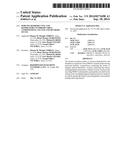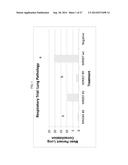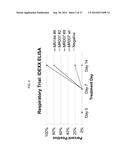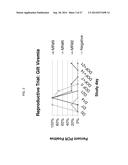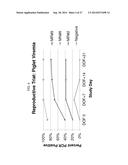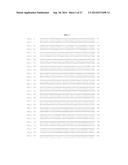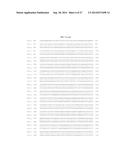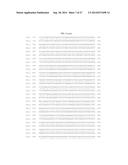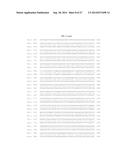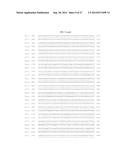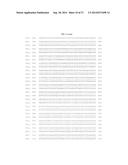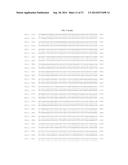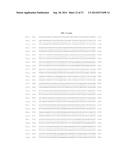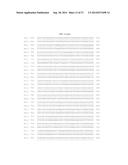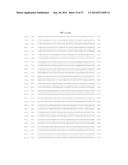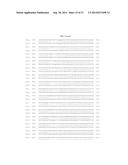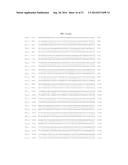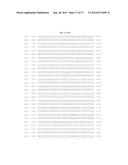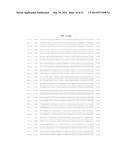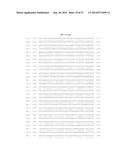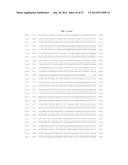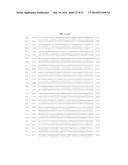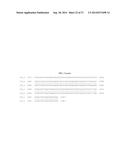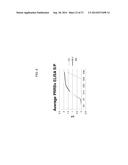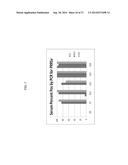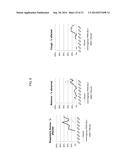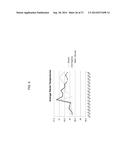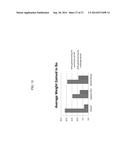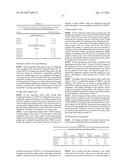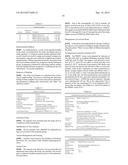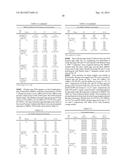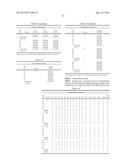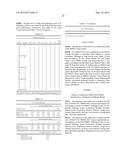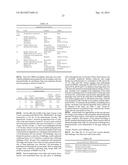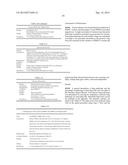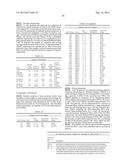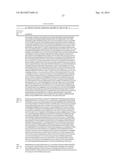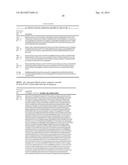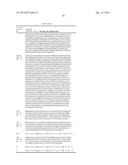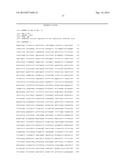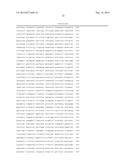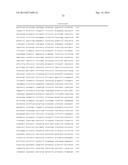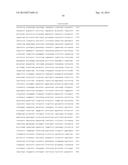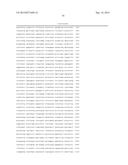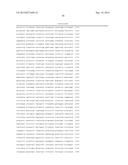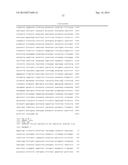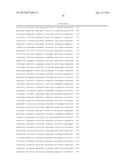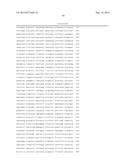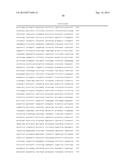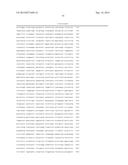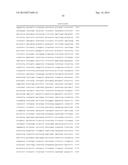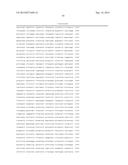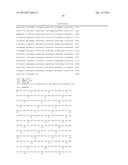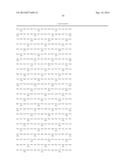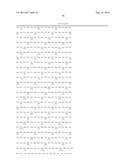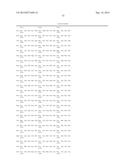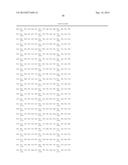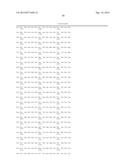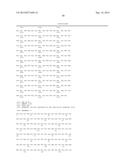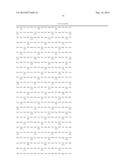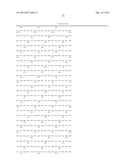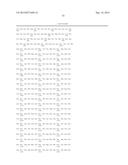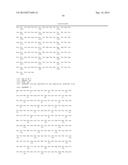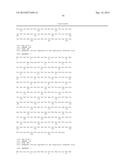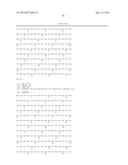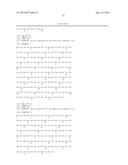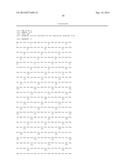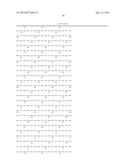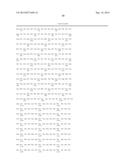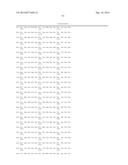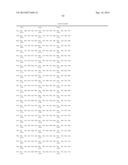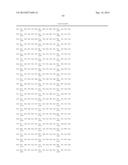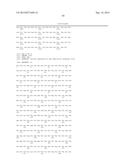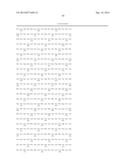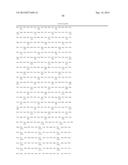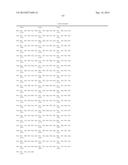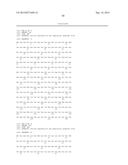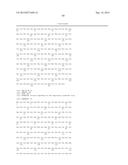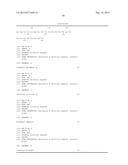Patent application title: PORCINE REPRODUCTIVE AND RESPIRATORY SYNDROME VIRUS, COMPOSITIONS, VACCINE AND METHODS OF USE
Inventors:
Dianna M. Murphy Jordan (Ames, IA, US)
Dianna M. Murphy Jordan (Ames, IA, US)
Brian Thomas Martinson (Duncombe, IA, US)
Michael B. Roof (Ames, IA, US)
Michael B. Roof (Ames, IA, US)
Eric Martin Vaughn (Ames, IA, US)
Eric Martin Vaughn (Ames, IA, US)
Joseph Gilbert Victoria (Ames, IA, US)
Assignees:
BOEHRINGER INGELHEIM VETMEDICA, INC.
IPC8 Class: AA61K3912FI
USPC Class:
4241861
Class name: Antigen, epitope, or other immunospecific immunoeffector (e.g., immunospecific vaccine, immunospecific stimulator of cell-mediated immunity, immunospecific tolerogen, immunospecific immunosuppressor, etc.) amino acid sequence disclosed in whole or in part; or conjugate, complex, or fusion protein or fusion polypeptide including the same disclosed amino acid sequence derived from virus
Publication date: 2014-09-18
Patent application number: 20140271698
Abstract:
The present invention relates to Porcine Reproductive and Respiratory
Syndrome Virus (PRRSV) mutant strains having increased stability;
compositions containing the strains or antigens derived therefrom;
vaccines containing the strains, including killed, attenuated or subunit
vaccines; nucleic acids encoding PRRSV polypeptides, polypeptides encoded
by the nucleic acids, including antigenic fragments thereof; antibodies
which specifically bind to said polypeptides, and methods making and
using thereof.Claims:
1. An immunogenic composition of Porcine Reproductive and Respiratory
Syndrome Virus (PRRSV), comprising at least one of a) a composition
comprising a polynucleotide which is i) a polynucleotide of SEQ ID NO:1
(preattenuated Wetzel p3) or ii) a polynucleotide of SEQ ID NO:2
(attenuated Wetzel p41); b) an immunogenic fragment of a polynucleotide
of SEQ ID NO:1 or SEQ ID NO:2; c) a polypeptide selected from the group
consisting of i) SEQ ID NO:3 (ORF1a protein of Wetzel p3) ii) SEQ ID NO:4
(ORF1b protein of Wetzel p3), iii) SEQ ID NO:5 (GP2 protein of Wetzel
p3), iv) SEQ ID NO:6 (GP3 protein of Wetzel p3), v) SEQ ID NO:7 (GP4
protein of Wetzel p3 and of Wetzel p41), vi) SEQ ID NO:8 (GP5 protein of
Wetzel p3), vii) SEQ ID NO:9 (M protein of Wetzel p3 and of Wetzel p41),
viii) SEQ ID NO:10 (N protein of Wetzel p3 and of Wetzel p41), ix) SEQ ID
NO:11 (ORF1a protein of Wetzel p41), x) SEQ ID NO:12 (ORF1b protein of
Wetzel p41), xi) SEQ ID NO:13 (GP2 protein of Wetzel p41), xii) SEQ ID
NO:14 (GP3 protein of Wetzel p41), and xiii) SEQ ID NO:15 (GP5 protein of
Wetzel p41); or d) an immunogenic fragment of a polypeptide of SEQ ID
NOs: 3-15.
2. An isolated polynucleotide, comprising a polynucleotide a) having the nucleic acid sequence of SEQ ID NO:1 (preattenuated Wetzel p3) or SEQ ID NO:2 (attenuated Wetzel p41); b) having a nucleic acid sequence that encodes a polypeptide of SEQ ID NO:3, SEQ ID NO:4, SEQ ID NO:5, SEQ ID NO:6, SEQ ID NO:7, SEQ ID NO:8, SEQ ID NO:9, SEQ ID NO:10, SEQ ID NO:11, SEQ ID NO:12, SEQ ID NO:13, SEQ ID NO:14 or SEQ ID NO:15; c) having a nucleic acid sequence 95% identical to SEQ ID NO:1 or SEQ ID NO:2, and which encodes a polypeptide having a biological or immunologically-effective activity of a polypeptide of SEQ ID NO:3, SEQ ID NO:4, SEQ ID NO:5, SEQ ID NO:6, SEQ ID NO:7, SEQ ID NO:8, SEQ ID NO:9, SEQ ID NO:10, SEQ ID NO:11, SEQ ID NO:12, SEQ ID NO:13, SEQ ID NO:14 or SEQ ID NO:15; d) that is a fragment of the nucleic acid sequence of SEQ ID NO:1 or SEQ ID NO:2, comprising at least 30 contiguous nucleotide sequences of SEQ ID NO:1, or e) that is a fragment of the nucleic acid sequence of SEQ ID NO:1 or SEQ ID NO:2, comprising at least 30 contiguous nucleotide sequences of SEQ ID NO:1 or SEQ ID NO:2, and which encode an immunologically-effective activity of an amino acid sequence of SEQ ID NO:3, SEQ ID NO:4, SEQ ID NO:5, SEQ ID NO:6, SEQ ID NO:7, SEQ ID NO:8, SEQ ID NO:9, SEQ ID NO:10, SEQ ID NO:11, SEQ ID NO:12, SEQ ID NO:13, SEQ ID NO:14 or SEQ ID NO:15.
3. An isolated polypeptide, comprising a polypeptide a) having the amino acid sequence of SEQ ID NO:3, SEQ ID NO:4, SEQ ID NO:5, SEQ ID NO:6, SEQ ID NO:7, SEQ ID NO:8, SEQ ID NO:9, SEQ ID NO:10, SEQ ID NO:11, SEQ ID NO:12, SEQ ID NO:13, SEQ ID NO:14 or SEQ ID NO:15; b) having an amino acid sequence 95% identical to SEQ ID NO:3, SEQ ID NO:4, SEQ ID NO:5, SEQ ID NO:6, SEQ ID NO:7, SEQ ID NO:8, SEQ ID NO:9, SEQ ID NO:10, SEQ ID NO:11, SEQ ID NO:12, SEQ ID NO:13, SEQ ID NO:14 or SEQ ID NO:15 and having a biological or immunologically-effective activity of a polypeptide encoded by SEQ ID NO:3, SEQ ID NO:4, SEQ ID NO:5, SEQ ID NO:6, SEQ ID NO:7, SEQ ID NO:8, SEQ ID NO:9, SEQ ID NO:10, SEQ ID NO:11, SEQ ID NO:12, SEQ ID NO:13, SEQ ID NO:14 or SEQ ID NO:15, respectively; c) that is a fragment of the amino acid sequence of SEQ ID NO:3, SEQ ID NO:4, SEQ ID NO:5, SEQ ID NO:6, SEQ ID NO:7, SEQ ID NO:8, SEQ ID NO:9, SEQ ID NO:10, SEQ ID NO:11, SEQ ID NO:12, SEQ ID NO:13, SEQ ID NO:14 or SEQ ID NO:15, comprising at least 15 contiguous amino acids of SEQ ID NO:3, SEQ ID NO:4, SEQ ID NO:5, SEQ ID NO:6, SEQ ID NO:7, SEQ ID NO:8, SEQ ID NO:9, SEQ ID NO:10, SEQ ID NO:11, SEQ ID NO:12, SEQ ID NO:13, SEQ ID NO:14 or SEQ ID NO:15, respectively; d) that is a fragment of the amino acid sequence of SEQ ID NO:3, SEQ ID NO:4, SEQ ID NO:5, SEQ ID NO:6, SEQ ID NO:7, SEQ ID NO:8, SEQ ID NO:9, SEQ ID NO:10, SEQ ID NO:11, SEQ ID NO:12, SEQ ID NO:13, SEQ ID NO:14 or SEQ ID NO:15, comprising at least 15 contiguous amino acids of SEQ ID NO:3, SEQ ID NO:4, SEQ ID NO:5, SEQ ID NO:6, SEQ ID NO:7, SEQ ID NO:8, SEQ ID NO:9, SEQ ID NO:10, SEQ ID NO:11, SEQ ID NO:12, SEQ ID NO:13, SEQ ID NO:14 or SEQ ID NO:15, respectively, and having an immunologically-effective activity; or e) that is a protein fragment that is encoded by a polynucleotide that comprises at least 15 consecutive nucleotides included in the sequences of SEQ ID NO:1 or SEQ ID NO:2.
4. An isolated Porcine Reproductive and Respiratory Syndrome Virus (PRRSV), comprising a) a nucleic acid sequence of SEQ ID NO:1 or SEQ ID NO:2, or b) a nucleic acid sequence 95% identical to SEQ ID NO:1 or SEQ ID NO:2, which encodes a polypeptide having a biological or immunologically-effective activity of a polypeptide of SEQ ID NO:3, SEQ ID NO:4, SEQ ID NO:5, SEQ ID NO:6, SEQ ID NO:7, SEQ ID NO:8, SEQ ID NO:9, SEQ ID NO:10, SEQ ID NO:11, SEQ ID NO:12, SEQ ID NO:13, SEQ ID NO:14 or SEQ ID NO:15.
5. The PRRSV of claim 4, comprising an attenuated, non-virulent form of a PRRSV.
6. A vaccine for treating or preventing an infection by a virulent PRRSV, comprising a killed or attenuated form of a PRRSV of claim 4.
7. A vaccine for treating or preventing an infection by a virulent PRRSV, comprising a subunit of a killed or attenuated form of a PRRSV of claim 4.
8. An immunogenic preparation comprising an immunologically-effective amount of a polypeptide of claim 3, and a pharmaceutically- or veterinary-acceptable carrier, excipient or diluent.
9. A method of generating an immune response in a mammal, comprising administering an immunologically-effective amount of a PRRSV of claim 4.
10. A method of generating an immune response in a mammal, comprising administering an immunologically-effective amount of a polypeptide of claim 3.
11. A vaccine for treating or preventing an infection by a virulent PRRSV, comprising a killed or attenuated form of a PRRSV of claim 4.
12. A subunit vaccine for treating or preventing an infection by a virulent PRRSV, comprising a polypeptide of claim 3.
13. An immunogenic preparation comprising an immunologically-effective amount of a polypeptide of claim 3, and a pharmaceutically- or veterinary-acceptable carrier, excipient or diluent.
14. A method of generating an immune response in a mammal, comprising administering an immunologically-effective amount of a vaccine of claim 11.
15. A method of claim 14, wherein the mammal is a swine.
16. A method of claim 14, wherein the vaccine provides protective immunity to a disease caused by PRRSV infection.
17. An isolated antibody that specifically binds to a PRRSV polypeptide encoded by a polynucleotide having a sequence of SEQ ID NO:1 or SEQ ID NO:2, said polypeptide having an amino acid sequence of SEQ ID NO:3, SEQ ID NO:4, SEQ ID NO:5, SEQ ID NO:6, SEQ ID NO:7, SEQ ID NO:8, SEQ ID NO:9, SEQ ID NO:10, SEQ ID NO:11, SEQ ID NO:12, SEQ ID NO:13, SEQ ID NO:14 or SEQ ID NO:15, and wherein said antibody does not bind to a polypeptide encoded by a different strain of PRRSV.
18. A vector or plasmid that comprises a polynucleotide of claim 2.
19. A host cell comprising a vector of claim 18.
20. A hybridoma that expresses an antibody of claim 17.
Description:
SEQUENCE LISTING
[0001] This application contains a sequence listing which has been submitted electronically in ASCII format in accordance with 37 C.F.R. 1.821-1.825. Said ASCII copy, created on Jan. 29, 2014, is named 10-0145-US-2-SEQ.txt and is 124,818 bytes in size. The sequence listing accompanying this application is hereby incorporated by reference in its entirety.
BACKGROUND OF THE INVENTION
[0002] A. Field of the Invention
[0003] The present invention relates to Porcine Reproductive and Respiratory Syndrome Virus (PRRSV) compositions and associated methods.
[0004] B. Description of the Related Art
[0005] The swine industry continues to experience major economic losses due to PRRSV despite major efforts aimed at pathogen elimination and control strategies. PRRSV is an enveloped single-strand positive sense RNA virus classified under the order Nidovirales, family Arteriviridae and genus Arterivirus. The virus causes Porcine Reproductive and Respiratory Syndrome (PRRS), and has also been known as the Mystery Swine Disease and SIR. The symptoms of PRRS include reproductive failure in breeding females and respiratory disease in growing swine. The reproductive failure is associated with mid to late term abortions, increased numbers of mummified fetuses and weak born piglets and fewer healthy born piglets. PRRSV is also characterized by anorexia, fever and respiratory disease typically seen microscopically as interstitial pneumonia. Thus infection with PRRSV can have a significant negative effect on the productivity of a herd. It has been estimated that PRRSV costs the US swine industry around 560 million U.S. dollars a year. Compounding the situation is the fact that PRRSV is endemic in most swine producing countries and has a similar economic effect elsewhere.
[0006] Current control strategies to prevent the spread of the virus within and between herds include: the proper management of breeding animals, removal of infected individuals, strict biosecurity measures including air filtration systems, serum inoculation, and the use of vaccines. Both inactivated and modified (attenuated) live vaccines are commercially available. Inactivated vaccines produce a high level of safety but are generally considered as ineffective or as conveying a very limited degree of efficacy. Attenuated live vaccines have been widely used to reduce the transmission and clinical disease cause by wild type PRRS viruses. While modified live vaccine efficacy may vary against heterologous isolates, they remain the best vaccination option available to combat the disease.
[0007] Attenuated vaccines do carry some risk as several instances of suspected reversion to virulence have been reported. Therefore, new vaccines need to be capable of providing sufficient immunological protection to reduce transmission and clinical disease while also exhibiting a high degree of safety and resistance to genetic changes.
[0008] To increase genetic stability, viruses with cell passaged derived deletions in the nsp2 (nonstructural protein 2) region have been developed. The nsp2 protein is the largest PRRSV protein, is highly antigenic and possesses the highest genetic diversity of the PRRSV genome. The value of deletion mutants stems from the increased stability they confer. Shorter sequences result in less potential for reversion to virulence. Deleted portions would require insertions to revert back to its original state which is much less likely to occur than a simple substitution back to the original virulent form.
SUMMARY OF THE INVENTION
[0009] The present invention provides immunogenic compositions, vaccines, and related methods that overcome deficiencies in the art. The compositions and methods provide, inter alia, immunogenic deletion mutants of PRRSV which are genetically stable, from which vaccines, including attenuated whole virus vaccines and polypeptide subunit vaccines can be made, wherein said vaccines confer immunity from, protective resistance to, reduce transmission of and/or reduce clinical disease caused by infections with PRRSV.
[0010] Exemplary immunogenic compositions of the invention comprise any one of the polypeptide sequences encoded by the nucleotide sequence of SEQ ID NO: 1 (pre-attenuated Wetzel isolate of a PRRSV) and SEQ ID NO: 2 (an attenuated form of the Wetzel isolate), or fragments thereof, in particular fragments that are biologically or functionally, e.g., immunologically, active, with similar immunogenic specificity as compared to the full length PRRSV protein from which it is derived. Preferably those polypeptides are immunogenic and induce an immunoreactive response to the PRRS virus in animals to which the polypeptides are administered, which response is immunoprotective to PRRSV.
[0011] In another aspect the invention provides nucleic acid sequences, including both DNA and RNA sequences, that encode one or more polypeptides, antibody constructs, or antibody conjugates. The gene sequences coding for the polypeptides comprise a nucleic acid sequence that is at least 95%, 90%, 85%, or even 80% homologous to and/or identical with the nucleic acid sequence of Wetzel p3 ORF1a (SEQ ID NO:3), Wetzel p3 ORF1b (SEQ ID NO:4), Wetzel p3 GP2 (SEQ ID NO:5), Wetzel p3 GP3 (SEQ ID NO:6), Wetzel p3 GP4 (SEQ ID NO:7), Wetzel p3 GP5 (SEQ ID NO:8), Wetzel p3 M (SEQ ID NO:9), Wetzel p3 N (SEQ ID NO:10), Wetzel p41 ORF1a (SEQ ID NO:11), Wetzel p41 ORF1b (SEQ ID NO:12), Wetzel p41 GP2 (SEQ ID NO:13), Wetzel p41 GP3 (SEQ ID NO:14), Wetzel p41 GP4 (SEQ ID NO:7--identical to the p3 GP4 sequence), Wetzel p41 GP5 (SEQ ID NO:15), Wetzel p3 M (SEQ ID NO:9--identical to the p3 M sequence) and Wetzel p3 N (SEQ ID NO:10--identical to the p3 N sequence), or fragments thereof that are immunoreactive to or immunogenic for Porcine Reproductive and Respiratory Syndrome Virus (PRRSV). Complementary nucleic acid sequences to the above sequences are a further aspect of the invention.
[0012] Moreover a polypeptide of the invention as used herein includes but is not limited to a polypeptide that comprises:
[0013] i) a polypeptide comprising an amino acid sequence of SEQ ID NO:3, SEQ ID NO:4, SEQ ID NO:5, SEQ ID NO:6, SEQ ID NO:7, SEQ ID NO:8, SEQ ID NO:9, SEQ ID NO:10, SEQ ID NO:11, SEQ ID NO:12, SEQ ID NO:13, SEQ ID NO:14 or SEQ ID NO:15;
[0014] ii) a polypeptide that is at least 95% homologous to and/or identical with a polypeptide of i);
[0015] iii) a fragment of the polypeptides of i) and/or ii);
[0016] iv) a polypeptide of i) or ii), or a fragment of iii) comprising an amino acid motif or immunogenic epitope of any one of the polypeptides of i);
[0017] v) a fragment of iii) or iv) comprising at least 5, preferably 8, more preferably 10, even more preferably 15 or more contiguous amino acids included in the sequences of i);
[0018] vi) a polypeptide that is encoded by a polynucleotide comprising the sequence of SEQ ID NO:1 (pre-attenuated Wetzel) or SEQ ID NO:2 (attenuated Wetzel);
[0019] vii) a polypeptide that is encoded by a polynucleotide that is at least 95% homologous to or identical with polynucleotide of vi); or
[0020] viii) a protein fragment that is encoded by a polynucleotide that comprises at least 15, preferably 24, more preferably 30, even more preferably 45 contiguous nucleotides or more, included in the sequences of SEQ ID NO:1 or SEQ ID NO:2.
[0021] Immunogenic compositions of the invention which comprise at least one or more PRRSV polypeptides as defined herein, killed or attenuated virus, or DNA- or RNA-based vaccines, e.g., encoding such immunogens, may further comprise a physiologically-acceptable vehicle such as a pharmaceutically or veterinarily acceptable carrier, adjuvant, or combination thereof.
[0022] Any of the PRRSV polypeptides provided herewith or any immunogenic compositions comprising one or more of these PRRSV polypeptides provided herewith can be used as a medicament, preferably as a vaccine or immunogenic composition, most preferably for the prophylaxis or treatment of a subject against a PRRS infection.
[0023] Those of skill in the art will understand that the compositions used herein may incorporate known injectable, physiologically acceptable sterile solutions. For preparing a ready-to-use solution for parenteral injection or infusion, aqueous isotonic solutions, e.g. saline or plasma protein solutions, are readily available. In addition, the immunogenic and vaccine compositions of the present invention can include veterinary-acceptable carriers, diluents, isotonic agents, stabilizers, or adjuvants.
[0024] Methods of the invention include, but are not limited to, a method of provoking an immune response against a PRRSV infection in a subject comprising the step of administering to the subject an immunogenic composition comprising one or more PRRSV polypeptides as defined herein. Preferably, the immune response is provoked against more than one serotype or strain of PRRSV. Compositions of the invention may be used to treat or alternatively to prevent a PRRSV infection. Preferably, such immune response reduces the incidence of or severity of one or more clinical signs associated with or caused by the infection with one or more PRRSV serotypes.
[0025] Herein, suitable subjects and subjects in need to which compositions of the invention may be administered include animals in need of either prophylactic or treatment for a viral, microbial, parasitic, protozoan, bacterial, or fungal associated infection, disease, or condition. Animals in which the immune response is stimulated by use of compositions or methods of the invention include livestock, such as swine, bovines, poultry (e.g. chickens, ducks, geese, or turkeys) goats, and sheep, and domestic animals, such as mice, rabbits, dogs, cats, and horses. Preferred animals include porcines.
[0026] The invention also provides a method of reducing the incidence of or severity of one or more clinical signs associated with or caused by PRRSV infection, comprising the step of administering an immunogenic composition of the invention that comprises one or more PRRSV peptides as provided herewith and preferably a carrier molecule, such that the incidence of or the severity of a clinical sign of the PRRSV infection is reduced by at least 10%, preferably at least 20%, even more preferred at least 30%, even more preferred at least 50%, even more preferred at least 70%, most preferred at least 100% relative to a subject that has not received the immunogenic composition as provided herewith. Such clinical signs include reproductive failure in breeding females and respiratory disease in growing swine. The reproductive failure is associated with mid to late term abortions, increased numbers of mummified fetuses and weak born piglets and fewer health born piglets. PRRSV is also characterized by anorexia, fever and respiratory disease typically seen microscopically as interstitial pneumonia.
[0027] According to a further aspect, the present invention also relates to a method for the prophylaxis of a PRRSV infection, wherein said PRRSV infection may be caused by serotype PRRSV or any other serotype of PRRSV, comprising the step of administering an immunogenic composition of the invention that comprises one or more PRRSV peptides as provided herewith.
[0028] The invention also provides a method of preparing any of the immunogenic compositions provided herewith that method comprises mixing one or more PRRSV peptides as provided herewith with a carrier molecule, preferably such that the one or more PRRSV peptides and carrier molecule are covalently coupled or conjugated to one another. Such conjugates may be multivalent or univalent. Multivalent compositions or vaccines include an immuno-conjugation of multiple PRRSV peptides with a carrier molecule. In a further aspect, the invention provides a method of producing one or more PRRSSSV peptides that method comprises transforming a host cell, preferably a prokaryotic cell such as E. coli with a nucleic acid molecule that codes for any of the PRRSV peptides as provided herewith. Alternatively, the host cell may be a eukaryotic cell such as an animal cell, protist cell, plant cell, or fungal cell. Preferably the eukaryotic cell is a mammalian cell such as CHO, BHK or COS, or a fungal cell such as Saccharomyces cerevisiae, or an insect cell such as Sf9.
[0029] Another aspect of the invention provides a method of producing one or more PRRSV peptides that induce an immune response against at least one serotype of PRRSV, and more preferably two or more serotypes of PRRSV. This comprises culturing a transformed expression vector coding for and expressing one or more PRRSV peptides disclosed herein. The expressed proteins are either retained by the expression organism or secreted into the culture medium. Expression is conducted under conditions sufficient to produce a PRRSV peptide a capable of inducing an immune response to PRRSV.
[0030] A still further aspect of the invention is compositions comprising and methods of making and administering DNA- and/or RNA-based vaccines, including nucleic acids (or polynucleotides) that encode for immunity-conferring polypeptides (immunogenic polypeptides") or wherein the nucleic acid is itself the immunogen. Methods of making and using such DNA- and/or RNA-based vaccines are well known in the art.
[0031] Methods of making compositions of the invention may further comprise admixing the conjugate of one or more PRRSV antigens and a carrier molecule with a physiologically-acceptable vehicle such as a pharmaceutically- or veterinary-acceptable carrier, adjuvant, or combination thereof. Those of skill in the art will recognize that the choice of vehicle, adjuvant, or combination will be determined by the delivery route, personal preference, and animal species among others.
[0032] In another aspect, the invention provides a method of diagnosing a PRRSV infection in a subject. That method comprises providing one or more PRRSV peptides; contacting the one or more PRRSV peptides with a sample obtained from the subject; and identifying the subject as having a PRRSV infection if an antibody capable of binding the one or more PRRSV peptides is detected in the sample.
[0033] In another respect, the invention provides a method of ascertaining that a subject has been previously exposed to a PRRSV infection and is able to express an immune response to PRRSV. That method comprises providing one or more PRRSV peptides; contacting the one or more PRRSV peptides with a sample obtained from the subject; and identifying the subject as having a PRRSV infection if an antibody capable of binding the one or more PRRSV peptides is detected in the sample.
[0034] The invention also provides kits that comprise an immunogenic composition that comprises one or more PRRSV peptides, preferably together with a carrier molecule; a container for packaging the immunogenic composition; a set of printed instructions; and a dispenser capable of administering the immunogenic composition to an animal. Optionally, the one or more PRRSV peptides and the carrier molecule may be packaged as a conjugate or as separate compounds. When supplied separately, a means of conjugating the one or more PRRSV peptides and carrier molecule, as well as appropriate printed instructions, is also supplied.
[0035] The invention also provides kits for vaccinating an animal comprising a set of printed instructions; a dispenser capable of administering the immunogenic composition provided herewith comprising one or more PRRSV peptides to an animal; and wherein at least one of PRRSV peptides effectively immunizes the animal against at least one disease associated with PRRSV infection. Preferably, the one or more PRRSV peptides are selected from those provided herewith. Kits of the invention may further comprise a veterinary acceptable carrier, adjuvant, or combination thereof.
[0036] The dispenser in a kit of the invention is capable of dispensing its contents as droplets; and the immunogenic composition comprises the PRRSV peptides as provided herewith included in the kit is capable of reducing the severity of at least one clinical sign of a PRRSV infection when administered intranasally, orally, intradermally, or intramuscularly to an animal. Preferably, the severity of a clinical sign is reduced by at least 10% preferably by at least 20%, even more preferred by at least 30%, even more preferred by at least 50%, even more preferred by at least 70%, most preferred by at least 100% as compared to an untreated, infected animal.
[0037] Methods for the treatment or prophylaxis of infections caused by PRRSV are also disclosed. The method comprises administering an effective amount of the immunogenic composition of the present invention to a subject, wherein said treatment or prophylaxis is selected from the group consisting of reducing signs of PRRSV infection, reducing the severity of or incidence of clinical signs of PRRSV infection, reducing the mortality of subjects from PRRSV infection, and combinations thereof.
[0038] Compositions of the invention further comprise a veterinarily acceptable carrier, adjuvant, or combination thereof. Such compositions may be used as a vaccine and comprise an attenuated vaccine, an inactivated vaccine, or combinations thereof. Such vaccines elicit a protective immunological response against at least one disease associated with PRRSV.
[0039] Those of skill in the art will understand that the compositions used herein may incorporate known injectable, physiologically acceptable sterile solutions. For preparing a ready-to-use solution for parenteral injection or infusion, aqueous isotonic solutions, e.g. saline or plasma protein solutions, are readily available. In addition, the immunogenic and vaccine compositions of the present invention can include pharmaceutical- or veterinary-acceptable carriers, diluents, isotonic agents, stabilizers, or adjuvants.
[0040] Methods of the invention may also comprise admixing a composition of the invention with a veterinarily acceptable carrier, adjuvant, or combination thereof. Those of skill in the art will recognize that the choice of carrier, adjuvant, or combination will be determined by the delivery route, personal preference, and animal species among others.
[0041] The invention also provides a method of reducing the severity of a PRRSV infection in an animal comprising administrating to the animal a composition that comprises an isolate from a viral culture selected from the group consisting of a non-virulent, killed or attenuated immunologically-effective antigen of SEQ ID NO:3, SEQ ID NO:4, SEQ ID NO:5, SEQ ID NO:6, SEQ ID NO:7, SEQ ID NO:8, SEQ ID NO:9, SEQ ID NO:10, SEQ ID NO:11, SEQ ID NO:12, SEQ ID NO:13, SEQ ID NO:14 and SEQ ID NO:15, including a fragment thereof, and/or combinations thereof.
[0042] Methods for the treatment or prophylaxis of infections caused by PRRSV are also disclosed. The method comprises administering an effective amount of the immunogenic composition of the present invention to an animal, wherein said treatment or prophylaxis is selected from the group consisting of reducing signs of PRRSV infection, reducing the severity of or incidence of clinical signs of PRRSV infection, reducing the mortality of animals from PRRSV infection, and combinations thereof.
[0043] Preferred routes of administration include intranasal, oral, intradermal, and intramuscular. Administration in drinking water, most preferably in a single dose, is preferred. The skilled artisan will recognize that compositions of the invention may also be administered in one or two or more doses, as well as, by other routes of administration. For example, such other routes include subcutaneously, intracutaneously, intravenously, intravascularly, intraarterially, intraperitoneally, intrathecally, intratracheally, intracutaneously, intracardially, intralobally, intramedullarly, intrapulmonarily, or intravaginally. Depending on the desired duration and effectiveness of the treatment, the compositions according to the invention may be administered once or several times, also intermittently, for instance on a daily basis for several days, weeks or months and in different dosages.
[0044] The invention also provides kits for vaccinating an animal comprising a set of printed instructions; a dispenser capable of administering a vaccine to an animal; and at least one isolate from a viral culture of a PRRSV or immunogenic composition that effectively immunizes the animal against at least one disease associated with PRRSV. Kits of the invention may further comprise a veterinarily acceptable carrier, adjuvant, or combination thereof.
[0045] The dispenser in a kit of the invention is capable of dispensing its contents as droplets; and the isolate included in the kit is capable of reducing the severity of at least one clinical sign of a PRRSV infection when administered intranasally, orally, intradermally, or intramuscularly to an animal. In some kits, the isolate is also capable of reducing the severity of at least one clinical sign of a PRRSV infection. Preferably, the severity of a clinical sign is reduced by at least 10% as compared to an untreated, infected animal.
[0046] Other objects, features and advantages of the present invention will become apparent from the following detailed description. It should be understood, however, that the detailed description and the specific examples, while indicating preferred embodiments of the invention, are given by way of illustration only, since various changes and modifications within the spirit and scope of the invention will become apparent to those skilled in the art from this detailed description.
BRIEF DESCRIPTION OF THE DRAWINGS
[0047] The following drawings form part of the present specification and are included to further demonstrate certain aspects of the present invention. The invention may be better understood by reference to one or more of these drawings in combination with the detailed description of specific embodiments presented herein.
[0048] FIG. 1 is a chart of the Lung Pathology from the respiratory trial of Example 1. Pig safety study average lung scores as collected on day 14. The letter `a` indicates the average lung score was higher than the negative control group while the letter `b` indicates the scores were lower than the Isolate X wild type group.
[0049] FIG. 2 is a graph of the IDEXX ELISA from the respiratory trial of Example 1. Samples are considered positive for PRRSV specific antibodies if (S/P) ratio was at least 0.4.
[0050] FIG. 3 is a graph of the Gilt Viremia of the reproductive trial as determined by RT-PCR via the AgPath-ID® NA and EU PRRSV Multiplex kit with relatively short period of viremia detected of Example 1.
[0051] FIG. 4 is a graph of the piglet viremia as determined by RT-PCR via the AgPath-ID® NA and EU PRRSV Multiplex kit. Variably levels of piglet viremia at birth followed by horizontal transmission within litters from the reproductive trial of Example 1.
[0052] FIG. 5 is a comparison of the nucleotide sequences (DNA equivalent of the RNA viral sequences) of SEQ ID NO: 1 (pre-attenuated Wetzel p3) and SEQ ID NO: 2 (attenuated Wetzel p41).
[0053] FIG. 6 is a graph of the average PRRSV ELISA S/P from Example 3.
[0054] FIG. 7 is a graph showing percent positive by PCR for PPRSV from Example 3.
[0055] FIG. 8 shows graphs of respiratory scores, behavior scores and cough scores by percentage affected from Example 3.
[0056] FIG. 9 shows average rectal temperatures from Example 3.
[0057] FIG. 10 shows average weight gain (in pounds) from Example 3.
DETAILED DESCRIPTION
[0058] The invention provides attenuated PRRSV strains having enhanced stability. Specifically polypeptides of SEQ ID NO:3, SEQ ID NO:4, SEQ ID NO:5, SEQ ID NO:6, SEQ ID NO:7, SEQ ID NO:8, SEQ ID NO:9, SEQ ID NO:10, SEQ ID NO:11, SEQ ID NO:12, SEQ ID NO:13, SEQ ID NO:14 or SEQ ID NO:15, and fragments thereof (including but not limited at least 5, preferably 8, more preferably 10, even more preferably 15 contiguous amino acids included in the above described sequences) are disclosed. In addition, polypeptides which are at least 95% homologous to and/or identical with the above-described polypeptides. Further, associated polynucleotides of the above described polypeptides are also disclosed.
[0059] The practice of the present invention will employ, unless otherwise indicated, conventional techniques of molecular biology, microbiology, recombinant DNA technology, protein chemistry and immunology, which are within the skill of the art. Such techniques are explained fully in the literature. See, e.g., Sambrook, Fritsch & Maniatis, Molecular Cloning: A Laboratory Manual, Vols. I, II and III, Second Edition (1989); DNA Cloning, Vols. I and II (D. N. Glover ed. 1985); Oligonucleotide Synthesis (M. J. Gait ed. 1984); Nucleic Acid Hybridization (B. D. Hames & S. J. Higgins eds. 1984); Animal Cell Culture (R. K. Freshney ed. 1986); Immobilized Cells and Enzymes (IRL press, 1986); Perbal, B., A Practical Guide to Molecular Cloning (1984); the series, Methods In Enzymology (S. Colowick and N. Kaplan eds., Academic Press, Inc.); Protein purification methods--a practical approach (E. L. V. Harris and S. Angal, eds., IRL Press at Oxford University Press); and Handbook of Experimental Immunology, Vols. I-IV (D. M. Weir and C. C. Blackwell eds., 1986, Blackwell Scientific Publications).
[0060] Before describing the present invention in detail, it is to be understood that this invention is not limited to particular DNA, polypeptide sequences or process parameters as such may, of course, vary. It is also to be understood that the terminology used herein is for the purpose of describing particular embodiments of the invention only, and is not intended to be limiting. It must be noted that, as used in this specification and the appended claims, the singular forms "a", "an" and "the" include plural referents unless the content clearly dictates otherwise. Thus, for example, reference to "an antigen" includes a mixture of two or more antigens; reference to "an excipient" includes mixtures of two or more excipients, and the like.
A. DEFINITIONS
[0061] Unless defined otherwise, all technical and scientific terms used herein have the same meaning as is commonly understood by one of skill in the art to which this invention belongs at the time of filing. The meaning and scope of terms should be clear; however, in the event of any latent ambiguity, definitions provided herein take precedent over any dictionary or extrinsic definition. Further, unless otherwise required by context, singular terms shall include pluralities and plural terms shall include the singular. Herein, the use of "or" means "and/or" unless stated otherwise. Furthermore, the use of the term "including", as well as other forms such as "includes" and "included" is not limiting. All patents and publications referred to herein are incorporated by reference herein.
[0062] "Protection against disease", "protective immunity", "functional immunity" and similar phrases, means a response against a disease or condition generated by administration of one or more therapeutic compositions of the invention, or a combination thereof, that results in fewer deleterious effects than would be expected in a non-immunized subject that has been exposed to disease or infection. That is, the severity of the deleterious effects of the infection is lessened in a vaccinated subject. Infection may be reduced, slowed, or possibly fully prevented, in a vaccinated subject. Herein, where complete prevention of infection is meant, it is specifically stated. If complete prevention is not stated then the term includes partial prevention.
[0063] Herein, "reduction of the incidence and/or severity of clinical signs" or "reduction of clinical symptoms" means, but is not limited to, reducing the number of infected subjects in a group, reducing or eliminating the number of subjects exhibiting clinical signs of infection, or reducing the severity of any clinical signs that are present in one or more subjects, in comparison to wild-type infection. For example, it should refer to any reduction of pathogen load, pathogen shedding, reduction in pathogen transmission, or reduction of any clinical sign symptomatic of malaria. Preferably these clinical signs are reduced in one or more subjects receiving the therapeutic composition of the present invention by at least 10% in comparison to subjects not receiving the composition and that become infected. More preferably clinical signs are reduced in subjects receiving a composition of the present invention by at least 20%, preferably by at least 30%, more preferably by at least 40%, and even more preferably by at least 50%.
[0064] The term "increased protection" herein means, but is not limited to, a statistically significant reduction of one or more clinical symptoms which are associated with infection by an infectious agent, preferably a PRRSV, respectively, in a vaccinated group of subjects vs. a non-vaccinated control group of subjects. The term "statistically significant reduction of clinical symptoms" means, but is not limited to, the frequency in the incidence of at least one clinical symptom in the vaccinated group of subjects is at least 10%, preferably at least 20%, more preferably at least 30%, even more preferably at least 50%, and even more preferably at least 70% lower than in the non-vaccinated control group after the challenge the infectious agent.
[0065] "Long-lasting protection" shall refer to "improved efficacy" that persists for at least 3 weeks, but more preferably at least 3 months, still more preferably at least 6 months. In the case of livestock, it is most preferred that the long lasting protection shall persist until the average age at which animals are marketed for meat.
[0066] An "immunogenic or immunological composition" or "vaccine" refers to a composition of matter that comprises at least one PRRSV, or immunogenic portion thereof, that elicits an immunological response in the host of a cellular or antibody-mediated immune response to the composition. In a preferred embodiment of the present invention, an immunogenic composition induces an immune response and, more preferably, confers protective immunity against one or more of the clinical signs of a PRRSV infection. The term thus encompasses both subunit immunogenic compositions, as described below, as well as compositions containing whole killed, or attenuated, and/or inactivated PRRSV.
[0067] The term "subunit immunogenic composition" or "subunit vaccine" as used herein refers to a composition containing at least one immunogenic polypeptide or antigen, but not all antigens, derived from or homologous to an antigen from PRRSV. Such a composition is substantially free of intact PRRSV. Thus, a "subunit immunogenic composition" or "subunit vaccine" is prepared from at least partially purified or fractionated (preferably substantially purified) immunogenic polypeptides from PRRSV, or recombinant analogs thereof. A subunit immunogenic composition can comprise the subunit antigen or antigens of interest substantially free of other antigens or polypeptides from PRRSV, or in fractionated form. A preferred immunogenic subunit composition comprises PRRSV proteins or fragments thereof, e.g., those which are incorporated into the envelope of the virus, e.g., gp2, gp4, gp5 and/or matrix ("M") proteins. Also included are subunit immunogenic compositions which are modified analogs of the PRRSV virus, wherein the amino acid sequences of the antigen have been modified to enhance stability or immunogenicity.
[0068] An "immunogenic" PRRSV polypeptide, or "antigen," as used herein refer to a polypeptide or protein that elicits an immunological response as described herein. An "immunogenic" PRRSV protein or polypeptide includes the full-length sequence of any of the PPRSV identified herein or analogs or immunogenic fragments thereof. The term "immunogenic fragment" or "immunogenic portion" refers to a fragment or truncated and/or substituted form of a PRRSV that includes one or more epitopes and thus elicits the immunological response described herein. In general, such truncated and/or substituted forms, or fragments will comprise at least six contiguous amino acids from the full-length PRRSV protein. More preferably, the truncated or substituted forms, or fragments will have at least 10, more preferably at least 15, and still more preferably at least 19 or more contiguous amino acids from the full-length PRRSV protein. Analogs include modifications to the antigen which confer enhanced properties to the molecule such as stability or immunogenicity.
[0069] The term "epitope" means a segment or fragment of a composition of matter, e.g., a protein or polypeptide, which is recognized by the immune system, specifically by antibodies, B cells, or T cells. In the present invention, the epitope is generally a fragment or fragments of a polypeptide sequence of a viral protein.
[0070] Such fragments can be identified using any number of epitope mapping techniques, well known in the art. See, e.g., Epitope Mapping Protocols in Methods in Molecular Biology, Vol. 66 (Glenn E. Morris, Ed., 1996) Humana Press, Totowa, N.J. For example, linear epitopes may be determined by concurrently synthesizing large numbers of peptides on solid supports, the peptides corresponding to portions of the protein molecule, and reacting the peptides with antibodies while the peptides are still attached to the supports. Such techniques are known and described in the art, see e.g., U.S. Pat. No. 4,708,871; Geysen et al. (1984) Proc. Natl. Acad. Sci. USA 81:3998-4002; and Geysen et al. (1986) Molec. Immunol. 23:709-715. Similarly, conformational epitopes are readily identified by determining spatial conformation of amino acids such as by, e.g., x-ray crystallography and two-dimensional nuclear magnetic resonance. See Epitope Mapping Protocols, supra. Synthetic antigens are also included within the definition, for example, polyepitopes, flanking epitopes, and other recombinant or synthetically derived antigens. See, e.g., Bergmann et al. (1993) Eur. J. Immunol. 23:2777-2781; Bergmann et al. (1996), J. Immunol. 157:3242-3249; Suhrbier, A. (1997), Immunol. and Cell Biol. 75:402-408; and Gardner et al., (1998) 12th World AIDS Conference, Geneva, Switzerland, June 28-Jul. 3, 1998. (The teachings and content of which are all incorporated by reference herein.)
[0071] An "immune response" or "immunological response" means, but is not limited to, the development of a cellular and/or antibody-mediated immune response to the composition or vaccine of interest. Usually, an immune or immunological response includes, but is not limited to, one or more of the following effects: the production or activation of antibodies, B cells, helper T cells, suppressor T cells, and/or cytotoxic T cells, directed specifically to an antigen or antigens included in the composition or vaccine of interest. Preferably, the host will display either a therapeutic or a protective immunological (memory) response such that resistance to new infection will be enhanced and/or the clinical severity of the disease reduced. Such protection will be demonstrated by either a reduction in number of symptoms, severity of symptoms, or the lack of one or more of the symptoms associated with the infection of the pathogen, a delay in the of onset of viremia, reduced viral persistence, a reduction in the overall viral load and/or a reduction of viral excretion.
[0072] Herein, "specifically immunoreactive" refers to an immunoreactive protein or polypeptide that recognizes an antigen characteristic of PRRSV infection but does not react with an antigen characteristic of a strict challenge control. To determine the specificity of a potential PRRSV immunoreactive protein or other polypeptide, various immunoassays (ELISA, IFA, WesternBlot) would be used to test the protein against animal sera containing genetically similar viruses. The protein would also be tested in various immunoassays against material containing proteins related to the expression method (Baculovirus, Sf9 cells, etc.).
[0073] As used herein, "a pharmaceutically- or veterinary-acceptable carrier" includes any and all solvents, dispersion media, coatings, adjuvants, stabilizing agents, diluents, preservatives, antibacterial and antifungal agents, isotonic agents, adsorption delaying agents, and the like. In some preferred embodiments, and especially those that include lyophilized immunogenic compositions, stabilizing agents for use in the present invention include stabilizers for lyophilization or freeze-drying.
[0074] In some embodiments, the immunogenic composition of the present invention contains an adjuvant. "Adjuvants" as used herein, can include aluminum hydroxide and aluminum phosphate, saponins e.g., Quil A, QS-21 (Cambridge Biotech Inc., Cambridge Mass.), GPI-0100 (Galenica Pharmaceuticals, Inc., Birmingham, Ala.), water-in-oil emulsion, oil-in-water emulsion, water-in-oil-in-water emulsion. The emulsion can be based in particular on light liquid paraffin oil (European Pharmacopea type); isoprenoid oil such as squalane or squalene; oil resulting from the oligomerization of alkenes, in particular of isobutene or decene; esters of acids or of alcohols containing a linear alkyl group, more particularly plant oils, ethyl oleate, propylene glycol di-(caprylate/caprate), glyceryl tri-(caprylate/caprate) or propylene glycol dioleate; esters of branched fatty acids or alcohols, in particular isostearic acid esters. The oil is used in combination with emulsifiers to form the emulsion. The emulsifiers are preferably nonionic surfactants, in particular esters of sorbitan, of mannide (e.g. anhydromannitol oleate), of glycol, of polyglycerol, of propylene glycol and of oleic, isostearic, ricinoleic or hydroxystearic acid, which are optionally ethoxylated, and polyoxypropylene-polyoxyethylene copolymer blocks, in particular the Pluronic products, especially L121. See Hunter et al., The Theory and Practical Application of Adjuvants (Ed.Stewart-Tull, D. E. S.), John Wiley and Sons, NY, pp 51-94 (1995) and Todd et al., Vaccine 15:564-570 (1997). Exemplary adjuvants are the SPT emulsion described on page 147 of "Vaccine Design, The Subunit and Adjuvant Approach" edited by M. Powell and M. Newman, Plenum Press, 1995, and the emulsion MF59 described on page 183 of this same book.
[0075] A further instance of an adjuvant is a compound chosen from the polymers of acrylic or methacrylic acid and the copolymers of maleic anhydride and alkenyl derivative. Advantageous adjuvant compounds are the polymers of acrylic or methacrylic acid which are cross-linked, especially with polyalkenyl ethers of sugars or polyalcohols. These compounds are known by the term carbomer (Pharmeuropa Vol. 8, No. 2, June 1996). Persons skilled in the art can also refer to U.S. Pat. No. 2,909,462 which describes such acrylic polymers cross-linked with a polyhydroxylated compound having at least 3 hydroxyl groups, preferably not more than 8, the hydrogen atoms of at least three hydroxyls being replaced by unsaturated aliphatic radicals having at least 2 carbon atoms. The preferred radicals are those containing from 2 to 4 carbon atoms, e.g. vinyls, allyls and other ethylenically unsaturated groups. The unsaturated radicals may themselves contain other substituents, such as methyl. The products sold under the name CARBOPOL®; (BF Goodrich, Ohio, USA) are particularly appropriate. They are cross-linked with allyl sucrose or with allyl pentaerythritol. Among them, there may be mentioned CARBOPOL® 974P, 934P and 971P. Most preferred is the use of CARBOPOL® 971P. Among the copolymers of maleic anhydride and alkenyl derivative, are the copolymers EMA (Monsanto), which are copolymers of maleic anhydride and ethylene. The dissolution of these polymers in water leads to an acid solution that will be neutralized, preferably to physiological pH, in order to give the adjuvant solution into which the immunogenic, immunological or vaccine composition itself will be incorporated.
[0076] Further suitable adjuvants include, but are not limited to, the RIBI adjuvant system (Ribi Inc.), Block co-polymer (CytRx, Atlanta Ga.), SAF-M (Chiron, Emeryville Calif.), monophosphoryl lipid A, Avridine lipid-amine adjuvant, heat-labile enterotoxin from E. coli (recombinant or otherwise), cholera toxin, IMS 1314 or muramyl dipeptide, or naturally occurring or recombinant cytokines or analogs thereof or stimulants of endogenous cytokine release, among many others.
[0077] It is expected that an adjuvant can be added in an amount of about 100 μg to about 10 mg per dose, preferably in an amount of about 100 μg to about 10 mg per dose, more preferably in an amount of about 500 μg to about 5 mg per dose, even more preferably in an amount of about 750 μg to about 2.5 mg per dose, and most preferably in an amount of about 1 mg per dose. Alternatively, the adjuvant may be at a concentration of about 0.01 to 50%, preferably at a concentration of about 2% to 30%, more preferably at a concentration of about 5% to 25%, still more preferably at a concentration of about 7% to 22%, and most preferably at a concentration of 10% to 20% by volume of the final product.
[0078] "Diluents" can include water, saline, dextrose, ethanol, glycerol, and the like. Isotonic agents can include sodium chloride, dextrose, mannitol, sorbitol, and lactose, among others. Stabilizers include albumin and alkali salts of ethylendiamintetracetic acid, among others.
[0079] "Isolated" means altered "by the hand of man" from its natural state, i.e., if it occurs in nature, it has been changed or removed from its original environment, or both. For example, a polynucleotide or polypeptide naturally present in a living organism is not "isolated," but the same polynucleotide or polypeptide separated from the coexisting materials of its natural state is "isolated", as the term is employed herein.
[0080] "Safety" refers to the absence of adverse consequences in a vaccinated animal following vaccination, including but not limited to: potential reversion of a bacterium-based vaccine to virulence, clinically significant side effects such as persistent, systemic illness or unacceptable inflammation at the site of vaccine administration.
[0081] The terms "vaccination" or "vaccinating" or variants thereof, as used herein means, but is not limited to, a process which includes the administration of an immunogenic composition of the invention that, when administered to an animal, elicits, or is able to elicit--directly or indirectly--an immune response in the animal against PRRSV.
[0082] "Mortality", in the context of the present invention, refers to death caused by PRRSV infection, and includes the situation where the infection is so severe that an animal is euthanized to prevent suffering and provide a humane ending to its life.
[0083] "Attenuation" means reducing the virulence of a pathogen. In the present invention "attenuation" is synonymous with "avirulent." In the present invention, an attenuated virus is one in which the virulence has been reduced so that it does not cause clinical signs of a PRRSV infection but is capable of inducing an immune response in the target mammal, but may also mean that the clinical signs are reduced in incidence or severity in animals infected with the attenuated PRRSV in comparison with a "control group" of animals infected with non-attenuated PRRSV and not receiving the attenuated bacterium. In this context, the term "reduce/reduced" means a reduction of at least 10%, preferably 25%, even more preferably 50%, still more preferably 60%, even more preferably 70%, still more preferably 80%, even more preferably 90% and most preferably of 100% as compared to the control group as defined above. Thus, an attenuated, avirulent PRRSV strain is one that suitable for incorporation into an immunogenic composition comprising a modified live PRRSV virus.
[0084] "Killed" or "inactivated" means treated with a physical or chemical agent which renders the PRRSV virus dead and/or otherwise incapable of reproduction. PRRSV may be killed by conventional means, such as, for example, heat, radiation or psoralen in the presence of ultraviolet light. PRRSV can be inactivated by conventional means such as, for example, through chemical inactivation using one or more chemical inactivating agents including, but not limited to, one or more of binary ethyleneimine (BEI), beta-propiolactone, formalin, gluteraldehyde, and/or sodium dodecyl sulfate. Methods of attenuating virulent strains of these viruses and methods of making an inactivated viral preparation are known in the art and are described in, e.g., U.S. Pat. Nos. 4,567,042 and 4,567,043. Antigens from PRRSV for use in the vaccine compositions of the present invention can thus be in the form of a whole virus which is a modified and/or attenuated live viral preparation or a killed or inactivated viral preparation, inter alia.
[0085] "Antibodies" as used herein includes anti-PRRSV antibodies, e.g., monoclonal and polyclonal antibodies, single chain antibodies, chimeric antibodies, humanized, human, porcine, and CDR-grafted antibodies, including compounds which include CDR sequences which specifically recognize a PRRSV polypeptide of the invention. The term "specific for" indicates that the variable regions of the antibodies of the invention recognize and bind a PRRSV polypeptide exclusively (i.e., are able to distinguish a single PRRSV polypeptide from related polypeptides despite sequence identity, homology, or similarity found in the family of polypeptides), and which are permitted (optionally) to interact with other proteins (for example, S. aureus protein A or other antibodies in ELISA techniques) through interactions with sequences outside the variable region of the antibodies, and in particular, in the constant region of the antibody molecule. Screening assays to determine binding specificity of an antibody of the invention are well known and routinely practiced in the art. For a comprehensive discussion of such assays, see Harlow et al. (Eds), Antibodies A Laboratory Manual: Cold Spring Harbor Laboratory; Cold Spring Harbor, N.Y. (1988), Chapter 6. Antibodies that recognize and bind fragments of the PRRSV polypeptides of the invention are also contemplated, provided that the antibodies are first and foremost specific for, as defined above, a PPRSV polypeptide of the invention from which the fragment was derived. For the purposes of clarity, "antibody" refers to an immunoglobulin molecule that can bind to a specific antigen as the result of an immune response to that antigen. Immunoglobulins are serum proteins composed of "light" and "heavy" polypeptide chains having "constant" and "variable" regions and are divided into classes (e.g., IgA, IgD, IgE, IgG, and IgM) based on the composition of the constant regions. Antibodies can exist in a variety of forms including, for example, as functionally active fragments such as Fv, Fab', F(ab')2, as well as in single chains, and include synthetic polypeptides that contain all or part of one or more antibody single chain polypeptide sequences. Genetic constructs and methods for making antibodies of the invention, including cloning vectors, host cells transformed with cloning vectors and hybridomas, are well-known in the art.
[0086] Herein, "effective dose" means, but is not limited to, an amount of antigen that elicits, or is able to elicit, an immune response that yields a reduction of clinical symptoms in an animal to which the antigen is administered.
[0087] As used herein, the term "effective amount" means, in the context of a composition, an amount of an immunogenic composition capable of inducing an immune response that reduces the incidence of or lessens the severity of infection or incident of disease in an animal. Particularly, an effective amount refers to colony forming units (CFU) per dose. Alternatively, in the context of a therapy, the term "effective amount" refers to the amount of a therapy which is sufficient to reduce or ameliorate the severity or duration of a disease or disorder, or one or more symptoms thereof, prevent the advancement of a disease or disorder, cause the regression of a disease or disorder, prevent the recurrence, development, onset, or progression of one or more symptoms associated with a disease or disorder, or enhance or improve the prophylaxis or treatment of another therapy or therapeutic agent.
[0088] The term "immunoreactive to PRRSV" as used herein means that the peptide or fragment elicits the immunological response against PRRSV.
[0089] As used herein, "complementary" means a nucleic acid molecule has a sequence which complements a reference template sequence, whereby the two sequences can specifically hybridize. Preferably, the term refers to exact complementarity, e.g., as is found between the two strands of a nucleotide sequence in a naturally-occurring DNA-encoded gene.
[0090] "Sequence identity" as it is known in the art refers to a relationship between two or more polypeptide sequences or two or more polynucleotide sequences, namely a reference sequence and a given sequence to be compared with the reference sequence. Sequence identity is determined by comparing the given sequence to the reference sequence after the sequences have been optimally aligned to produce the highest degree of sequence similarity, as determined by the match between strings of such sequences, with gaps introduced if necessary. Upon such alignment, sequence identity is ascertained on a position-by-position basis, e.g., the sequences are "identical" at a particular position if at that position, the nucleotides or amino acid residues are identical. The total number of such position identities is then divided by the total number of nucleotides or residues in the reference sequence to give % sequence identity. Sequence identity can be readily calculated by known methods, including but not limited to, those described in Computational Molecular Biology, Lesk, A. N., ed., Oxford University Press, New York (1988), Biocomputing: Informatics and Genome Projects, Smith, D. W., ed., Academic Press, New York (1993); Computer Analysis of Sequence Data, Part I, Griffin, A.M., and Griffin, H. G., eds., Humana Press, New Jersey (1994); Sequence Analysis in Molecular Biology, von Heinge, G., Academic Press (1987); Sequence Analysis Primer, Gribskov, M. and Devereux, J., eds., M. Stockton Press, New York (1991); and Carillo, H., and Lipman, D., SIAM J. Applied Math., 48: 1073 (1988); the teachings of which are incorporated herein by reference. Preferred methods to determine the sequence identity are designed to give the largest match between the sequences tested. Methods to determine sequence identity are codified in publicly available computer programs which determine sequence identity between given sequences. Examples of such programs include, but are not limited to, the GCG program package (Devereux, J., et al., Nucleic Acids Research, 12(1):387 (1984)), BLASTP, BLASTN and BLASTX (Altschul, S. F. et al., J. Molec. Biol., 215:403-410 (1990). The BLASTX program is publicly available from NCBI and other sources (BLAST Manual, Altschul, S. et al., NCVI NLM NIH Bethesda, Md. 20894, Altschul, S. F. et al., J. Molec. Biol., 215:403-410 (1990), the teachings of which are incorporated herein by reference). These programs optimally align sequences using default gap weights in order to produce the highest level of sequence identity between the given and reference sequences. As an illustration, by a polynucleotide having a nucleotide sequence having at least, for example, 85%, preferably 90%, even more preferably 95% "sequence identity" to a reference nucleotide sequence, it is intended that the nucleotide sequence of the given polynucleotide is identical to the reference sequence except that the given polynucleotide sequence may include up to 15, preferably up to 10, even more preferably up to 5 point mutations per each 100 nucleotides of the reference nucleotide sequence. In other words, in a polynucleotide having a nucleotide sequence having at least 85%, preferably 90%, even more preferably 95% identity relative to the reference nucleotide sequence, up to 15%, preferably 10%, even more preferably 5% of the nucleotides in the reference sequence may be deleted or substituted with another nucleotide, or a number of nucleotides up to 15%, preferably 10%, even more preferably 5% of the total nucleotides in the reference sequence may be inserted into the reference sequence. These mutations of the reference sequence may occur at the 5' or 3' terminal positions of the reference nucleotide sequence or anywhere between those terminal positions, interspersed either individually among nucleotides in the reference sequence or in one or more contiguous groups within the reference sequence. Analogously, by a polypeptide having a given amino acid sequence having at least, for example, at least 85%, preferably at least 90%, even more preferably at least 95% sequence identity to a reference amino acid sequence, it is intended that the given amino acid sequence of the polypeptide is identical to the reference sequence except that the given polypeptide sequence may include up to 15, preferably up to 10, even more preferably up to 5 amino acid alterations per each 100 amino acids of the reference amino acid sequence. In other words, to obtain a given polypeptide sequence having at least 85%, preferably 90%, even more preferably at least 95% sequence identity with a reference amino acid sequence, up to 15%, preferably up to 10%, even more preferably up to 5% of the amino acid residues in the reference sequence may be deleted or substituted with another amino acid, or a number of amino acids up to 15%, preferably up to 10%, even more preferably up to 5% of the total number of amino acid residues in the reference sequence may be inserted into the reference sequence. These alterations of the reference sequence may occur at the amino or the carboxy terminal positions of the reference amino acid sequence or anywhere between those terminal positions, interspersed either individually among residues in the reference sequence or in the one or more contiguous groups within the reference sequence. Preferably, residue positions which are not identical differ by conservative amino acid substitutions. However, conservative substitutions are not included as a match when determining sequence identity.
[0091] "Sequence homology" as used herein refers to a method of determining the relatedness of two sequences. To determine sequence homology, two or more sequences are optimally aligned, and gaps are introduced if necessary. However, in contrast to "sequence identity," conservative amino acid substitutions are also counted as a match when determining sequence homology. In other words, to obtain a polypeptide having 95% sequence homology with a reference sequence, 85%, preferably 90%, even more preferably 95% of the amino acid residues in the reference sequence must match or comprise a conservative substitution with another amino acid, or a number of amino acids up to 15%, preferably up to 10%, even more preferably up to 5% of the total amino acid residues, not including conservative substitutions, in the reference sequence may be inserted into the reference sequence. Preferably the homologous sequence comprises at least a stretch of 50, even more preferred of 100, even more preferred of 250, even more preferred of 500 nucleotides encoding homologous amino acids.
[0092] A "conservative substitution" refers to the substitution of an amino acid residue with another amino acid residue having similar characteristics or properties including size, hydrophobicity, etc., such that the overall functionality does not change significantly. It can also mean a nucleotide substitution which results in a conservative amino acid substitution.
B. CARRIERS MOLECULES
[0093] The carrier molecules to which the PRRSV peptides of the invention can be conjugated or covalently linked are preferably those described above. Preferred carriers for animal use are bovine serum albumin and Keyhole Limpet Hemocyanin. Protein carriers suitable for human use but which may also be used in animals include tetanus toxoid, diphtheria toxoid, acellular pertussis vaccine (LPF toxoid), cross-reacting materials (CRM's) which are antigenically similar to bacterial toxins but are non-toxic by means of mutation. For example, CRM 197 obtained according to Pappenheimer, et al, Immunochemistry, 9, 891-906 (1972), and other bacterial protein carriers, for example meningococcal outer membrane protein may be used. Preferably, the carrier protein itself is an immunogen.
[0094] The PRRSV peptides of the invention may be covalently coupled to the carrier by any convenient method known to the art. While use of a symmetric linker such as adipic acid dihydrazide, as described by Schneerson et al, J. Experimental Medicine, 152, 361-376 (1980), or a heterobifunctional linker such as N-succinimidyl 3-(2-pyridyldithio) propionate as described by Fattom et al, Infection and Immunity, 56, 2292-2298 (1988), all incorporated by reference, are within the scope of the invention, it is preferred to avoid the use of any linker but instead couple a S. suis peptide of the invention directly to the carrier molecule. Such coupling may be achieved by means of reductive amination as described by Landi et al J. Immunology, 127, 1011-1019 (1981), expressly incorporated by reference herein.
[0095] The size of the immunogenic composition, as defined by average molecular weight, is variable and dependent upon the chosen PRRSV peptide(s) and the method of coupling of the PRRSV peptide(s) to the carrier. Therefore, it can be as small as 1,000 daltons (103) or greater than 106 daltons. With the reductive amination coupling method, the molecular weight of the PRRSV peptide(s) is usually within the range of 5,000 to 500,000, for example 300,000 to 500,000, or for example 5,000 to 50,000 daltons.
[0096] Carrier molecules, i.e. peptides, derivatives and analogs thereof, and peptide mimetics that specifically bind a PRRSV peptide of the invention can be produced by various methods known in the art, including, but not limited to solid-phase synthesis or by solution (Nakanishi et al., 1993, Gene 137:51-56; Merrifield, 1963, J. Am. Chem. Soc. 15:2149-2154; Neurath, H. et al., Eds., The Proteins, Vol II, 3d Ed., p. 105-237, Academic Press, New York, N.Y. (1976), all incorporated herein by reference in their entirety).
[0097] The PRRSV peptides of the invention or the antibodies or binding portions thereof of the present invention may be administered in injectable dosages by solution or suspension of in a diluent with a pharmaceutical or veterinary carrier.
[0098] Safety and efficacy of such molecules are determined by standard procedures in cell cultures or experimental animals as described and regulated by the Center for Veterinary Biologics (CVB). Toxicity and therapeutic efficacy of such molecules can be determined by standard pharmaceutical procedures in cell cultures or experimental animals, e.g., for determining the LD50 (the dose lethal to 50% of the population).
[0099] The vaccines of the invention may be multivalent or univalent. Multivalent vaccines are made from immuno-conjugation of multiple PRRSV peptides with a carrier molecule.
[0100] In one aspect, the PRRSV peptide compositions comprise an effective immunizing amount of the immunogenic conjugate, preferably in combination with an immunostimulant; and a physiologically acceptable vehicle. As used in the present context, "immunostimulant" is intended to encompass any compound or composition which has the ability to enhance the activity of the immune system, whether it is a specific potentiating effect in combination with a specific antigen, or simply an independent effect upon the activity of one or more elements of the immune response. Immunostimulant compounds include but are not limited to mineral gels, e.g., aluminum hydroxide; surface active substances such as lysolecithin, pluronic polyols; polyanions; peptides; oil emulsions; alum, and MDP. Methods of utilizing these materials are known in the art, and it is well within the ability of the skilled artisan to determine an optimum amount of stimulant for a given vaccine. More than one immunostimulant may be used in a given formulation. The immunogen may also be incorporated into liposomes, or conjugated to polysaccharides and/or other polymers for use in a vaccine formulation.
[0101] The compositions may, if desired, be presented in a pack or dispenser device which may contain one or more unit dosage forms containing the active ingredient. The pack may for example comprise metal or plastic foil, such as a blister pack. The pack or dispenser device may be accompanied by instructions for administration preferably for administration to a mammal, especially a pig. Associated with such container(s) can be a notice in the form prescribed by a governmental agency regulating the manufacture, use or sale of pharmaceuticals or biological products, which notice reflects approval by the agency of manufacture, use or sale for administration.
C. ADJUVANTS
[0102] In order to further increase the immunogenicity of the immunogenic compositions provided herewith, and which contain one or more PRRSV peptides may also comprise one or more adjuvants.
[0103] The adjuvant may be purified by any of the techniques described previously or known in the art. The preferred purification technique is silica gel chromatography, in particular the "flash" (rapid) chromatographic technique, as described by W. Clark Still et al, J. Organic Chemistry, 43, 2923-2925 (1978). However, other chromatographic methods, including HPLC, may be used for purification of the adjuvant. Crystallization may also be used to purify the adjuvant. In some cases, no purification is required as a product of analytical purity is obtained directly from the synthesis.
[0104] The vaccine compositions of the invention are prepared by physically mixing the adjuvant with the PRRSV peptide(s) under appropriate sterile conditions in accordance with known techniques to produce the adjuvanted composition. Complexation of the PRSV peptide(s) and the adjuvant is facilitated by the existence of a net negative charge on the conjugate which is electrostatically attracted to the positive charge present on the long chain alkyl compound adjuvant.
[0105] It is expected that an adjuvant can be added in an amount of about 100 μg to about 10 mg per dose, preferably in an amount of about 100 μg to about 10 mg per dose, more preferably in an amount of about 500 μg to about 5 mg per dose, even more preferably in an amount of about 750 μg to about 2.5 mg per dose, and most preferably in an amount of about 1 mg per dose. Alternatively, the adjuvant may be at a concentration of about 0.01% to 75%, preferably at a concentration of about 2% to 30%, more preferably at a concentration of about 5% to 25%, still more preferably at a concentration of about 7% to 22%, and most preferably at a concentration of 10% to 20% by volume of the final product.
D. PHYSIOLOGICALLY-ACCEPTABLE VEHICLES
[0106] The vaccine compositions of this invention may be formulated using techniques similar to those used for other pharmaceutical polypeptide compositions. Thus, the adjuvant and PRRSV peptide(s), preferably conjugated to carrier molecule and/or admixed with an adjuvant may be stored in lyophilized form and reconstituted in a physiologically acceptable vehicle to form a suspension prior to administration. Alternatively, the adjuvant and conjugate may be stored in the vehicle. Preferred vehicles are sterile solutions, in particular, sterile buffer solutions, such as phosphate buffered saline. Any method of combining the adjuvant and the conjugate in the vehicle such that improved immunological effectiveness of the immunogenic composition is appropriate.
[0107] The volume of a single dose of the vaccine of this invention may vary but will be generally within the ranges commonly employed in conventional vaccines. The volume of a single dose is preferably between about 0.1 ml and about 3 ml, preferably between about 0.2 ml and about 1.5 ml, more preferably between about 0.2 ml and about 0.5 ml at the concentrations of conjugate and adjuvant noted above.
[0108] The vaccine compositions of the invention may be administered by any convenient means.
E. FORMULATION
[0109] Immunogenic conjugates comprising a PRRSV peptide(s) coupled to a carrier molecule can be used as vaccines for immunization against one or more serotypes of PRRSV. The vaccines, comprising the immunogenic conjugate in a physiologically acceptable vehicle, are useful in a method of immunizing animals, preferably swine, for treatment or prevention of infections by PRRSV.
[0110] Antibodies generated against immunogenic conjugates of the present invention by immunization with an immunogenic conjugate can be used in passive immunotherapy and generation of antiidiotypic antibodies for treating or preventing infections of PRRSV.
[0111] The subject to which the composition is administered is preferably an animal, including but not limited to cows, horses, sheep, pigs, poultry (e.g. chickens), goats, cats, dogs, hamsters, mice and rats; most preferably the mammal is a swine.
[0112] The formulations of the invention comprise an effective immunizing amount of one or more immunogenic compositions or antibodies thereto and a physiologically acceptable vehicle. Vaccines comprise an effective immunizing amount of one or more immunogenic compositions and a physiologically acceptable vehicle. The formulation should suit the mode of administration.
[0113] The immunogenic composition, if desired, can also contain minor amounts of wetting or emulsifying agents, or pH buffering agents. The immunogenic composition can be a liquid solution, suspension, emulsion, tablet, pill, capsule, sustained release formulation, or powder. Oral formulation can include standard carriers such as pharmaceutical grades of mannitol, lactose, starch, magnesium stearate, sodium saccharine, cellulose, magnesium carbonate, etc.
F. EFFECTIVE DOSE
[0114] The compounds described herein can be administered to a subject at therapeutically effective doses to treat PRRSV-associated diseases. The dosage will depend upon the host receiving the vaccine as well as factors such as the size, weight, and age of the host.
[0115] The precise amount of immunogenic conjugate or antibody of the invention to be employed in a formulation will depend on the route of administration and the nature of the subject (e.g., species, age, size, stage/level of disease), and should be decided according to the judgment of the practitioner and each subject's circumstances according to standard clinical techniques. An effective immunizing amount is that amount sufficient to treat or prevent a PRRSV infectious disease in a subject. Effective doses may also be extrapolated from dose-response curves derived from animal model test systems and can vary from 0.001 mg/kg to 100 mg/kg.
[0116] Toxicity and therapeutic efficacy of compounds can be determined by standard pharmaceutical procedures in cell cultures or experimental animals, e.g., for determining the LD50 (the dose lethal to 50% of the population) and the ED50 (the dose therapeutically effective in 50% of the population). The dose ratio between toxic and therapeutic effects is the therapeutic index and it can be expressed as the ratio LD50/ED50. Compounds which exhibit large therapeutic indices are preferred. While compounds that exhibit toxic side effects can be used, care should be taken to design a delivery system that targets such compounds to the site of affected tissue in order to minimize potential damage to uninfected cells and, thereby, reduce side effects.
[0117] The data obtained from the cell culture assays and animal studies can be used in formulating a range of dosage for use in animals, especially swine. The dosage of such compounds lies preferably within a range of circulating concentrations that include the ED50 with little or no toxicity. The dosage can vary within this range depending upon the dosage form employed and the route of administration utilized. For any compound used in the methods of the invention, the therapeutically effective dose can be estimated initially from cell culture assays. A dose can be formulated in animal models to achieve a circulating plasma concentration range that includes the IC50 (i.e., the concentration of the test compound which achieves a half-maximal inhibition of symptoms) as determined in cell culture. Such information can be used to more accurately determine useful doses in subjects. Levels in plasma can be measured, for example, by high performance liquid chromatography.
[0118] Immunogenicity of a composition can be determined by monitoring the immune response of test subjects following immunization with the composition by use of any immunoassay known in the art. Generation of a humoral (antibody) response and/or cell-mediated immunity may be taken as an indication of an immune response. Test subjects may include animals such as pigs, mice, hamsters, dogs, cats, rabbits, cows, horses, sheep, and poultry (e.g. chickens, ducks, geese and turkeys).
[0119] The immune response of the test subjects can be analyzed by various approaches such as: the reactivity of the resultant immune serum to the immunogenic conjugate, as assayed by known techniques, e.g., enzyme linked immunosorbent assay (ELISA), immunoblots, immunoprecipitations, etc.; or, by protection of immunized hosts from infection by the pathogen and/or attenuation of symptoms due to infection by the pathogen in immunized hosts as determined by any method known in the art, for assaying the levels of an infectious disease agent, e.g., the bacterial levels (for example, by culturing of a sample from the subject), or other technique known in the art. The levels of the infectious disease agent may also be determined by measuring the levels of the antigen against which the immunoglobulin was directed. A decrease in the levels of the infectious disease agent or an amelioration of the symptoms of the infectious disease indicates that the composition is effective.
[0120] The therapeutics of the invention can be tested in vitro for the desired therapeutic or prophylactic activity, prior to in vitro use in animals. For example, in vitro assays that can be used to determine whether administration of a specific therapeutic is indicated include in vitro cell culture assays in which appropriate cells from a cell line or cells cultured from a subject having a particular disease or disorder are exposed to or otherwise administered a therapeutic, and the effect of the therapeutic on the cells is observed.
[0121] Alternatively, the therapeutic may be assayed by contacting the therapeutic to cells (either cultured from a subject or from a cultured cell line) that are susceptible to infection by the infectious disease agent but that are not infected with the infectious disease agent, exposing the cells to the infectious disease agent, and then determining whether the infection rate of cells contacted with the therapeutic was lower than the infection rate of cells not contacted with the therapeutic. Infection of cells with an infectious disease agent may be assayed by any method known in the art.
[0122] In addition, the therapeutic can be assessed by measuring the level of the molecule against which the antibody is directed in the animal model at suitable time intervals before, during, or after therapy. Any change or absence of change in the amount of the molecule can be identified and correlated with the effect of the treatment on the subject. The level of the molecule can be determined by any method known in the art.
[0123] After vaccination of an animal to a PRRSV using the methods and compositions of the present invention, any binding assay known in the art can be used to assess the binding between the resulting antibody and the particular molecule. These assays may also be performed to select antibodies that exhibit a higher affinity or specificity for the particular antigen.
G. DETECTION AND DIAGNOSTIC METHODS
[0124] Antibodies, or binding portions thereof, resulting from the use of PRRSV peptides of the present invention are useful for detecting in a sample the presence of PRRSV. This detection method comprises the steps of providing an isolated antibody or binding portion thereof raised against an PRRSV peptide of the invention, adding to the isolated antibody or binding portion thereof a sample suspected of containing a quantity of PRRSV, and detecting the presence of a complex comprising the isolated antibody or binding portion thereof bound to PRRSV.
[0125] The antibodies or binding portions thereof of the present invention are also useful for detecting in a sample the presence of a PRRSV peptide. This detection method comprises the steps of providing an isolated antibody or binding portion thereof raised against a PRRSV peptide, adding to the isolated antibody or binding portion thereof a sample suspected of containing a quantity of the PRRSV peptide, and detecting the presence of a complex comprising the isolated antibody or binding portion thereof bound to the PRRSV peptide.
[0126] Immunoglobulins, particularly antibodies, (and functionally active fragments thereof) that bind a specific molecule that is a member of a binding pair may be used as diagnostics and prognostics, as described herein. In various embodiments, the present invention provides the measurement of a member of the binding pair, and the uses of such measurements in clinical applications. The immunoglobulins in the present invention may be used, for example, in the detection of an antigen in a biological sample whereby subjects may be tested for aberrant levels of the molecule to which the immunoglobulin binds, and/or for the presence of abnormal forms of such molecules. By "aberrant levels" is meant increased or decreased relative to that present, or a standard level representing that present, in an analogous sample from a portion of the body or from a subject not having the disease. The antibodies of this invention may also be included as a reagent in a kit for use in a diagnostic or prognostic technique.
[0127] In one aspect, an antibody of the invention that immunospecifically binds to a PRRSV peptide may be used to diagnose, prognose or screen for a PRRSV infection.
[0128] In another aspect, the invention provides a method of diagnosing or screening for the presence of a PRRSV infection or immunity thereto, comprising measuring in a subject the level of immunospecific binding of an antibody to a sample derived from the subject, in which the antibody immunospecifically binds a PRRSV peptide in which an increase in the level of said immunospecific binding, relative to the level of said immunospecific binding in an analogous sample from a subject not having the infectious disease agent, indicates the presence of PRRSV.
[0129] Examples of suitable assays to detect the presence of PRRSV peptides or antagonists thereof include but are not limited to ELISA, radioimmunoassay, gel-diffusion precipitation reaction assay, immunodiffusion assay, agglutination assay, fluorescent immunoassay, protein A immunoassay, or immunoelectrophoresis assay.
[0130] Immunoassays for the particular molecule will typically comprise incubating a sample, such as a biological fluid, a tissue extract, freshly harvested cells, or lysates of cultured cells, in the presence of a detectably labeled antibody and detecting the bound antibody by any of a number of techniques well-known in the art.
[0131] The binding activity of a given antibody may be determined according to well-known methods. Those skilled in the art will be able to determine operative and optimal assay conditions for each determination by employing routine experimentation.
[0132] An additional aspect of the present invention relates to diagnostic kits for the detection or measurement of PRRSV. Kits for diagnostic use are provided, that comprise in one or more containers an anti-PRRSV peptide antibody, and, optionally, a labeled binding partner to the antibody. Alternatively, the anti-PRRSV peptide antibody can be labeled (with a detectable marker, e.g., a chemiluminescent, enzymatic, fluorescent, or radioactive moiety). Accordingly, the present invention provides a diagnostic kit comprising, an anti-PRRSV peptide antibody and a control immunoglobulin. In a specific embodiment, one of the foregoing compounds of the container can be detectably labeled. A kit can optionally further comprise in a container a predetermined amount of a PRRSV peptide recognized by the antibody of the kit, for use as a standard or control.
H. ADMINISTRATION TO A SUBJECT
[0133] Preferred routes of administration include but are not limited to intranasal, oral, intradermal, and intramuscular. Administration in drinking water, most preferably in a single dose, is desirable. The skilled artisan will recognize that compositions of the invention may also be administered in one, two or more doses, as well as, by other routes of administration. For example, such other routes include subcutaneously, intracutaneously, intravenously, intravascularly, intraarterially, intraperitnoeally, intrathecally, intratracheally, intracutaneously, intracardially, intralobally, intramedullarly, intrapulmonarily, and intravaginally. Depending on the desired duration and effectiveness of the treatment, the compositions according to the invention may be administered once or several times, also intermittently, for instance on a daily basis for several days, weeks or months and in different dosages.
[0134] The following examples are included to demonstrate preferred embodiments of the invention. It should be appreciated by those of skill in the art that the techniques disclosed in the examples which follow represent techniques discovered by the inventors to function well in the practice of the invention, and thus can be considered to constitute preferred modes for its practice. However, those of skill in the art should, in light of the present disclosure, appreciate that many changes can be made in the specific embodiments which are disclosed and still obtain a like or similar result without departing from the spirit and scope of the invention.
[0135] The entire disclosures of all applications, patents and publications, cited herein are expressly incorporated by reference herein.
EXAMPLES
[0136] The strains of the invention used in the examples are SEQ ID NO: 1 (Wetzel p3 (pre-attenuated)) and SEQ ID NO: 2 (Wetzel p41 (attenuated)).
Example 1
Respiratory and Reproductive Safety of Cell Passage-Attenuated PRRS Virus
[0137] The following disclosure relates to experiments performed on different PRRSV isolates; however, similar methods were used to prepare the Wetzel isolates of the present invention, and can be used by one of skill in the art to prepare these and similar attenuated isolates.
Cell Passage
[0138] With the goal of creating isolates with naturally occurring deletions, a unique passage process was used. A 96 well cell culture plates were planted with MA-104 cells (ATCC CRL2621) and incubated with minimum essential medium (EMEM, SAFC Biosciences M56416) with 10% fetal bovine serum (Invitrogen) and 5% CO2 at 37° C. Once cells had incubated for 3 days, 100 μL of parent virus, either MN184 (MN/01/A2) or Isolate X, were added to each well of an entire row on the culture plate. Each well was then used to make four 1/10 dilutions down each column. After dilution, 100 μL of fresh media was added over the top of each well. Plates were incubated for 3-8 days prior to being checked for cytopathic effect. After reading the plates, the highest positive dilution of each column was passed to another plate with 3 day old MA-104 cells. On this new plate four 1/10 dilutions were performed, media was overlayed, and plates were again incubated. This process was performed continuously through in vitro cell passage 51. Occasionally, if a column would display no growth the lowest dilution was passed in an attempt to harbor enough virus to maintain the passing infection. Subsequently, if there were still no signs of CPE on the next plate another column was used to plant the next plate.
[0139] Isolate X is an isolated virulent field virus from a 2007 PRRS outbreak that exhibits an ORFS 1-7-4 RFLP pattern and has a JA-142 like nsp2 region. MN184 is a very pathogenic isolate that appeared in North America in 2002 causing high mortality and severe reproductive disorders. This isolate has a 131 amino acid deletion in the nsp2 region as compared to VR-2332, the type 2 prototype strain. Furthermore, MN184 has been found to have the shortest PRRS genome found to date at 15,019 kb [12] [16]. Deletion mutants created through the passage process were referred to as 96 well deletion mutants while Isolate X-9, related to Isolate X, contained no significant deletions in the nsp2 region but was selected for comparison purposes.
Nucleotide Sequence Analysis
[0140] Nucleotide sequence analysis was performed from both in vitro cell cultures and from study animal serum samples. For the in vitro samples, QIAamp Viral RNA Mini kit (Qiagen Inc, Valencia, Calif.) was used for the ribonucleic acid (RNA) extractions while the Total Nucleic Acid MagNA Pure kit (Roche Applied Science) was used to extract from the collected swine serum. SUPERSCRIPT® III First-Strand Synthesis (Invitrogen Corp, Carlsbad, Calif.) was used to create complementary deoxyribonucleic acid (cDNA) per the manufacturer's recommendations. The cDNA product then underwent polymerase chain reaction (PCR) in a GENEAMP® PCR System 9700 (Applied Biosystems) 96 well machine with the following configuration: an initializing step for 5 minutes (min.) at 95° C., 35 cycles of a denaturation step at 95° C. for 30 seconds (sec.) an annealing step at 53° C. for 30 sec. followed by an extension step at 72° C. for 150 sec., and finally a single elongation step at 72° C. for 5 min. Samples were held at 4° C. until removal from the thermocycler. Each PCR well was set up accordingly: 25 μL, of 2×AmpliTaq Gold Mastermix (Applied Biosystems), 21 μL, DEPC Water (EMD Chemicals, Gibbstown, N.J.), 2 μL, of cDNA template, and 1 μL, of each respective primer (see Table 1).
TABLE-US-00001 TABLE 1 Primers used in preparation of PRRSV isolates Primer Target Sequence SEQ ID NO: PCR Amplification of cDNA NamNsp2U Nsp2 CTGCGGCCTTRGACAGGAACGG 16 NamNsp2L Nsp2 TGTCHACCCKATCCCACATGCG 17 PRRS-Out1 ORF5 GTACGGCGATAGGGACACC 18 PRRS-Out2 ORF5 CCAGAATGTACTTGCGGCC 19 Letter Key: A - Adenosine; T - Thymidine; K - G or T; G - Guanosine; R - A or G; Y - C or T; C - Cytidine; H - A, C or T
[0141] The PCR products were then purified with the WIZARD® DNA Clean-Up System (Promega, Madison Wis.) per the manufacturer's recommendations. Samples were then placed into a Savant Speedvac DNA 110 (Global Medical Instrumentation, Ramsey, Minn.) at medium speed for 10 min. to remove any residual isopropanol. Samples were then mixed with 10 μL of loading dye and loaded onto a 1.5% agarose gel. Electrophoresis was performed by applying 120 volts for 45 min. Bands of the appropriate size were visualized and underwent purification with the WIZARD® SV Gel and PCR Clean-Up System (Promega).
[0142] Samples were then sent to Iowa State University (ISU) DNA Facility for sequence analysis where the sequencing reactions were set up with the appropriate primers. At ISU an Applied Biosystems 3730×1 DNA Analyzer was used. Sequences were analyzed with GeneTool Version 2.0 (BioTools Inc.). The ORFS sequences were classified according to their restriction fragment length polymorphism cut pattern as outlined by the University of Minnesota Veterinary Diagnostic Laboratory.
Respiratory Safety Trial
[0143] For this study, twenty-five 3 week old commercial crossbred pigs naive to PRRSV were randomly split by weight into groups of 5 for a 14 day respiratory safety trial. All animals were housed at a research facility and blinded to all individuals working with the animals throughout the study. Each animal within a study group, with the exception of the negative controls, received a 2 mL intramuscular (IM) injection in the neck that contained either an attenuated clone of MN184 (Isolate Y) (4.86 logs delivered), Isolate X-2 (another attenuated isolate of Isolate X) (6.13 logs delivered), Isolate X-9 (6.31 logs delivered), or wild type Isolate X (3.59 logs delivered). Viral titers were determined by TCID50/ml (Johnson W, Roof M, Vaughn E, Christopher-Hennings J, Johnson C R, Murtaugh M P. Pathogenic and humoral immune responses to porcine reproductive and respiratory syndrome virus (PRRSV) are related to viral load in acute infection. Vet Immunol Immunopathol 2004 December. 8; 102(3):233-47 [17] and Reed L J, Muench H. A simple method of estimating fifty percent end-points. Amer J Hyg 1938; 27:493-7 [18], both hereby incorporated by reference).
[0144] The study concluded at day 14 upon which all animals underwent humane euthanasia and necropsy by a licensed veterinarian. Blood samples were collected prior to treatment administration on study day 0 as well as on day 7, and 14.
Reproductive Safety Trial
[0145] The reproductive safety trial included 16 PRRS ELISA negative commercial crossbred gilts at 90±4 days of gestation housed in a research facility and blinded to all animal caretakers and investigators. Animals were randomly divided into four treatment groups consisting of the same three cell passaged test articles from the respiratory trial and one negative control group. The study officially began at day 0 when the females were inoculated intranasally with 2.0 mL per nostril with one of the following: Isolate Y, Isolate X-2, Isolate X-9, or phosphate buffered saline (PBS). All viruses were diluted with minimum essential medium (MEM; Sigma, St. Louis, Mo.) containing 2% fetal bovine serum (FBS) (Sigma, St. Louis, Mo.) in order to deliver a target of 5.00 logs of virus in 4 ml to each animal. Viral titers were determined by TCID50/dose. The study ended for each gilt and her piglets 21 days after their respective day of farrowing (DOF). All gilts had blood drawn at day 0, 7, 14, 21, day of farrowing (DOF), 7 days after farrowing (DOF+7), 14 days after farrowing (DOF+14), and 21 days after farrowing (DOF+21). In addition, live piglets had blood collected on DOF, DOF+7, DOF+14, and DOF+21 while dead piglets had blood or thoracic fluid collected immediately upon examination regardless of study day.
Respiratory Safety Trial Clinical Lung Evaluation
[0146] The lungs of all animals in the pig safety study were evaluated at necropsy for percent consolidation consistent with PRRSV infection. Lungs were scored for each individual lobe and total gross lung pathology using a standardized scoring system. See, Halbur P G, Miller L D, Paul P S, Meng X J, Huffman E L, Andrews J J. Immunohistochemical identification of porcine reproductive and respiratory syndrome virus (PRRSV) antigen in the heart and lymphoid system of three-week-old colostrum-deprived pigs. Vet Pathol 1995 March; 32(2):200-4 [19]. The final observation score equaled the weighted sum of all the individual lobe scores.
Reproductive Safety Trial Reproductive Performance
[0147] Abortions and farrowing data were recorded for each female. The day of farrowing was defined as the day the first live born pig of the litter is delivered. Gilts were observed periodically from at least 6:00 AM to 10:00 PM daily. Litter observations included the number of abortions, stillbirths, mummies, live piglets, and weak born live piglets for each female. Piglets found dead due to being crushed by the dam were recorded and confirmed with a necropsy.
Serology
[0148] Whole blood (5-10 mL) was collected from each animal via venipuncture. Samples were returned to the laboratory for separation from the clot by centrifugation. Serum was then decanted into screw-cap cryogenic vials and stored for a maximum of 24 hours at 4° C. or frozen at -70° C. until testing could be performed. Serum samples were analyzed for PRRSV specific antibody using the IDEXX HERDCHEK® PRRS ELISA 2XR (IDEXX Laboratories Inc, Westbrook, Me.). All tests were performed as described by the manufacturer's instructions. Samples were considered positive for PRRSV antibodies if the sample-to-positive (S/P) ratio was at least 0.4.
Average Daily Weight Gain
[0149] As another parameter to gauge the health status of study animals, average daily weight gain (ADWG) was recorded. Animal weights were recorded on a scale that was calibrated prior to each use. For the respiratory safety study, animals were weighed 3 days prior to vaccination (Day -3), and at necropsy (Day 14) for average daily weight gain analysis. For the reproductive safety study, all piglets delivered were weighed within 8 hours of farrowing and all remaining live piglets were again weighed 21 days later for analysis.
Reproductive Safety Trial Viremia
[0150] Both gilt and piglet serum was tested via reverse transcriptase polymerase chain reaction (RT-PCR) for the presence of PRRSV nucleic acid. Serum was extracted by the Roche MagNA pure extraction robot with the Total Nucleic Acid MagNA Pure kit (Roche Applied Science). The RT-PCR was performed with the AgPath-ID® NA and EU PRRSV Multiplex (Applied Biosystems) per the manufacturer's instructions. The reactions were run on a Roche Lightcycler 480 96 well machine with the following configuration: an annealing step at 45° C. for 10 min., denaturation at 95° C. for 10 min., and 40 cycles of denaturation at 97° C. for 2 sec. followed by an annealing step at 60° C. for 40 sec., and finally a cooling step at 40° C. for 40 seconds.
Reproductive Safety Study Animal Clinical Observations
[0151] All study animals were observed daily for overall health and clinical signs associated with PRRS. Each animal was evaluated for respiration, behavior, and cough with scores assigned for each category. Possible scores ranged from 0 (normal) to 1 (abnormal). Abnormal behaviors were defined as abnormal respiration, abnormal behavior such as lethargy, and the presence of a cough. A total daily score was recorded based on the sum of the 3 individual scores. Any dead piglets were assigned a score of 3 and then were weighed and subsequently had a necropsy performed to determine the likely cause of death. In addition to the daily observations, gilt rectal temperatures were taken periodically beginning with the day prior to treatment (day -1) through study termination (DOF+21).
Statistics/Biometrics
[0152] All data for the respiratory safety and reproductive safety studies were imported into SAS version 9.1 for management and analysis. Summary statistics by treatment group including mean, median, standard deviation, standard error, minimum, maximum, coefficient of variation, and frequency distributions were generated for all variables, where appropriate. All parameters were compared between groups (pairwise) 1-4 vs. 5 for both the pig and reproductive studies and groups 1-3 vs. 4 for the respiratory study. In compliance with the methods recommended by APHIS, only two-sided results were reported and all comparisons were at α=0.05. The specific methods used to analyze data are shown in Table 2.
TABLE-US-00002 TABLE 2 Statistical methods of analysis for each parameter evaluated Specific Statistical Evaluation To Method of Safety Study Parameter Be Conducted Analysis Respiratory Mean Lung Mean lung scores ANOVA Scores for each group Respiratory Serology Number of animals Fisher's and in each group Exact Test Reproductive serologically positive/ total number of animals in each group Respiratory Weights and Mean Data ANOVA and ADWG ANCOVA Reproductive Reproductive Gilt 1. Total Piglets 1-6. Kurskal- Reproductive 2. Stillborn Wallis/Wilcoxon Performance 3. Healthy Live Piglets Two Sample Test 4. Weak Live Piglets 5. Mummies 6. Live Pigs at DOF 21 Reproductive Gilt and Pig- Gilts/Piglets Fisher's let Clinical with score >0 for Exact Test Observations at least one day Reproductive Gilt Rectal Mean Data 1. ANOVA Temperatures Pyrexia Fisher's Exact Test Reproductive Gilt/Piglet Animals Fisher's Viremia positive Exact Test
Results:
Sequence Analysis
[0153] The viruses undergoing continuous cell passage had genomic sequence analysis performed at approximately every 10 passages on the nsp2 region and on the ORFS region at passage 50. As expected, several isolates had natural deletions occur throughout the process. At cell passage 50 Isolate Y had a continuous 6 nucleotide deletion in the nsp2 region, expected to result in the loss of 2 amino acids. Isolate X-2 at cell passage 50 exhibited a continuous 63 nucleotide deletion in the nsp2 region which results in the loss of a continuous 21 amino acid sequence. Isolate X-9 remained similar to JA-142 and had no large deletions in the nsp2 region. Results of sequencing of the ORF5 region displayed that the MN184 isolates still had a 1-8-4 RFLP cut pattern while the Isolate X isolates maintained a 1-7-4 RFLP cut pattern.
[0154] Samples from the reproductive safety trial also underwent sequence analysis to determine how stable the viruses were in vitro. All PCR positive piglet blood samples, from the final day of the study (DOF+21), underwent attempted sequence analysis and at least one sequence was successfully attained from each vaccinate group. All viruses remained relatively stable after in vitro replication. The nsp2 region sequencing from each individual animal revealed only a few substitutions for each virus. Substitutions resulting in amino acid changes are summarized in Table 3 and are described in comparison to MN184A and JA142 AY424271. The ORF5 regions were also sequenced and all isolates maintained their original cut pattern.
TABLE-US-00003 TABLE 3 Nsp2 mutations which resulted in corresponding amino acid changes from positive piglets at three weeks after farrowing. Isolate Nucleotide Change MN184A Position* Isolate Y A A → G Isolate Y B A → G Isolate Y C T → C Isolate Y D A → G JA142 AY424271 Position* Isolate X-2 Position A → G Isolate X-2 F G → A Isolate X-9 G G → A Isolate X-9 H C → T Isolate X-9 I T → G Isolate X-9 J G → A
Respiratory Safety Trial Lung Pathology
[0155] Upon completion of the study on day 14, all animals were necropsied and assessed for lung pathology (FIG. 1). Using ANOVA to compare group mean lung scores, only the wild type Isolate X group had a statistically significant increase in clinical lung scores as compared to the negative control group. The Isolate Y group and Isolate X-9 group had statistically significant lower lung scores than the Isolate X wild type group. The lung scores indicate that the cell passage process has indeed significantly reduced the virulence of the Isolate Y and Isolate X-9 isolates while Isolate X-2 may still be capable of causing some degree of respiratory disease.
Average Daily Weight Gain
[0156] For the respiratory safety study, average daily weight gain analysis via ANOVA revealed that there were no statistically significant differences for either group mean initial body weight or average daily gain for the duration of the study amongst all treatment groups. The wild type Isolate X treatment had a slightly higher mean initial body weight than the other groups which may account for the lack of statistical differences in ADWG as compared to the other groups.
[0157] For the reproductive safety study, ANOVA analysis revealed piglets in the Isolate X-2 group had a statistically significant lower mean body weight at farrowing than the negative control group. Interestingly, piglets in all treatment groups had a statistically significant lower ADWG as compared to the negative control group. However, with the use of another statistical test, ANCOVA, it was determined that initial piglet mean body weight and the initial piglet mean body weight--treatment group interaction were significant contributors to piglet ADWG while the treatment group each piglet belonged to was not a significant contributor to ADWG.
HERDCHEK® ELISA
[0158] For the respiratory safety study, on day 0 and 7 all animals were negative via the IDEXX HERDCHEK® PRRS ELISA 2XR. However, on day 14 all animals in the Isolate Y group and most animals in group 4 (wild type Isolate X) had seroconverted while the treatment groups administered Isolates X-2 and X-9, after about 50 passages, displayed poor seroconversion (FIG. 2). Fisher's Exact Test was used to compare the number of animals that had seroconverted in each group. The results indicated that only the Isolate Y group and the wild type Isolate X group had significantly higher numbers of animals positive by ELISA as compared to the negative control group. The wild type Isolate X treatment group was statistically different from animals in the Isolate X-2 group, but not the Isolate X-9 group.
[0159] For the reproductive safety study, all animals were again negative on days 0 and 7. However, by day 21 nearly all gilts that received virus as a treatment were positive. Gilts in the MN184 treatment group all remained positive by ELISA for the duration of the study. All treatment groups had a statistically significant increase in positive animals as compared to the negative control group at day 21, DOF 0, and DOF+14.
[0160] The piglets from the reproductive safety study were found to have a considerable amount of PRRSV specific antibody. The Isolate X-9 and Isolate Y groups displayed statistically significant increases in positive ELISA tests as compared to the piglets belonging to the negative control group for all sample collection dates. The Isolate X-2 treatment group piglets were found to only be statistically distinct from the negative control group at DOF+7.
[0161] ELISA findings for both studies echoed the same results. While all isolates proved to be capable of inducing a PRRSV specific antibody response as detected by the HERDCHEK® PRRS ELISA 2XR, the onset and duration of antibody detected in the MN184 treatment group seemed to be earlier and longer lasting than the response of the Isolate X treatment groups. Within the Isolate X isolates, the Isolate X-9 groups consistently had more animals test positive than the groups that received Isolate X-2.
Gilt Reproductive Performance
[0162] All females included in the study farrowed relatively normal and healthy litters as outlined in Table 4.
TABLE-US-00004 TABLE 4 Mean gilt reproductive performance per litter Total Piglets Healthy Live Weak Live Live Pigs at Farrowed Stillborn Piglets Piglets Mummies DOF 21 Isolate X-9 11.25 0.25 9.5 1 0.5 9.75 Isolate Y 9 1.75 6.25 0.25 0.5 6.5 Isolate X-2 8.25 2.5 5.75 0 0 5.25 Negative 8.25 1.25 6.5 0 0.25 6.5
[0163] Due to facility and labor limitations, only 4 gilts were used for each isolate. There were no dramatic signs of virulence in any of the tested isolates. For statistical analysis, a Wilcoxon two sample test was used to make comparisons between each treatment group and the negative control group. The number of total piglets born, stillborns, healthy live piglets, weak live piglets, mummies, and pigs still alive 21 days after farrowing were compared to the negative control group. No statistical differences were found for any of the reproductive performance variables. These findings suggest that the described attenuation process has been successful in reducing the amount of reproductive failure caused by each isolate.
Mortality of Piglets, Pigs, and Gilts
[0164] For the respiratory safety study no animals were lost during the study. However, for the reproductive safety study 6 piglets were lost from the DOF 0 to DOF+21. These losses still fall within the expected range of piglet mortality prior to weaning. One gilt in the Isolate X-2 treatment group was euthanized due to illness resulting from a retained placenta. This gilt delivered just 3 stillborn piglets so no piglet performance data was compromised.
Viremia
[0165] Gilt viremia as detected by RT-PCR was relatively short for most groups (FIG. 3). Each treatment group was compared to the negative control group using Fischer's exact test for statistical analysis. The Isolate X-9 group, Isolate Y group, and Isolate X-2 group had a statistically significant increase in animals positive for PRRS RNA at study day 14 while the Isolate Y group was also statistically distinct at day 7. The negative control group had 1 animal test positive at DOF+7. This was likely the result of sample contamination sometime along processing as this was the only positive test out of this group.
[0166] An important safety indicator for PRRS is transplacental transfer from dam to piglet. For the Isolate X treatment groups, the majority of the piglets were negative on the day of farrowing. However, by DOF+21 most piglets belonging to the Isolate X-9 and Isolate Y treatment groups were positive, presumably due to horizontal transmission of virus. Fisher's exact test was used for statistical analysis. All treatment groups exhibited a statistically significant increase in the number of piglets testing positive for PRRS RNA, with the exception of Isolate X-2 at DOF+7 which lost significance due to 4 out of the 26 piglets in the negative control group testing positive on that day. The negative control positive samples were likely the results of contamination somewhere along the line of sample collection, handling, and processing as no other negative control group samples were PCR positive prior to or after DOF+7 (FIG. 4).
[0167] Reproductive Safety Study Clinical Observations
[0168] Clinical observations were recorded for the reproductive safety study as supporting data for remaining isolate virulence. With the exception of the euthanized gilt, only a few isolated events of abnormal scores of 1 were documented. No groups were statistically different than the negative control group when using Fisher's exact test to compare the number of animals per group with a clinically abnormal score for at least one day. Also, mean gilt group rectal temperatures were collected and compared to the negative control group using ANOVA. Statistically significant higher mean rectal temperatures were noted at day 7 (Isolate X-9 and Isolate X-2) and day 14 (Isolate Y). Body temperatures for gilts in all treatment groups remained normal for the duration of the study.
[0169] For the piglet clinical observation scores there were statistically significant increases in piglet clinical abnormalities in the Isolate X-9 and Isolate X-2 treatment groups as compared to the negative control group. Piglets in the Isolate Y treatment group had a P value of 0.0547 which is approaching statistical significance but is above the 0.05 cutoff used for all statistical analysis for this study. As previously mentioned 8 piglets (4 from the Isolate X-9 group, 1 from each MN184 group, and 2 from the Isolate X-2 group) were found dead throughout the study. No piglets in the negative control group were found dead during the study. All other clinically abnormal animals were not severally affected and no abnormalities compromised the outcome of the study.
[0170] In this study, a passage process is described in which single isolates were passed multiple times by limiting dilution. Frequent sequence analysis was used as a selection tool to test individual clones in vitro for vaccine potential. Genomic deletions within the nsp2 gene were targeted, as these isolates are believed to be more genomically stable in the animal host while also capable of providing sufficient immunological protection against wild type virus. The selected isolates were screened for genomic stability and safety through the use of both a respiratory and reproductive animal model.
[0171] The results of this trial serve as evidence that all isolates are attenuated to some degree. When compared to the negative control group, all cell passage isolates had no statistical differences for lung pathology or average daily weight gain. Furthermore, the wild type Isolate X group had statistically significant higher scores for lung pathology than the Isolate Y and the Isolate X-9 group. A wild type MN184 was not used in this study, but has been tested previously [17]. Johnson et al. inoculated ten 2-3 week old pigs with MN184 at cell culture passage 1 and documented the death of 2 pigs in that group by the first 14 days of the study. Lung pathology was not collected for the MN184 group, but the group mortality rate speaks for the general virulence of the parent wild type isolate. Here, in the pig respiratory trial, no animals were lost for any treatment group over the course of the study. Clearly, the ability to cause respiratory disease has been decreased with all isolates, but perhaps less so with Isolate X-2 group. This group's lung scores were not statistically different when compared to the wild type Isolate X treatment group.
[0172] Results for the reproductive safety trial mimicked those from the respiratory trial. When compared to the negative control group, all reproductive performance parameters and gilt clinical observations had no statistical differences for any of the tested isolates. ELISA results for both trials indicated all isolates are capable of inducing the production of PRRSV specific antibodies by day 21 in the gilts, although seroconversion in the MN184 group seems to be more consistent and longer lasting than that in the Isolate X groups. Viremia detected by RT-PCR showed that the virus attained detectable levels within the blood for only short periods of time in the gilts while there was transplacental transmission of virus with subsequent horizontal spread to littermates in all groups. While congenital transmission of virus with the transmission to littermates did occur, it didn't negatively affect the performance of all groups. The Isolate Y group had no statistical differences in piglet clinical observations when compared to the negative control group which is a phenomenon that has been previously described with currently available attenuated vaccines See, Mengeling W L, Lager K M, Vorwald A C. Clinical effects of porcine reproductive and respiratory syndrome virus on pigs during the early postnatal interval. Am J Vet Res 1998 January; 59(1):52-5 [20], hereby incorporated by reference. With the rising concern of modified live vaccines possibly reverting back to virulent forms, increased and proven stability of vaccine isolates will become increasingly important. Our genomic stability data indicates these isolates appear to be sufficiently stable with relatively few changes in both the nsp2 and ORF 5 regions which are to be expected and especially so with PRRS. See, Wesley R D, Mengeling W L, Lager K M, Vorwald A C, Roof M B. Evidence for divergence of restriction fragment length polymorphism patterns following in vitro replication of porcine reproductive and respiratory syndrome virus. Am J Vet Res 1999 April; 60(4):463-7 [21], hereby incorporated by reference.
[0173] The given results indicate the isolates are capable of inducing seroconversion in vitro and are much less virulent than the parent viruses, yet may still be capable of causing some disease or losses in production. Therefore, these isolates can be further passed in cell culture in an attempt to further attenuate and stabilize the genome. The 96 well deletion passage process is an effective and efficient method to develop novel modified live vaccines with increased efficacy and genomic stability.
Example 2
Safety of Cell Passage-Attenuated PRRS Virus in 5 Week Old Piglets
[0174] In this study, three PRRSV clones were evaluated for safety: Isolate X-6, Wetzel Clone 3 p51, and Wetzel Clone 9 p48. A 2 mL dose of each clone was administered intramuscularly (IM) to one of three groups of 6 cesarean delivered-colostrum deprived (CD-CD) pigs at 5 weeks of age. A fourth group of 5 pigs received a placebo and served as controls. The safety of the clones was evaluated based on PRRSV seroconversion, viremia and PRRSV-associated lung lesions.
[0175] On Day 0 (D0) of the study, twenty-three (23) healthy 5-week old CD-CD piglets, susceptible to PRRSV (serologically negative; <0.4, for PRRSV antibodies by ELISA), were inoculated with PRRSV Isolate X-6 (Group T1), Wetzel Clone 3 p51 (Group T2), Wetzel Clone 9 p48 (Group T3), or a placebo (Group C).
[0176] Serum samples were collected on D0, 7 and 14 from all pigs. On D14, all pigs were euthanized at which time gross pathological examinations and lung lesion scoring was performed.
[0177] Clinical observations were made daily from D-1 to D14 for overall health and signs associated with PRRS disease, specifically, respiration, behavior, and cough. No clinical signs were observed in any pig throughout the entire study. Additionally, no lung lesions (score=0) were observed in any pig at necropsy.
[0178] Polymerase Chain Reaction (PCR) testing for the presence of PRRSV viremia was completed on all serum samples. PCR results for pigs in all groups were negative on D0 indicating a lack of exposure to PRRSV at the time of inoculation. Results on the remaining time points for the control Group C were also negative indicating a lack of environmental exposure to PRRSV during the study. On D7, all pigs in Group T1 (6/6, 100%) and T2 (6/6, 100%) were PCR positive while all pigs in Group T3 (0/6, 0.0%) were negative. On D14, Group T1 (6/6, 100%) and T2 (6/6, 100%) remained at the same levels, while Group T3 (2/6, 33.3%) showed two pigs positive for PRRS viremia. To verify that PRRSV in these last two pigs was the clone they received at inoculation, ORF 5 sequence analysis was performed with results matching Wetzel Clone 9 p48 indicating no cross contamination and/or environmental infection.
[0179] Antibody titers for PRRSV were determined by IDEXX® ELISA. All pigs were sero-negative (<0.4) on D0. This indicates a lack of maternal antibodies at the time of inoculation. All pigs remained negative on D7. On D14, Group T1, T2, and T3 had 4/6 (66.7%), 5/6 (83.3%), and 1/6 (16.7%) positive pigs, respectively. Controls remained negative at D14 showing a lack of exposure to PRRSV.
[0180] Despite the fact that piglets developed viremia by Day 14, the data indicates that the PRRSV clones used in this study caused no lung lesions and/or clinical signs of PRRSV infection. These clones are deemed to be safe in 5-week old piglets.
[0181] In this study, three clones were evaluated for safety: Isolate X-6, Wetzel Clone 3 p51, and Wetzel Clone 9 p48. A 2 mL dose of each clone was administered intramuscularly (IM) to one of three groups of 6 cesarean delivered-colostrum deprived (CDCD) pigs at 5 weeks of age. A fourth group of 5 pigs received a placebo and served as controls. The safety of the clones was evaluated based on PRRSV seroconversion, viremia and PRRSV-associated lung lesions to help determine the feasibility of their use as a MLV candidate.
[0182] The objective of this study was to evaluate the safety of the PRRSV clones Isolate X-6, Wetzel Clone 3 p51, and Wetzel Clone 9 p48 in 5-week old piglets. Clinical evaluation of all piglets was conducted daily from Day-1 to 14. Evaluations included incidence of mortality, clinical scores (respiratory distress, lethargy, behavior, and cough), viremia, lung lesions, sero-status, and virus isolation (VI). A schedule of events is shown in Table 5.
TABLE-US-00005 TABLE 5 Schedule of events Day Event Samples Testing 0 Pigs to be 5 weeks Serum PCR, ELISA, old +/- 5 d VI Clinical Evaluations, Serum collection, Inoculate with IVP's 1-14 Clinical evaluation None None 7 Serum Collection Serum PCR, ELISA, VI 14 Necropsy, serum collection, Serum, Lung PCR, ELISA, lavage collection Scores, Lavages VI
Study Design:
[0183] Twenty-three (23) PRRS-susceptible (ELISA <0.4), CD-CD study animals were purchased, transported, and then housed together 1 week prior to vaccination at Veterinary Resources, Inc.'s (VR1) Cambridge, Iowa facility. The test animals were individually identified and examined by the study investigator for overall health.
[0184] Piglets were randomly divided into four groups as shown in Table 6.
TABLE-US-00006 TABLE 6 Treatment Groups Number of Group Animals Treatment Dose/Route T1 6 PRRSV Isolate X-6 2 mL/IM T2 6 PRRSV Wetzel Clone 3 p51 2 mL/IM T3 6 PRRSV Wetzel Clone 9 p48 2 mL/IM C 5 Control (Sterile PBS Placebo) 2 mL/IM
Randomization Method
[0185] For randomization, a roster of all animals included in the study was prepared by the study investigator prior to study initiation. A computer random number generator (Microsoft Excel) was used to assign each animal a unique random number. Animals were sorted into weight blocks (experimental blocks). Within experimental blocks, the animal with the lowest random number was assigned to the first treatment group. Assignment continued by increasing random number until all animals had been assigned to a treatment group. See Attachment 7 for group assignments.
Methods of Blinding
[0186] The study was blinded as to eliminate bias in laboratory sample testing. The person conducting the laboratory testing of study samples was not the same person administering treatment or making daily observations. See Table 7 for inclusion criteria.
TABLE-US-00007 TABLE 7 Inclusion Criteria a) Species: Porcine b) Breed: Commercial cross c) Age Requirements: 5 weeks ± 5 days of age d) Weight Range: Uniform for age e) Sex: Both female and neutered males f) Number: 23 g) Source of test animal and Commercial Class A Dealer; ownership: Boehringer Ingelheim Vetmedica, Inc. h) Special Requirements: Cesarean delivered and colostrum deprived (CD/CD) i) Serological Status: Seronegative to PRRSV (S/P < 0.400)
Exclusion Policy
[0187] No animals were excluded from the study prior to completion of the animal phase.
Identification of Test Animals
[0188] All test animals were identified by duplicated ear tags not associated with treatment group.
Animal Management and Housing
[0189] Animals were housed in the facilities at Veterinary Resources, Inc. according to their standard operating procedures.
Animal Care
[0190] The animals were deemed to be in good health and nutritional status before the study was initiated. The investigator conducted a health examination prior to the randomization procedure.
[0191] Due to the susceptibility of CD/CD animals, all piglets received one dose of Pfizer EXCEDE® on six days prior to inoculation (D-6) as per label instructions. Additionally, piglets were fed PURINA® Mills Senior Medicated feed from D-6 through D0. From D1 through the end of the study, piglets received PURINA® Mills Senior feed.
Management of Food and Water
[0192] Feed rations were appropriate for the age, condition, and species of test animal according to facility standard operating procedure. Water was provided ad libitum throughout the study.
Investigational veterinary products (IVP)
[0193] The PRRSV clones were prepared by infection of AK MA-104 cells in modified Minimum Essential Media (mMEM) with 2% FBS. The cultures were allowed to incubate at 37° C. until CPE was ≧80% at which time they were placed at -70° C. On the day of inoculation (D0), flasks were removed from the freezer and allowed to thaw at room temperature. Each clones' suspension was then transferred to a plastic, stopper-topped vaccine bottle and labeled with T1, T2, or T3 (see Table 1). They were then delivered directly on ice to the study site. All clone preparations were tested and quantified by the TCID50 assay pre- and post-inoculation. For the control Group C, 1×PBS was used as a placebo. The pigs were administered 2.0 mL IM of the appropriate IVP or placebo on D0. Any remaining IVP's were returned to BIVI-Ames after inoculation. See Tables 8, 9, and 10 for details of the PRRSV clone IVP's.
TABLE-US-00008 TABLE 8 Investigational Veterinary Products, PRRSV Isolate Y-6 Generic Product PRRSV "Isolate Y-6" Name: Manufacturer: Boehringer Ingelheim Vetmedica, Inc. Lot or 250-071-MRC6P81 Serial Number: Expiration Date: N/A Storage -70° C. Requirements Testing On the day of challenge, a TCID50 assay was performed pre- and post-challenge resulting in respective titers of 6.23 and 6.66 with an overall average of 6.45 log10 TCID50/mL. Test Article The required doses of IVP were Transfer transferred by the Study Monitor to the study site just prior to inoculation and kept on ice. Test Article Any unused IVP was disposed of by autoclaving. Retention: Applied Dose: 2.0 mL of the PRRSV Isolate 6 was administered IM on Day 0 to each pig in Group T1.
TABLE-US-00009 TABLE 9 Investigational Veterinary Products, PRRSV Wetzel Clone 3 p51 Generic Product PRRSV Wetzel Clone 3 p51 Name: Manufacturer: Boehringer Ingelheim Vetmedica, Inc. Lot or 250-096-WC3P51 Serial Number: Expiration Date: N/A Storage -70° C Requirements Testing On the day of challenge, a TCID50 assay was performed pre- and post-challenge resulting in respective titers of 6.29 and 6.72 with an overall average of 6.51 log10 TCID50/mL. Test Article The required doses of IVP were transferred Transfer by the Study Monitor to the study site just prior to inoculation and kept on ice. Test Article Any unused IVP was disposed of by autoclaving. Retention: Applied Dose: 2.0 mL of the PRRSV Wetzel Clone 3 p51 was administered IM on Day 0 to each pig in Group T2.
TABLE-US-00010 TABLE 10 Investigational Veterinary Products, PRRSV Wetzel Clone 9 p48 Generic Product PRRSV Wetzel Clone 9 p48 Name Manufacturer Boehringer Ingelheim Vetmedica, Inc. Lot or 250-046-WC9P48 Serial Number Expiration Date N/A Storage -70° C. Requirements Testing On the day of challenge, a TCID50 assay was performed pre- and post-challenge resulting in respective titers of 6.98 and 6.91 with an overall average of 6.95 log10 TCID50/mL. Test Article The required doses of IVP were transferred Transfer by the Study Monitor to the study site just prior to inoculation and kept on ice. Test Article Any unused IVP was disposed of by autoclaving. Retention Applied Dose 2.0 mL of the PRRSV Wetzel Clone 9 p48 was administered IM on Day 0 to each pig in Group T3.
[0194] Carcasses of all euthanized study pigs were disposed of by rendering. No test animals were removed from the study after inoculation or prior to necropsy. After all of the doses of the Investigational Veterinary Products were administered, the remaining IVP's were returned to the Study Monitor for appropriate disposal.
Evaluation of CLONE Safety
[0195] The safety of the clones was evaluated based on seroconversion to PRRSV, viremia and presence/severity of PRRSV-associated lung lesions. A single occurrence of viremia at any time point following inoculation classified a pig as positive for viremia. Percentage pathology for each animal's lungs was calculated according to the procedure described in section 12.3.1. Results from each Test Group were compared to those of the Control Group. Pigs were also assessed for the isolation of PRRSV in serum and lung lavage fluid, clinical observations/scores, and mortality.
[0196] No more than 10 mL of venous whole blood was collected via the anterior vena cava from each pig using a sterile 18-20g×1 inch (2.54 cm) to 1.5 inch (3.81 cm)1-11/2'' VACCUTAINER® needle, a VACCUTAINER® needle holder and 13 mL serum separator tubes (SST) by the Study the Investigator or a designee. Blood was collected prior to inoculation and on Day 7 and 14. Each blood tube was labeled with the animal's ID number, the study number, the date of collection, the study day and the sample type.
[0197] Serum samples were tested for PRRSV viremia by PCR and for PRRSV antibodies using a commercially available test--IDEXX® PRRS ELISA. Serum samples were also tested for the presence of PRRSV by virus isolation (VI). Every animal was PRRS sero-negative (ELISA S/P ratio of <0.4) prior to vaccination indicating a valid study. Virus isolation results were reported as positive or negative.
Clinical Observations
[0198] Pigs were observed for overall health and clinical signs associated with PRRS disease by the Investigator or designee daily from Day -1 to Day 14. Specifically, pigs were examined each day for respiration, behavior, and cough with each category rated 0 for normal and 1 for abnormal (See Table 11). A total daily score for each pig was the summation of its Respiratory Score, Behavior Score and Cough Score for that particular day. No deaths occurred during the study.
[0199] Respiration, Behavior, Cough, and Observation Scores were scored as follows: Respiration Score: 0=Normal Respiration, 1=Abnormal Respiration; Behavior Score: 0=Normal Behavior, 1=Abnormal Behavior; Cough Score: 0=No Coughing Noted, 1=Cough Present.
[0200] On the day of necropsy, after data and samples were collected, each pig was euthanized and necropsied by the Investigator or designee. Following euthanasia, the Investigator or designee removed the lungs and trachea intact, with a clamp placed across the trachea to prevent blood cross contamination. A general description of lung pathology was observed and the percentage of pathology in each lung lobe was recorded. Total % lung pathology was determined for each pig by summation of percent lung pathology for each lung lobe.
[0201] After the lungs were evaluated for pathology, a lung lavage sample was collected from each set of lungs by the Investigator or designee. Each sample was labelled with the animal number, study number, sample type, date of collection and study day. No lung tissue samples were collected for this study.
Results:
[0202] ELISA results were negative (S/P<0.400) for all pigs on Day 0, indicating a lack of maternal antibodies present at the time of inoculation. Day 0 averages for group T1, T2, T3, and C are -0.070, -0.042, -0.037, and -0.032, respectively. All pigs remained negative on Day 7 with averages for group T1, T2, T3, and C at -0.069, -0.038, -0.023, and -0.053, respectively. On Day 14, there were four positive pigs (4/6, 66.7%) in Group Ti, five positive pigs (5/6, 83.3%) in Group T2, and one positive pig (1/6, 16.7%) in Group T3. However, Group C remained all negative (0/5, 0.0%). Averages for Day 14 were 1.122, 1.024, 0.247, and -0.045 for Group T1, T2, T3, and C, respectively. ELISA data can be seen in Table 11.
TABLE-US-00011 TABLE 11 PRRSV IDEXX ® ELISA Sample to Positive Ratios Pig ID Group D 0 D 7 D 14 9 T1 -0.013 -0.079 0.305 23 0.002 -0.024 2.007* 31 -0.007 -0.045 1.626* 32 -0.385 -0.241 0.083 33 -0.018 -0.009 1.333* 36 0.002 -0.016 1.380* Average S/P -0.070 -0.069 1.122 # of Positive 0/6 (0.0%) 0/6 (0.0%) 4/6 (66.7%) Pigs (%) 60 T2 -0.049 -0.049 0.187 61 -0.016 0.002 0.447* 62 -0.005 -0.040 2.490* 65 -0.131 -0.089 1.281* 76 -0.022 -0.011 1.020* 80 -0.029 -0.040 0.720* Average S/P -0.042 -0.038 1.024 # of Positive 0/6 (0.0%) 0/6 (0.0%) 5/6 (83.3%) Pigs (%) 70 T3 -0.018 -0.029 0.031 81 -0.163 -0.054 0.246 88 -0.007 -0.022 0.107 90 -0.016 -0.005 0.241 95 -0.017 -0.016 -0.014 97 -0.002 -0.011 0.869* Average S/P -0.037 -0.023 0.247 # of Positive 0/6 (0.0%) 0/6 (0.0%) 1/6 (16.7%) Pigs (%) 57 C -0.022 -0.033 -0.040 84 -0.020 -0.033 -0.052 91 -0.025 -0.047 -0.045 92 -0.061 -0.074 -0.059 94 -0.032 -0.080 -0.028 Average S/P -0.032 -0.053 -0.045 # of Positive 0/5 (0.0%) 0/5 (0.0%) 0/5 (0.0%) Pigs (%) *Positive Sample = S/P > 0.400
[0203] All pigs were PCR negative on Day 0 indicating a lack of exposure to PRRSV at the time of inoculation. On Day 7, all pigs in Group T1 (6/6, 100%) and T2 (6/6, 100%) were positive, while Group T3 (0/6, 0.0%) and C (0/5, 0.0%) had all negative pigs. The number of positive pigs per group for Day 14 was T1 6/6 (100%), T2 6/6 (100%), T3 2/6 (33.3%), and C 0/5 (0.0%). The lack of positive pigs throughout the study in the control Group C indicates that there was no environmental exposure to PRRSV. PCR totals can be seen in Table 12.
TABLE-US-00012 TABLE 12 NA-PRRSV Multiplex PCR Results Pig ID Group D 0 D 7 D 14 9 T1 Neg Pos Pos 23 Neg Pos Pos 31 Neg Pos Pos 32 Neg Pos Pos 33 Neg Pos Pos 36 Neg Pos Pos # of Positive 0/6 (0.0%) 6/6 (100%) 6/6 (100%) Pigs (%) 60 T2 Neg Pos Pos 61 Neg Pos Pos 62 Neg Pos Pos 65 Neg Pos Pos 76 Neg Pos Pos 80 Neg Pos Pos # of Positive 0/6 (0.0%) 6/6 (100%) 6/6 (100%) Pigs (%) 70 T3 Neg Neg Neg 81 Neg Neg Neg 88 Neg Neg Pos 90 Neg Neg Neg 95 Neg Neg Neg 97 Neg Neg Pos # of Positive 0/6 (0.0%) 0/6 (0.0%) 2/6 (33.3%) Pigs (%) 57 C Neg Neg Neg 84 Neg Neg Neg 91 Neg Neg Neg 92 Neg Neg Neg 94 Neg Neg Neg # of Positive 0/5 (0.0%) 0/5 (0.0%) 0/5 (0.0%) Pigs (%) *Neg = negative, Pos = positive
[0204] Due to the fact that Group T3 did not show any PCR positive pigs until Day 14, sequencing was performed to verify that pigs #88 and 97 were infected with Wetzel Clone 9. ORF 5 sequences were compared between the PRRSV isolated from the above listed pigs and the three PRRSV clones used in this study. Results from pigs 88 and 97 were homologous with Wetzel clone 9. Sequence results can be seen in FIG. 5.
[0205] Virus isolation on serum samples was similar to PCR results. All pigs were negative by CPE and FA on Day 0. Positive pigs per group on Day 7 were 6/6 (100%), 6/6 (100%), 2/6 (33.3%), and 0/5 (0.0%) for Group T1, T2, T3, and C, respectively, for both CPE and FA. Positive pigs per group on Day 14 were 5/6 (83.3%), 2/6 (33.3%), 5/6 (83.3%), and 0/5 (0.0%) for Group T1, T2, T3, and C, respectively, for both CPE and FA. Again, control Group C remained negative for the entire study showing lack of exposure to PRRSV. See Table for Virus Isolation-Serum results. Virus isolation was also performed on bronchial-alveolar lavage samples taken at the time of necropsy. Results show 2/6 (33.3%), 3/6 (50.0%), 1/6 (16.7%), and 0/5 (0.0%) positive pigs for Group T1, T2, T3, and C, respectively. See Table 14 for Virus Isolation-Lavage results.
TABLE-US-00013 TABLE 13 Virus Isolation-Serum Pig D 0 D 7 D 14 ID Group CPE/FA CPE/FA CPE/FA 9 T1 Neg/Neg Pos/Pos Pos/Pos 23 Neg/Neg Pos/Pos Pos/Pos 31 Neg/Neg Pos/Pos Pos/Pos 32 Neg/Neg Pos/Pos Pos/Pos 33 Neg/Neg Pos/Pos Pos/Pos 36 Neg/Neg Pos/Pos Neg/Neg # of Positive 0/6 (0.0%) 6/6 (100%) 5/6 (83.3%) Pigs (%) 60 T2 Neg/Neg Pos/Pos Neg/Neg 61 Neg/Neg Pos/Pos Pos/Pos 62 Neg/Neg Pos/Pos Pos/Pos 65 Neg/Neg Pos/Pos Neg/Neg 76 Neg/Neg Pos/Pos Neg/Neg 80 Neg/Neg Pos/Pos Neg/Neg # of Positive 0/6 (0.0%) 6/6 (100%) 2/6 (33.3%) Pigs (%) 70 T3 Neg/Neg Neg/Neg Pos/Pos 81 Neg/Neg Neg/Neg Neg/Neg 88 Neg/Neg Pos/Pos Pos/Pos 90 Neg/Neg Neg/Neg Pos/Pos 95 Neg/Neg Neg/Neg Pos/Pos 97 Neg/Neg Pos/Pos Pos/Pos # of Positive 0/6 (0.0%) 2/6 (33.3%) 5/6 (83.3%) Pigs (%) 57 C Neg/Neg Neg/Neg Neg/Neg 84 Neg/Neg Neg/Neg Neg/Neg 91 Neg/Neg Neg/Neg Neg/Neg 92 Neg/Neg Neg/Neg Neg/Neg 94 Neg/Neg Neg/Neg Neg/Neg # of Positive 0/5 (0.0%) 0/5 (0.0%) 0/5 (0.0%) Pigs (%) *Neg = negative, Pos = positive; CPE = cytopathic effect, FA = fluorescent antibody
TABLE-US-00014 TABLE 14 Virus Isolation-Lavages Pig Lavage ID Group CPE/FA 9 T1 Pos/Pos 23 Neg/Neg 31 Neg/Neg 32 Pos/Pos 33 Neg/Neg 36 Neg/Neg # of Positive 2/6 (33.3%) Pigs (%) 60 T2 Pos/Pos 61 Neg/Neg 62 Pos/Pos 65 Neg/Neg 76 Neg/Neg 80 Pos/Pos # of Positive 3/6 (50.0%) Pigs (%) 70 T3 Pos/Pos 81 Neg/Neg 88 Neg/Neg 90 Neg/Neg 95 Neg/Neg 97 Neg/Neg # of Positive 1/6 (16.7%) Pigs (%) 57 C Neg/Neg 84 Neg/Neg 91 Neg/Neg 92 Neg/Neg 94 Neg/Neg # of Positive 0/5 (0.0%) Pigs (%) *Neg = negative, Pos = positive; CPE = cytopathic effect, FA = fluorescent antibody
[0206] Clinical Observations
[0207] All pigs had a clinical score of 0, meaning there were no observed abnormal clinical respiratory signs, abnormal behavior, or cough. See Table 15 for Observation Scores.
TABLE-US-00015 TABLE 15 Clinical Observation Scores Pig Total ID Group D-1 D0 D1 D2 D3 D4 D5 D6 D7 D8 D9 D10 D11 D12 D13 D14 Score 9 T1 0 0 0 0 0 0 0 0 0 0 0 0 0 0 0 0 0 23 0 0 0 0 0 0 0 0 0 0 0 0 0 0 0 0 0 31 0 0 0 0 0 0 0 0 0 0 0 0 0 0 0 0 0 32 0 0 0 0 0 0 0 0 0 0 0 0 0 0 0 0 0 33 0 0 0 0 0 0 0 0 0 0 0 0 0 0 0 0 0 36 0 0 0 0 0 0 0 0 0 0 0 0 0 0 0 0 0 Average 0 0 0 0 0 0 0 0 0 0 0 0 0 0 0 0 0 Score 60 T2 0 0 0 0 0 0 0 0 0 0 0 0 0 0 0 0 0 61 0 0 0 0 0 0 0 0 0 0 0 0 0 0 0 0 0 62 0 0 0 0 0 0 0 0 0 0 0 0 0 0 0 0 0 65 0 0 0 0 0 0 0 0 0 0 0 0 0 0 0 0 0 76 0 0 0 0 0 0 0 0 0 0 0 0 0 0 0 0 0 80 0 0 0 0 0 0 0 0 0 0 0 0 0 0 0 0 0 Average 0 0 0 0 0 0 0 0 0 0 0 0 0 0 0 0 0 Score 70 T3 0 0 0 0 0 0 0 0 0 0 0 0 0 0 0 0 0 81 0 0 0 0 0 0 0 0 0 0 0 0 0 0 0 0 0 88 0 0 0 0 0 0 0 0 0 0 0 0 0 0 0 0 0 90 0 0 0 0 0 0 0 0 0 0 0 0 0 0 0 0 0 95 0 0 0 0 0 0 0 0 0 0 0 0 0 0 0 0 0 97 0 0 0 0 0 0 0 0 0 0 0 0 0 0 0 0 0 Average 0 0 0 0 0 0 0 0 0 0 0 0 0 0 0 0 0 Score 57 C 0 0 0 0 0 0 0 0 0 0 0 0 0 0 0 0 0 84 0 0 0 0 0 0 0 0 0 0 0 0 0 0 0 0 0 91 0 0 0 0 0 0 0 0 0 0 0 0 0 0 0 0 0 92 0 0 0 0 0 0 0 0 0 0 0 0 0 0 0 0 0 94 0 0 0 0 0 0 0 0 0 0 0 0 0 0 0 0 0 Average 0 0 0 0 0 0 0 0 0 0 0 0 0 0 0 0 0 Score
[0208] All pigs had a % lung lobe pathology score of 0, meaning no lesions were seen on any of the lung lobes upon gross pathological examination. See Table 16 for Lung Lesion Scores and Table 17 for IVP Titration.
TABLE-US-00016 TABLE 16 Lung Lesion Scores Total Pig ID Group RA RC RD LA LC LD Int Score 9 T1 0 0 0 0 0 0 0 0 23 0 0 0 0 0 0 0 0 31 0 0 0 0 0 0 0 0 32 0 0 0 0 0 0 0 0 33 0 0 0 0 0 0 0 0 36 0 0 0 0 0 0 0 0 Average Score 0 0 0 0 0 0 0 0 60 T2 0 0 0 0 0 0 0 0 61 0 0 0 0 0 0 0 0 62 0 0 0 0 0 0 0 0 65 0 0 0 0 0 0 0 0 76 0 0 0 0 0 0 0 0 80 0 0 0 0 0 0 0 0 Average Score 0 0 0 0 0 0 0 0 70 0 0 0 0 0 0 0 0 0 81 0 0 0 0 0 0 0 0 0 88 0 0 0 0 0 0 0 0 0 90 0 0 0 0 0 0 0 0 0 95 0 0 0 0 0 0 0 0 0 97 0 0 0 0 0 0 0 0 0 Average Score 0 0 0 0 0 0 0 0 57 0 0 0 0 0 0 0 0 0 84 0 0 0 0 0 0 0 0 0 91 0 0 0 0 0 0 0 0 0 92 0 0 0 0 0 0 0 0 0 94 0 0 0 0 0 0 0 0 0 Average Score 0 0 0 0 0 0 0 0 *RA = right apical lobe, RC = right cardiac lobe, RD = right diaphragmatic lobe, LA = left apical lobe, LC = left cardiac lobe, LD = left diaphragmatic lobe, Int = intermediate lobe
TABLE-US-00017 TABLE 17 IVP Titration Results Pre-Inoculation Titers PRRSV Clone 1 2 3 4 5 Ave1 Isolate X-6 6.25 6.25 6.40 6.50 5.75 6.23 Wetzel Clone 3 p51 5.70 6.16 6.50 6.88 6.22 6.29 Wetzel Clone 9 p48 7.00 6.60 7.16 7.16 7.00 6.98 Post-Inoculation Titers 1 2 3 4 5 Ave2 Isolate X-6 6.50 6.60 6.75 6.69 6.76 6.66 Wetzel Clone 3 p51 7.36 6.84 6.45 6.36 6.60 6.72 Wetzel Clone 9 p48 6.70 6.75 6.60 7.50 7.00 6.91 Average Total (Ave1 + Ave2) Isolate X-6 6.45 Wetzel Clone 3 p51 6.51 Wetzel Clone 9 p48 6.95 *Titer expressed as Log10 TCID50/mL
CONCLUSION
[0209] The objective of this study was to evaluate the safety of the PRRSV clones Isolate
[0210] Y-6, Wetzel Clone 3 p51, and Wetzel Clone 9 p48 in 5-week old piglets to determine their viability as vaccine candidates. Although no lung lesions were visible 14 days post-inoculation, for two clones (Isolate Y-6 and Wetzel Clone 3 p51) PRRS viremia was present by Day 7. Two piglets inoculated with the third clone (Wetzel Clone 9 p48) tested PCR positive at Day 14. Additionally, no PRRSV antibodies were detected in any of the IVP piglets until Day 14, one week after the presence of viremia. Despite the fact that piglets developed viremia by Day 14, the data indicates that the PRRSV clones used in this study caused no lung lesions and/or clinical signs of PRRSV infection. These clones are deemed to be safe in 5-week old piglets. Future studies should include vaccination-challenge models to determine these clones' abilities to reduce lung lesions after virulent challenge with PRRSV.
Example 3
Efficacy of Attenuated PRRS Virus (Wetzel Attenuated) in a Respiratory Challenge Model
[0211] The objective of this study was to evaluate the efficacy of INGELVAC PRRS® MLV and an experimental vaccine against a recent NA-PRRSV challenge isolate in a respiratory challenge model. Evaluations included mortality, clinical scores (respiratory distress, behavior, cough, etc.), viremia, lung lesions, serology, virus isolation, average daily gain, and rectal temperature.
[0212] The objective of this study was to evaluate the efficacy of INGELVAC PRRS® MLV and an experimental vaccine against a recent NA-PRRSV challenge isolate in a respiratory challenge model. Evaluations included mortality, clinical scores (respiratory distress, behavior, cough, etc.), viremia, lung lesions, serology, virus isolation, average daily gain, and rectal temperature. Schedule of events is provided in Table 18.
TABLE-US-00018 TABLE 18 SCHEDULE OF EVENTS Day Event Samples Testing -2 or Transportation to study site None None before Health examination None None 0 Sample collection (all) Blood (SST) ELISA, PCR, VI Weight (all) None None Vaccination Retention Titration (TCID50) (V1, V2, C1) 7, 14, 22 Sample collection (all) Blood (SST) ELISA, PCR, VI 22 Necropsy strict controls % lung pathology, VI, Histopathology (if lavage; lung; other necessary) tissues if necessary 22 Sample collection (all) Blood (SST) ELISA, PCR, VI Weight (all) & move V1 and C1 None None to the same room, separate pens Challenge Retention Titration (TCID50) (V1, V2, C1) 29 Sample collection (all) Blood (SST) ELISA, PCR, VI 21-36 Clinical observations, temp (all) None None 36 Sample collection (all) Blood (SST) ELISA, PCR, VI Weight (all) None None Necropsy (all) % lung pathology, VI, Histopathology (if lavage; lung; other necessary) tissues if necessary
[0213] Sixty-five PRRS-susceptible study pigs were individually identified and examined by the Investigator and were deemed healthy for enrollment. Pigs were randomly divided into four groups as shown in Table 19.
TABLE-US-00019 TABLE 19 Treatment Groups Room Day 22- # of Room Vx Challenge Challenge Group Pigs phase Day 0-Vaccine Phase Isolate 1 20 CC2 Placebo (Diluent) CC2 1-4-4 2 20 CA5 INGELVAC CC2 1-4-4 PRRS ® MLV 3 20 CC1 W96117 #9 p42 CC1 1-4-4 SC 5 CC2 NA NA NA
[0214] On Day 00n Day 0 (D0) of the study, Groups 2 and 3 were vaccinated with INGELVAC PRRS® MLV per label instructions or 2.0 mL of the experimental vaccine, 1M, respectively. Groups 1 received an equivalent dose of a placebo in the same manner. Group SC served as strict controls and received no treatment. Pigs were vaccinated at >3 weeks of age. On D22, Groups 1, 2, and 3 were challenged with the 1-4-4 isolate. Only two rooms were available during the challenge period. Group 1 and 2 were housed together and Group 3 remained in its original room. Challenge route and dose was 1.0 ml intranasal (0.5 mL/nostril). The challenge virus was titrated for potency on the day of challenge, results indicated a delivered dose of 5.13 log/dose. Fourteen days following challenge (D36), all pigs were euthanized and necropsied. The lungs and trachea were removed and a general description of lung pathology was observed. The percentage of pathology in each lung lobe was recorded. After scoring, lung lavages were collected. Individual lung lavage fluid was tested for presence of PRRSV by PCR.
[0215] Rectal temperatures were taken and animal observations were performed from one day prior to challenge (D21) through the day of necropsy (D36); observations were for mortality, respiratory distress, behavior, and cough. Serum was collected prior to vaccination on D0, and at D7, 14, 21, D28, and D35. Serum samples were individually tested for PRRSV antibodies by IDEXX® ELISA and viremia by PCR, qPCR and VI. In addition, fixed lung tissue was collected and retained for histopathological testing, if necessary. Animals were weighed at the beginning of the study (Day 0), at challenge (Day 22) and just prior to necropsy (Day 36).Sixty-five, mixed breed, mixed sexed, individually identified pigs were used in the study that were PRRSV antibody and viremia negative prior to allotment in the study. Animals were housed in a BSL2 facility in accordance with the appropriate SOP(s). To eliminate the possibility of shedding across groups, vaccinates were housed separately from controls for the duration of the study, see Table 1. Also, Group SC remained with non-vaccinated Group 1 until the day of challenge and was necropsied on Day 22.
[0216] Animal space was appropriate for the size and number of pigs in accordance with acceptable animal husbandry practices for these regions. Feed rations were appropriate for the age, condition, and species of test animal according to facility standard operating procedure. Water was provided ad libitum throughout the study. No extra-protocol biologicals or pharmaceuticals were administered to the pigs during the study.
Vaccine, Placebo, and Challenge Virus
[0217] See Table 20, 21, 22, and 23 for vaccine, placebo, and challenge virus that were used in this study.
TABLE-US-00020 TABLE 20 Vaccine, INGELVAC PRRS ® MLV Vaccine: INGELVAC PRRS ® MLV, reconstituted with Diluent. Formulation: Released serial formulated according to Outline of Production. Manufacturer: Boehringer Ingelheim Vetmedica, Inc. Lot/Serial Lot 245-C29; Diluent Item #180460 Number: Storage: Lyophilized: 2-8° C. Reconstituted: On ice and protected from light Testing: Potency titration results: 6.0 log/dose (5.71 Log10 TCID50/mL) Dose/Route: 2.0 mL/intramuscular (IM) injection; Groups 2
TABLE-US-00021 TABLE 21 Experimental Vaccine Vaccine: W96117#9 p42 Formulation: Frozen cell culture preparation. The virus was propagated twice in AKMA-104 cells p78 from Wetzel#9 p41 Lot#262-132. T-75 flasks of cells were used and inoculated with 200 ul of virus. The flasks were incubated at 37 C. with CO2 for seven days, then frozen. The two sets were thawed, combined and harvested. (N288-029 through N288-039) Manufacturer: Boehringer Ingelheim Vetmedica, Inc. Lot/Serial Lot #N288-038 Number: Storage: Frozen, thaw in lukewarm water bath; hold on ice during use Testing: Potency titration results: 6.6 log/dose (6.29 Log10 TCID50/mL) Dose/Route: 2.0 mL/intramuscular (IM) injection; Group 3
TABLE-US-00022 TABLE 22 Placebo, Diluent Only Placebo: Diluent, Sterile water for injection Formulation: Formulated according to Outline of Production. Manufacturer: Boehringer Ingelheim Vetmedica, Inc. Lot/Serial Item #180460 Number: Storage: Room temperature. Testing: After vaccination, any remaining diluent was frozen at <-40° C. and checked for sterility. Dose/Route: 2.0 mL/intramuscular (IM) injection; Groups 1
TABLE-US-00023 TABLE 23 Challenge Virus, North American PRRSV (NA-PRRSV) Challenge Isolates Virus: NA-PRRSV, 109866 (144 or 1-4-4) Formulation: Isolate 109866 (144) was used (200 ul) to inoculate a T-75 flask of AKMA-104 cells, incubated at 37 C. with CO2 for five days, and was then frozen. The material was thawed and aliquoted to individual vials. The necessary number of vials of tissue culture harvest was removed from the freezer, thawed, combined, transferred to vaccine bottles and put on ice. Manufacturer: Boehringer Ingelheim Vetmedica, Inc. Lot/Serial Number: Lot N191-154, preparation N288-136 Storage: Long term: frozen -70 ± 10° C. Frozen, thaw in lukewarm water bath; put on ice during use. Testing: Potency testing: 5.13 log/dose Dose/Route: 1.0 mL/intranasal (IN) at 0.5 mL/nostril; Groups 1, 2, 3.
Assessment of Effectiveness
[0218] Vaccine efficacy was assessed based on reduction of PRRSV viremia and percentage of total PRRSV-associated lung lesions. A single occurrence of viremia at any time point following vaccination classified a pig as positive for viremia. Percentage pathology for each animal's lungs was calculated according to the procedure described in the protocol. Pigs were also assessed for the isolation of PRRSV in serum and lung lavage fluid, clinical observations/scores, serology, mortality, average daily gain (ADG), and rectal temperature.
Results
[0219] A general description of lung pathology and the percentage of pathology in each lung lobe were recorded on the Necropsy Report Record. Total percent lung pathology was determined for each pig by summation of percent lung pathology for each lung lobe. Individual lung lesion scores are included in the appendix. The summary statistics are listed in the Table 24. The lung scores were analyzed using SAS in the mixed procedure using Type 3 Tests and the difference of least squared means; treatment and room were confounded due to housing constraints. There were statistically significant lower lung scores in the both vaccinated groups when compared to the challenge control group. No histopathology was submitted.
TABLE-US-00024 TABLE 24 Lung Score summary statistics with a scatter plot of individual values. p-val vs Back- diluent % Lung transformed group Scores Average Min Max StdDev LSM for LSM Diluent 52.9 11.3 100.0 25.1 54.7 INGELVAC 37.4 0.6 90.5 28.1 33.9 0.0452 PRRS ® MLV W96117#9 35.5 0.1 72.0 22.1 32.7 0.0181 p42
[0220] After the lungs were evaluated for pathology, a lung lavage sample was collected from each set of lungs by the Investigator or designee. Lung lavage samples were tested for PRRSV by PCR, qPCR and VI. Based on the qPCR all of the BAL samples were positive for the challenge virus. There were no statistical differences of quantity of virus detected in the BALs.
[0221] Blood was collected on D0, D7, 14, 22, D28, and D36. Serum was harvested from each tube and transferred to cryovials for retention and to HMC for testing. Serum samples at BIVI-Ames were held at 2-8° C. until testing and -70±10° C. for retention.
[0222] Serum samples were for PRRSV antibodies using a commercial available test (IDEXX® PRRS ELISA). ELISA results were recorded as Sample-to-Positive (S/P) ratios. An S/P ratio of ≧0.4 is considered positive. Results are shown in FIG. 6.
[0223] Viremia for PRRSV as tested by PCR and qPCR. Results were reported as positive or negative which used generic primers for any PRRS virus. A single occurrence of viremia at any time point following vaccination classified a pig as positive for viremia. Relative copy numbers of PRRS virus was determined by qPCR testing that used primers specifically designed to detect the challenge 144 PRRS virus without detecting either vaccine virus. The quantitative data were analyzed using SAS in the mixed procedure using Type 3 Tests and the difference of least squared means; treatment and room were confounded due to housing constraints. On day 29 the W96117#9 p42 vaccinate groups had significantly less virus in the serum than the challenge control group (p-value=<0.0001). On day 36, the group vaccinated with INGELVAC PRRS®MLV has significantly less viremia than the challenge control group (p-value=0.0089). The results are shown in FIG. 7.
Clinical Observations
[0224] Pigs were observed for overall health and clinical signs associated with PRRS disease by the Investigator or designee daily from one day prior to challenge (D27) to the day of necropsy (D36). Specifically, pigs were examined each day for respiration, behavior, and cough with each category rated 0 for normal and 1 for abnormal. The results are shown in FIG. 8.
[0225] Rectal temperatures were taken daily, from D22 through D36. The data were analyzed using JMP8.0 student's t test. When comparing the temperature response of the group vaccinated with the W96117#9 p42 vaccine, the average temperatures were significantly higher on days 22-25 when compared to the challenge controls and significantly lower on days 26, 33-35. When comparing the group vaccinated with, there were significantly higher average temperatures than the challenge control pigs on days 24 and 29; the average temperatures were significantly lower on days 22, 33-35. In this study one pig in the challenge control group was euthanized on day 35 due to morbidity. The results are shown in FIG. 9.
[0226] Animals were weighed on Day 0, 22 and 36. The total average weight gain during the vaccination period and during the challenge period was calculated. The weight gain data were analyzed using SAS in the mixed procedure using Type 3 Tests and the difference of least squared means; treatment and room were confounded due to housing constraints. The group vaccinated with INGELVAC PRRS® MLV had statistically lower gain during the vaccination period (p-value=<0.0001) and statistically higher gain during the challenge period (p-value=0.0039) when compared to the challenge control group. The W96117#9 p42 group has significantly higher gain than the challenge control group during the challenge period (p-value=<0.0001). The results are shown in FIG. 10.
Discussion:
[0227] The objective of this study was to evaluate the efficacy of INGELVAC PRRS® MLV and an experimental vaccine against a recent NA-PRRSV challenge isolate in a respiratory challenge model. The challenge isolate was highly virulent and created very high (up to 100% lung lesion score indicative of pneumonia) lung lesions and noticeable clinical disease, including weight loss and mortality.
[0228] Two vaccines were evaluated for efficacy in the presence of the virulent challenge. Typically, it is recommended to vaccinate pigs four weeks prior to the anticipated period of challenge. However, in this study, the pigs were challenged at 22 days post-vaccination. Both vaccines resulted in a statistically significant reduction of lung lesions with improved weight gain during the post-challenge period and reduction in viremia post-challenge.
[0229] Through the course of this study a specific semi-quantitative PCR was developed for the detection of the 144 challenge virus, specifically. With this tool, the serum viremia data could be specific for the challenge virus and not detect the vaccine virus. It was demonstrated that there was no detectable vaccine virus in the unvaccinated group during the challenge period after being moved into the room with a vaccinated animal.
Example 4
Nucleotide and Protein Sequences Encoded Thereby of the Wetzel Pre-Attenuated (p3 Wetzel (Nucleotide Sequence of SEQ ID NO:1)) and Wetzel Attenuated ((Nucleotide Sequence of SEQ ID NO:2))
Nucleotide Sequence
[0230] The goal of this study was to provide PRRSV full genome sequence for PRRSV isolates pre-attenuated Wetzel strain (p3) and post-attenuated vaccine Wetzel strain (p41). Genomic sequencing of pre- and post-attenuated vaccine strains can provide critical information to help understand the biological determinates of viral fitness and thresholds required for viral reversion. Note that although the PRRSV virus is a single-stranded RNA virus, DNA equivalents (wherein T is substituted for the U in the actual RNA viral sequence) are disclosed herein for consistency with NCBI GenBank usage.
[0231] Genomic Sequencing
[0232] A viral metagenomic approach was employed in which tissue culture materials for each of the PRRS viruses were subjected to viral particle protected nucleic acid extraction and 454-sequencing of randomly primed amplicons. In total, 6 strains were attempted: 1-4-4 (data not shown), passage 3 Wetzel (p3), p10 Wetzel, p20 Wetzel, p30 Wetzel, p40 Wetzel, and vaccine strain p41 Wetzel. Of the 7 attempted, sufficient sequencing was achieved for complete/near-complete genome analysis of 6 strains, in which p20 Wetzel failed. Table 25 indicates the number of sequences and average coverage depth for each of the isolates. A high percentage of PRRSV sequences were obtained and no other viruses were detected in any of the samples. Genomic sequences are listed below for p3 Wetzel and p41 Wetzel as sequence IDs land 2, respectively.
TABLE-US-00025 TABLE 25 Summary of Sequencing % of Genome Average Sequence Avg complete/ Seq. Total # of align to coverage near- Strain Length Sequences PRRSV depth complete 1-4-4 225 27299 90% 375X Near- challenge complete p3 Wetzel 216 40182 90% 520X Complete p10 Wetzel 205 10214 87% 123X Near- complete p20 Wetzel 202 32 100% N/A N/A p30 Wetzel 216 11655 88% 149X Near- complete p40 Wetzel 219 7472 93% 113X Partial p41 Wetzel 207 48806 94% 636X Complete
Components of Attenuation
[0233] Detailed analysis of those positions which were modified or polymorphic at each passage tested during the attenuation was conducted; based on the sequencing data, no large scale deletions were identified in the vaccine strain. Summarized in Table 26, 33 point mutations were identified between p3 and p41, the majority (19/33) were either silent or polymorphic.
TABLE-US-00026 TABLE 26 Summary of p3 vs p41 changes Nuc. Polymorphic/ Amino acid Ref. Position Gene Change Substitution change 931 ORF1a C > T Sub. Silent 936 ORF1a G > GT Poly. R252R/L 938 ORF1a G > CG Poly. V253L/V 1147 ORF1a T > C Sub. Silent 2047 ORF1a T > C Sub. Silent 2137 ORF1a C > T Sub. Silent 2916 ORF1a A > G Sub. Y912C 3011 ORF1a C > T Sub. Silent 3151 ORF1a T > CT Poly. Silent 3450 ORF1a C > T Sub. A1090V 3896 ORF1a T > C Sub. Silent 5626 ORF1a C > T Sub. Silent 5713 ORF1a C > T Sub. Silent 5797 ORF1a C > T Sub. Silent 6449 ORF1a A > T Sub. T2090S 6769 ORF1a T > A Sub. Silent 6947 ORF1a A > C Sub. K2256Q 7345 ORF1b A > G Sub. T16A 7602 ORF1b C > T Sub. Silent 8364 ORF1b T > A Sub. Silent 8379 ORF1b C > T Sub. Silent 9957 ORF1b G > A Sub. Silent 10361 ORF1b A > G Sub. D1021G 10894 ORF1b C > T Sub. R1199W 11976 ORF2a A > G Sub. K102R 12693 ORF3 C > T Sub. Silent 12721 ORF3 T > C Sub. F143L 12722 ORF3 T > GT Poly. F143F/C 12968 ORF3 C > T Sub. A225V 13398 ORF5 A > T Sub. K4N 13876 ORF5 G > A Sub. G164R 13964 ORF5 C > T Sub. S193L 14098 ORF6 T > C Sub. L42S
[0234] Protein Sequences:
[0235] From Wang et al. (22) (internal references deleted; expressly incorporated by reference herein): PRRSV is a small, enveloped, single positive-stranded RNA virus including a genome of about 15 kb, encoding nine ORFs. The PRRSV genome is comprised of two polymerase genes, ORF1a and 1b, and seven structural genes, ORF2a, 2b, 3, 4, 5, 6, and 7. ORF1a and ORF1b constitutes approximately 75% of the viral genome, and are characterized by a process of ribosomal frame shifting translated into a large polyprotein; which by self-cleavage gives rise to the non-structural proteins (NSPs) including the RNA-dependent RNA polymerase. Open reading frames 2a, 3, 4 and 5 all encode glycosylated proteins, designated GP2a, GP3, GP4, and GPS, respectively. The newly defined ORF2b encodes the smallest protein of the virus particle designated GP2b. ORF7 encodes the non-glycosylated nucleocapsid protein (N), constituting 20-40% of the protein content of the virion. ORF6 encodes the likewise non-glycosylated matrix protein (M)."
[0236] Polypeptides encoded by the nucleotide sequences of SEQ ID NOs: 1 and 2 were identified, and are set forth as follows:
TABLE-US-00027 p3 Wetzel protein sequences encoded by SEQ ID NO: 1 Protein/ Seq ID NO SEQUENCE ORF1a/ MSGILDRCTCTPNARVFVADGQVYCTRCLSARTLLPLNLQVSELGVLGLFYRPEEPL SEQ ID RWTLPRAFPTVECSPAGACWLSAIFPIARMTSGNLNFQQRIVRVAAEIYRVGQLTPTV NO: 3 LKNLQVYERGCRWYPIVGPVPGVAVYANSLHVSDKPFPGATHVLTNLPLPQRPKPE DFCPFECAMAVVYDIGHDAVMYVAKERVSWAPRGGEKGKFETVPEELRLVAEQLF TSFPPHHVVDMSKFIFTAPDCGASMRVERQYGCLPAGTVPDGNCWWSLFSSLPPEV QCREIRRATQFGYQTKHGVAGKYLQRRLQANGLRAVVDSNGPIVIQYFSVKESWIR HVKLAGEPCYPGFEDLLRIRVEPNTLPLSDKGDKVFRFGGHKWYGAGKRARRSRAG AATTVAGHASPVRETQQAKKHEAASANKAELLERYSPPAEGNCGWHCISAIVNRM VNSKFETALPEKVRPPEDWATDEDLVNTIQILRLPAALDRNGVCASAKYVLKLEGEH WTVSVTPGMPPSLLPLECVQGCCEHKGSLRSPDAVEVSGFDPASLDRLAGVMHLPSS AIPAALAELSGDPDRPVSPATTAWTVSQFYARHSGGEHPDQKYLRKIISLCEVIESCC CSQNKINLVTPEEVKTKIDQYLSGAASLEECLARLEKARPPSVLDTSFDWDVVLPGV GAAVRAAKLPLANQCHAPVTVVTQRPSLKFQPRKAESVKSLPESRPLPAPRRKIRSR CGSLTSLDGNFPDSWEDLAGGPFHFPTLPEPTTRPGEPVPVPAPRKTVPRLVSSLIVSV PVPAPRRGIRQAEGMNLVAVTPACQDELLDLSESSQAEHGAPSLALPRSEDALAVGR REAEEVLSEISGMPDDIRLVPVSSSSSLSSVEITRPKYSAQAIIDSGGPCCGHLQEVKEK YLNVMREACDATKLDDPATREWLSRMWDRVDMLTWRNTSIFQAPFTLADKFKLLP KMILETPPPYPCGFVMMPRTPAPSVGAESDLTVGSVATEDVPRILGKVQGVCKTTVH EPLAPFADGPTDGQPAREPRTQTPPAGTGGVGLVLDSEGSPELTDSPPPNGTDASGG GPLYTVKKKAERCFDQLSRRVFDIVSHLPVFFSRLFKSDGHYAPGDWGFAAFTLLCL FLCYSYPAFGVVPLLGVFSGSSRRVRMGVFGCWLAFAVSLFKPAPDPVGTACEFDSP ECRDILHSFELLQPWDPVRSLVVGPVGLGLAILGRLLGGARYVWLFLLRLGIVSDCIL AGAYVLSQGRCKKCWGSCIRTAPSEVAFNVFPFTRATRSSLIDLCDRFCAPKGMDPIF LATGWRGCWAGQSPIEQPTEKPIAFAQLDEKKITAKTVVAQPYDPNQAVKCLRVLQ AGGAMVAEAIPKVVKVSAIPFRAPFFPVGVKVDPECRVVVDSDTFTTALRSGYSTTN LILGVGDFAQLNGLKIRQISKPSGGGPHIMAALHVACSMALHMLVGIYVTTVGSCGS GTNDPWCTNPFAVPVYGPGSLCTSRLCISQHGLTLPLTALVAGFGIQEVALVVLIFVS IGGMAHRLSCKADVLCILLAIASYVWLPLTWLLCVFPCWLRWFSLHPLTVTWLVFF LISVNMPSGVLALVLLISLWLLGRYTNVAGLVTPYDIHHYTNGPRGVAALATAPDGT YLAAVRRAALTGRTMLFTPSQLGSLLEGAFRTQKPTLNTVNVVGSSMGSGGVFTID GKIKCVTAAHILTGNSARVSGVGFNQMLDFDVKGDFAIADCPDWQGVAPKSQFCED GWTGRAYWLTSSGVEPGVIGRGFAFCFTACGDSGSPVITEAGELVGVHTGSNKQGG GIVTRPSGQFCNVTPTKLSELSEFFAGPRVPLGDVKVGNHIIKDTNEVPSDLCALLAA KPELEGGLSTVQLLCVFFLLWRMMGHAWTPLVAVGFFVLNEILPAVLVRSVFSFGM FALSWFTPWSAQILMIRLLTAALNRNRWSLAFYSLGALTGFAADLAINQGHSLHVA MNFSTYAFLPRAMAVTSPVPTIACGVVHLLAIVLYLFKYRSLHTVLVGDGAFSAAFF LRYFAEGKLREGVSQSCGMNHESLTGAIAIRLDDEDLDFLIKLTDFKCFVSASNMRN AAGQFIEAAYAKALRVELAQLVQVDKVRGVLAKLEAFADTATPQLSPGDIVVALGH TPVGSIFDLKVGSTKHTLQAIETRVLAGSRMTVARVVDPTPAPPPVPVPIPLPPKVLE NGPRAWEDEDRLNKKRRRKMEAVGIYVMDGKKYQKFWDKNSGDVFYEEVHDNT DAWECLRTDDPADLDPEKGTLCGHLTIENRPYHVYASPSGRKFLVPANPESGKAQW EAARLSIEQALGMMNVDGELTAKEVEKLKRIIDKLQGLTKEQCLNY ORF1b/ GAVFKLLAASGLTRCGRGGLVITETAVKIVRFHSRTFTLGPVNLKVASEVELKDAVE SEQ ID HNQHPIARPVDGGVVLLRSAVPSLIDVLISGADASPQLLAHHGPGNTGIDGTLWDFE NO: 4 SVATKEEVTLSAQIIQACGIRRGDAPEIGLPYKLHPVRGNPERVKGVLKNTRFGDIPY KTPSDTGSPVHAAACLTPNATPVTDGRSVLATTMPSGFELYVPTIPASVLDYLDSRPD CPKQLTEHGCEDAALRDLSKYDLSTQGFVLPGVLRLVRKYLFAHVGKCPPVHRPST YPAKNSMAGINGNRFPTKDIQSIPEIDVLCAQAVRENWQTVTPCTLKKQYCGKKKT RTILGTNNFIALAHRAALSGVTQGFMKKAFNSPIALGKNKFKELQTPVLGRCLEADL ASCDRSTPAIVRWFAAHLLYELACAEEHLPSYVLNCCHDLLVTQSGAVTKRGGLSS GDPITSVSNTIYSLVIYAQHMVLSYFKSGHPHGLLFLQDQLKFEDMLKVQPLIVYSDD LVLYAESPTMPNYHWWVEHLNLMLGFQTDPKKTTITDSPSFLGCRIMNGCQLVPNR DRILAALAYHMKANNVSEYYASAAAILMDSCACLEYDPEWFEELVVGMAQCARKD GYSFPGPPFFLSMWEKLRSNYEGKRSRVCGYCGASAPYATSCGLDVCVYHTHFHQH CPVIIWCGHPAGSGSCDDCKSPTGKDTNPLDEVLKQVPYKPPRTVLMHVEQGLTPLD PGRYQTRRGLVAVRRGIRGNEVDLPDGDYASTALLPTCKEINMVAVASNVLRSRFII GPPGAGKTHWLLQQVQDGDVIYTPTHQTMLDMIKALGTCRFNVPAGTTLQFPAPSR TGPWVRILAGGWCPGKNSFLDEAAYCNHLDVLRLLSKTTLTCLGDFKQLHPVGFDS HCYVFDIMPQTQLKTIWRFGQNICDAIQPDYRDKLMSMVNTTRVTYVEKPVKYGQV LTPYHRDREDGAITIDSSQGATFDVVTLHLPTKDSLNKQRALVAITRARHAIFVYDPY RQLQSLFDLPAKSTPVNLAVHRDGQLIVLDRNNKECTVAQALGNGDKFRATDKRV VDSLRAICADLEGSSSPLPKVAHNLGFYFSPDLTQFAKLPIELAPHWPVVTTQNNEN WPDRLVASLRPIHKYSRACIGAGYMVGPSVFLGTPGVVSYYLTKFVKGEAQVLPET VFSTGRIEVDCREYLDDREREVAASLPHAFIGDVKGTTVGGCHHVTSKYLPRFLPKE SVAVVGVSSPGKAAKAVCTLTDVYLPDLEAYLHPVTQSKCWKMMLDFKEVRLMV WKDKTAYFQLEGRHFTWYQLASFASYIRVPVNSTVYLDPCMGPALCNRKVVGSPH WGADLAVTPYDYGARKILSSAYHGEMPPGYKILACAEFSLDDPVRYKHTWGFESDT AYLYEFTGNGEDWEDYNDAFRARQKGKIYKATATSLKFHFPPGHIVEPTLGLN GP2/ MRWEPHRAFLTKLVNFLLMPSRSSWCLLLISSYFWPFCSASPSPVGWWSFASDWFSP SEQ ID RYSVRALPFTLSNYRRSYEAYLSQCQVDIPAWGTKHPLGMIWHHKVSTLIDEMVSR NO: 5 RMYRTMEQAGQAAWKQVVTEATLSRISSLDVVAHFQHLAAIEAETCKYLASRLPM LHNLRLTGSNVTIVYNSSLDRVFAVFPTSSSRPKLHDFRQWLIAVHSSIFSSVAASCTL FVVLWLRLPIIRTVFGFRWLGAIFLSSSQ GP3/ MANSCAFLHILLCCGFLYPFRRTVVAASNNTYCFWFPLVRGNFSFELTVNYTVCPPC SEQ ID LTRQAASEIYEPSRSLWCRIGQDRCTESDHDELGFLVPPGLSNEGHLISVYAWLAFLS NO: 6 FSYTSQFHPEIFGIGNVSEVYVDIKHQFICAVHDGQNTTLPRHDNITAVYQTYYQHQV DGGNWFHLEWLRPFFSSWLVLNVSWFLRRSPASRVSVRVFQTSKPTPPQLQALLSSK TSAVLGMATRPLRRLAKAANAVRR GP4/ MAASLLFFLVGFECFMVSQAFACKPCFSSSLSDIKTNTTAAAGFAVLQDISCLRHGDS SEQ ID SSEATRKSRQCRTAIGTPVYITVTANVTDENYLHSSDLLMLSSCLFYASEMSEKGFK NO: 7 VIFGNVSGIVAVCVNFTSYVQHVKEFTRRSLVVDHVRLLHFMTPETMRWATVLACL FAILLAI GP5/ MLGKCLTAGCCSQLLFLWCIVPFCFVALVNANNSSSSHLQLIYNLTICELNGTDWLN SEQ ID RKFDWAVETFVIFPVLTHIVSYGALTTSHFLDTVGLVTVSTAGYYHRRYVLSSIYAV NO: 8 CALAALICFAIRLTKNCMSWRYSCTRYTNFLLDTKGKLYRWRSPVIIEKGGKIEVNG HLIDLKRVVLDGSAATPVTKVSAEQWGRP M/ MGTSLDDFCNDSTAPQKVLLAFSITYTPIMIYALKVSRGRLLGLLHLLIFLNCAFTFG SEQ ID YMTFAHFRSTNKVALTMGAVVALLWGVYSAIETWRFITSRCRLCLLGRRYILAPAH NO: 9 HVESVAGFHPITASDNHAFVVRRPGSTTVNGTLVPGLKSLVLGGRRAVKRGVVNLV KYAK N/SEQ MPNNNGKQQKRKKGDGQPVNQLCQMLGRIIAQQNQPRGKGPGKRNKKKSPEKPHF ID NO: 10 PLATEDDVRHHFTPSERQLCLSSIQTAFNQGAGTCTLSDSGRVSYAVEFSLPTHHTVR LIRATTSPSA
[0237] p41 attenuated Wetzel protein sequences encoded by SEQ ID NO:2 which differ from the p3 sequences
TABLE-US-00028 Protein/ Seq ID SEQUENCE NO (changes from p3 bolded and underlined) ORF1a/ MSGILDRCTCTPNARVFVADGQVYCTRCLSARTLLPLNLQVSELGVLGLFYR SEQ ID PEEPLRWTLPRAFPTVECSPAGACWLSAIFPIARMTSGNLNFQQRIVRVAAEI NO: 11 YRVGQLTPTVLKNLQVYERGCRWYPIVGPVPGVAVYANSLHVSDKPFPGAT HVLTNLPLPQRPKPEDFCPFECAMAVVYDIGHDAVMYVAKERVSWAPRGGE KGKFETVPEELRLVAEQLFTSFPPHHVVDMSKFIFTAPDCGASMRVERQYGC LPAGTVPDGNCWWSLFSSLPPEVQCREIRRATQFGYQTKHGVAGKYLQRRL QANGLRAVVDSNGPIVIQYFSVKESWIRHVKLAGEPCYPGFEDLLRIRVEPNT LPLSDKGDKVFRFGGHKWYGAGKRARRSRAGAATTVAGHASPVRETQQAK KHEAASANKAELLERYSPPAEGNCGWHCISAIVNRMVNSKFETALPEKVRPP EDWATDEDLVNTIQILRLPAALDRNGVCASAKYVLKLEGEHWTVSVTPGMP PSLLPLECVQGCCEHKGSLRSPDAVEVSGFDPASLDRLAGVMHLPSSAIPAAL AELSGDPDRPVSPATTAWTVSQFYARHSGGEHPDQKYLRKIISLCEVIESCCC SQNKINLVTPEEVKTKIDQYLSGAASLEECLARLEKARPPSVLDTSFDWDVV LPGVGAAVRAAKLPLANQCHAPVTVVTQRPSLKFQPRKAESVKSLPESRPLP APRRKIRSRCGSLTSLDGNFPDSWEDLAGGPFHFPTLPEPTTRPGEPVPVPAPR KTVPRLVSSLIVSVPVPAPRRGIRQAEGMNLVAVTPACQDELLDLSESSQAEH GAPSLALPRSEDALAVGRREAEEVLSEISGMPDDIRLVPVSSSSSLSSVEITRPK YSAQAIIDSGGPCCGHLQEVKEKCLNVMREACDATKLDDPATREWLSRMW DRVDMLTWRNTSIFQAPFTLADKFKLLPKMILETPPPYPCGFVMMPRTPAPS VGAESDLTVGSVATEDVPRILGKVQGVCKTTVHEPLAPFADGPTDGQPAREP RTQTPPAGTGGVGLVLDSEGSPELTDSPPPNGTDASGGGPLYTVKKKVERCF DQLSRRVFDIVSHLPVFFSRLFKSDGHYAPGDWGFAAFTLLCLFLCYSYPAFG VVPLLGVFSGSSRRVRMGVFGCWLAFAVSLFKPAPDPVGTACEFDSPECRDI LHSFELLQPWDPVRSLVVGPVGLGLAILGRLLGGARYVWLFLLRLGIVSDCIL AGAYVLSQGRCKKCWGSCIRTAPSEVAFNVFPFTRATRSSLIDLCDRFCAPK GMDPIFLATGWRGCWAGQSPIEQPTEKPIAFAQLDEKKITAKTVVAQPYDPN QAVKCLRVLQAGGAMVAEAIPKVVKVSAIPFRAPFFPVGVKVDPECRVVVD SDTFTTALRSGYSTTNLILGVGDFAQLNGLKIRQISKPSGGGPHIMAALHVAC SMALHMLVGIYVTTVGSCGSGTNDPWCTNPFAVPVYGPGSLCTSRLCISQHG LTLPLTALVAGFGIQEVALVVLIFVSIGGMAHRLSCKADVLCILLAIASYVWL PLTWLLCVFPCWLRWFSLHPLTVTWLVFFLISVNMPSGVLALVLLISLWLLG RYTNVAGLVTPYDIHHYTNGPRGVAALATAPDGTYLAAVRRAALTGRTMLF TPSQLGSLLEGAFRTQKPTLNTVNVVGSSMGSGGVFTIDGKIKCVTAAHILTG NSARVSGVGFNQMLDFDVKGDFAIADCPDWQGVAPKSQFCEDGWTGRAY WLTSSGVEPGVIGRGFAFCFTACGDSGSPVITEAGELVGVHTGSNKQGGGIV TRPSGQFCNVTPTKLSELSEFFAGPRVPLGDVKVGNHIIKDTNEVPSDLCALL AAKPELEGGLSTVQLLCVFFLLWRMMGHAWTPLVAVGFFVLNEILPAVLVR SVFSFGMFALSWFTPWSAQILMIRLLTAALNRNRWSLAFYSLGALTGFAADL AINQGHSLHVAMNFSTYAFLPRAMAVTSPVPTIACGVVHLLAIVLYLFKYRS LHTVLVGDGAFSAAFFLRYFAEGKLREGVSQSCGMNHESLTGAIAIRLDDED LDFLIKLSDFKCFVSASNMRNAAGQFIEAAYAKALRVELAQLVQVDKVRGV LAKLEAFADTATPQLSPGDIVVALGHTPVGSIFDLKVGSTKHTLQAIETRVLA GSRMTVARVVDPTPAPPPVPVPIPLPPKVLENGPRAWEDEDRLNKKRRRKME AVGIYVMDGKKYQKFWDQNSGDVFYEEVHDNTDAWECLRTDDPADLDPE KGTLCGHLTIENRPYHVYASPSGRKFLVPANPESGKAQWEAARLSIEQALGM MNVDGELTAKEVEKLKRIIDKLQGLTKEQCLNY ORF1b/ GAVFKLLAASGLTRCGRGGLVITETAVKIVRFHSRTFTLGPVNLKVASEVEL SEQ ID KDAVEHNQHPIARPVDGGVVLLRSAVPSLIDVLISGADASPQLLAHHGPGNT NO: 12 GIDGTLWDFESVATKEEVTLSAQIIQACGIRRGDAPEIGLPYKLHPVRGNPER VKGVLKNTRFGDIPYKTPSDTGSPVHAAACLTPNATPVTDGRSVLATTMPSG FELYVPTIPASVLDYLDSRPDCPKQLTEHGCEDAALRDLSKYDLSTQGFVLPG VLRLVRKYLFAHVGKCPPVHRPSTYPAKNSMAGINGNRFPTKDIQSIPEIDVL CAQAVRENWQTVTPCTLKKQYCGKKKTRTILGTNNFIALAHRAALSGVTQG FMKKAFNSPIALGKNKFKELQTPVLGRCLEADLASCDRSTPAIVRWFAAHLL YELACAEEHLPSYVLNCCHDLLVTQSGAVTKRGGLSSGDPITSVSNTIYSLVI YAQHMVLSYFKSGHPHGLLFLQDQLKFEDMLKVQPLIVYSDDLVLYAESPT MPNYHWWVEHLNLMLGFQTDPKKTTITDSPSFLGCRIMNGCQLVPNRDRIL AALAYHMKANNVSEYYASAAAILMDSCACLEYDPEWFEELVVGMAQCAR KDGYSFPGPPFFLSMWEKLRSNYEGKRSRVCGYCGASAPYATSCGLDVCVY HTHFHQHCPVIIWCGHPAGSGSCDDCKSPTGKDTNPLDEVLKQVPYKPPRTV LMHVEQGLTPLDPGRYQTRRGLVAVRRGIRGNEVDLPDGDYASTALLPTCK EINMVAVASNVLRSRFIIGPPGAGKTHWLLQQVQDGDVIYTPTHQTMLDMIK ALGTCRFNVPAGTTLQFPAPSRTGPWVRILAGGWCPGKNSFLDEAAYCNHL DVLRLLSKTTLTCLGDFKQLHPVGFDSHCYVFDIMPQTQLKTIWRFGQNICD AIQPDYRDKLMSMVNTTRVTYVEKPVKYGQVLTPYHRDREDGAITIDSSQG ATFDVVTLHLPTKDSLNKQRALVAITRARHAIFVYDPYRQLQSLFGLPAKSTP VNLAVHRDGQLIVLDRNNKECTVAQALGNGDKFRATDKRVVDSLRAICADL EGSSSPLPKVAHNLGFYFSPDLTQFAKLPIELAPHWPVVTTQNNENWPDRLV ASLRPIHKYSRACIGAGYMVGPSVFLGTPGVVSYYLTKFVKGEAQVLPETVF STGRIEVDCREYLDDWEREVAASLPHAFIGDVKGTTVGGCHHVTSKYLPRFL PKESVAVVGVSSPGKAAKAVCTLTDVYLPDLEAYLHPVTQSKCWKMMLDF KEVRLMVWKDKTAYFQLEGRHFTWYQLASFASYIRVPVNSTVYLDPCMGP ALCNRKVVGSPHWGADLAVTPYDYGARKILSSAYHGEMPPGYKILACAEFS LDDPVRYKHTWGFESDTAYLYEFTGNGEDWEDYNDAFRARQKGKIYKATA TSLKFHFPPGHIVEPTLGLN GP2/ MRWEPHRAFLTKLVNFLLMPSRSSWCLLLISSYFWPFCSASPSPVGWWSFAS SEQ ID DWFSPRYSVRALPFTLSNYRRSYEAYLSQCQVDIPAWGTKHPLGMIWHHRV NO: 13 STLIDEMVSRRMYRTMEQAGQAAWKQVVTEATLSRISSLDVVAHFQHLAAI EAETCKYLASRLPMLHNLRLTGSNVTIVYNSSLDRVFAVFPTSSSRPKLHDR QWLIAVHSSIFSSVAASCTLFVVLWLRLPIIRTVFGFRWLGAIFLSSSQ GP3/ MANSCAFLHILLCCGFLYPFRRTVVAASNNTYCFWFPLVRGNFSFELTVNYT SEQ ID VCPPCLTRQAASEIYEPSRSLWCRIGQDRCTESDHDELGFLVPPGLSNEGHLIS NO: 14 VYAWLAFLSFSYTSQFHPEIFGIGNVSEVYVDIKHQLICAVHDGQNTTLPRHD NITAVYQTYYQHQVDGGNWFHLEWLRPFFSSWLVLNVSWFLRRSPASRVSV RVFQTSKPTPPQLQVLLSSKTSAVLGMATRPLRRLAKAANAVRR GP4 Amino acid sequence is identical to p3 GP4 (SEQ ID NO: 7) GP5/ MLGNCLTAGCCSQLLFLWCIVPFCFVALVNANNSSSSHLQLIYNLTICELNGT SEQ ID DWLNRKFDWAVETFVIFPVLTHIVSYGALTTSHFLDTVGLVTVSTAGYYHRR NO: 15 YVLSSIYAVCALAALICFAIRLTKNCMSWRYSCTRYTNFLLDTKGKLYRWRS PVIIEKRGKIEVNGHLIDLKRVVLDGSAATPVTKVLAEQWGRP M Amino acid sequence is identical to p3 M (SEQ ID NO: 9) N Amino acid sequence is identical to p3 N (SEQ ID NO: 10)
REFERENCES
[0238] The following references, to the extent that they provide exemplary procedural or other details supplementary to those set forth herein, are specifically incorporated herein by reference.
[0239] (1) Cavanagh D. Nidovirales: a new order comprising Coronaviridae and Arteriviridae. Arch Virol 1997; 142(3):629-33.
[0240] (2) Chung W B, Lin M W, Chang W F, Hsu M, Yang P C. Persistence of porcine reproductive and respiratory syndrome virus in intensive farrow-to-finish pig herds. Can J Vet Res 1997 October; 61(4):292-8.
[0241] (3) Neumann E J, Kliebenstein J B, Johnson C D, Mabry J W, Bush E J, Seitzinger A H, et al. Assessment of the economic impact of porcine reproductive and respiratory syndrome on swine production in the United States. J Am Vet Med Assoc 2005 Aug. 1; 227(3):385-92.
[0242] (4) Kapusinszky B, Molnar Z, Szomor K, Berencs G. Molecular characterization of poliovirus isolates from children who contracted vaccine-associated paralytic poliomyelitis (VAPP) following administration of monovalent type 3 oral poliovirus vaccine in the 1960s in Hungary. FEMS Immunol Med Microbiol 2010; (58) 211-217.
[0243] (5) Madsen K G, Hansen C M, Madsen E S, Strandbygaard B, Botner A, Sorensen K J. Sequence analysis of porcine reproductive and respiratory syndrome virus of the American type collected from Danish swine herds. Arch Virol 1998; 143(9):1683-700.
[0244] (6) Opriessnig T, Halbur P G, Yoon K J, Pogranichniy R M, Harmon K M, Evans R, et al. Comparison of molecular and biological characteristics of a modified live porcine reproductive and respiratory syndrome virus (PRRSV) vaccine (ingelvac PRRS MLV), the parent strain of the vaccine (ATCC VR2332), ATCC VR2385, and two recent field isolates of PRRSV. J Virol 2002 December; 76(23): 11837-44.
[0245] (7) Yoshii M, Okinaga T, Miyazaki A, Kato K, Ikeda H, Tsunemitsu H. Genetic polymorphism of the nsp2 gene in North American type--porcine reproductive and respiratory syndrome virus. Arch Virol 2008; 153(7):1323-34.
[0246] (8) de Lima M, Pattnaik A K, Flores E F, Osorio F A. Serologic marker candidates identified among B-cell linear epitopes of Nsp2 and structural proteins of a North American strain of porcine reproductive and respiratory syndrome virus. Virology 2006 Sep. 30; 353(2):410-21.
[0247] (9) Fang Y, Kim D Y, Ropp S, Steen P, Christopher-Hennings J, Nelson E A, et al. Heterogeneity in Nsp2 of European-like porcine reproductive and respiratory syndrome viruses isolated in the United States. Virus Res 2004 Mar. 15; 100(2):229-35.
[0248] (10) Fang Y, Schneider P, Zhang W P, Faaberg K S, Nelson E A, Rowland R R. Diversity and evolution of a newly emerged North American Type 1 porcine arterivirus: analysis of isolates collected between 1999 and 2004. Arch Virol 2007; 152(5):1009-17.
[0249] (11) Gao Z Q, Guo X, Yang H C. Genomic characterization of two Chinese isolates of porcine respiratory and reproductive syndrome virus. Arch Virol 2004 July; 149(7): 1341-51.
[0250] (12) Han J, Wang Y, Faaberg K S. Complete genome analysis of RFLP 184 isolates of porcine reproductive and respiratory syndrome virus. Virus Res 2006 December; 122(1-2):175-82.
[0251] (13) Li Y, Wang X, Bo K, Tang B, Yang B, Jiang W, et al. Emergence of a highly pathogenic porcine reproductive and respiratory syndrome virus in the Mid-Eastern region of China. Vet J 2007 November; 174(3):577-84.
[0252] (14) Ropp S L, Wees C E, Fang Y, Nelson E A, Rossow K D, Bien M, et al. Characterization of emerging European-like porcine reproductive and respiratory syndrome virus isolates in the United States. J Virol 2004 April; 78(7):3684-703.
[0253] (15) Tian K, Yu X, Zhao T, Feng Y, Cao Z, Wang C, et al. Emergence of fatal PRRSV variants: unparalleled outbreaks of atypical PRRS in China and molecular dissection of the unique hallmark. PLoS One 2007; 2(6):e526.
[0254] (16) Han J, Liu G, Wang Y, Faaberg K S. Identification of nonessential regions of the nsp2 replicase protein of porcine reproductive and respiratory syndrome virus strain VR-2332 for replication in cell culture. J Virol 2007 September; 81(18):9878-90.
[0255] (17) Johnson W, Roof M, Vaughn E, Christopher-Hennings J, Johnson C R, Murtaugh M P. Pathogenic and humoral immune responses to porcine reproductive and respiratory syndrome virus (PRRSV) are related to viral load in acute infection. Vet Immunol Immunopathol 2004 Dec. 8; 102(3):233-47.
[0256] (18) Reed L J, Muench H. A simple method of estimating fifty percent end-points. Amer J Hyg 1938; 27:493-7.
[0257] (19) Halbur P G, Miller L D, Paul P S, Meng X J, Huffman E L, Andrews J J. Immunohistochemical identification of porcine reproductive and respiratory syndrome virus (PRRSV) antigen in the heart and lymphoid system of three-week-old colostrum-deprived pigs. Vet Pathol 1995 March; 32(2):200-4.
[0258] (20) Mengeling W L, Lager K M, Vorwald A C. Clinical effects of porcine reproductive and respiratory syndrome virus on pigs during the early postnatal interval. Am J Vet Res 1998 January;59(1):52-5.
[0259] (21) Wesley R D, Mengeling W L, Lager K M, Vorwald A C, Roof M B. Evidence for divergence of restriction fragment length polymorphism patterns following in vitro replication of porcine reproductive and respiratory syndrome virus. Am J Vet Res 1999 April; 60(4):463-7.
[0260] (22) Wang C, Wu B, Amer S, Luo J, Zhang H, Guo J, Dong G, Zhao B, and He H. Phylogenetic analysis and molecular characteristics of seven variant Chinese field isolates of PRRSV. BMC Microbiol. 2010; 10: 146.
[0261] All of the compositions and methods disclosed and claimed herein can be made and executed without undue experimentation in light of the present disclosure. While the compositions and methods of this invention have been described in terms of preferred embodiments, it will be apparent to those of skill in the art that variations may be applied to the compositions and methods and in the steps or in the sequence of steps of the method described herein without departing from the concept, spirit and scope of the invention. More specifically, it will be apparent that certain agents which are both chemically and physiologically related may be substituted for the agents described herein while the same or similar results would be achieved. All such similar substitutes and modifications apparent to those skilled in the art are deemed to be within the spirit, scope and concept of the invention as defined by the following claims.
Sequence CWU
1
1
19114963DNAPorcine reproductive and respiratory syndrome virus 1gggtgttggc
tctatgccac gacatttgta ttgtcaggag ctgtgaccac tggcacagcc 60caaaacttgc
tgcacgggaa caccctcctg tgacggcctc cttcagggaa gtttaggggt 120ttgtccctaa
caccttgttt ccggagttgc actgctttac ggtctctcca ctcctttaac 180catgtctggg
attcttgatc ggtgcacgtg tacccccaat gccagggtgt ttgtggcaga 240cggccaggtc
tactgcacac gatgtctcag tgcacggacc ctccttcccc tgaatctcca 300agtctctgaa
cttggggtgt tgggcttgtt ctacaggccc gaagagccac tccggtggac 360gttgccgcgc
gcattcccca ctgttgagtg ctcccctgct ggagcttgtt ggctttctgc 420gatttttcca
attgcacgaa tgaccagtgg aaacctgaac ttccaacaaa ggatagtacg 480ggttgcagct
gagatttaca gagtcggcca actcaccccc acagtcttga agaacctaca 540agtctatgaa
cggggttgcc gctggtaccc catcgtcgga cctgtccctg gagttgccgt 600ttacgctaac
tccctacatg tgagtgataa acctttcccg ggggctactc acgtgctaac 660caacctgccg
ctcccgcaga gacctaagcc tgaagatttt tgcccctttg agtgtgcgat 720ggctgtcgtc
tatgacattg gtcatgacgc tgttatgtat gtggccaaag agagggtctc 780ctgggctccg
cgtggtggag aaaagggaaa attcgaaact gttccagagg agttgaggtt 840ggttgcagag
caacttttta cctccttccc gcctcaccac gtggtagaca tgtcgaagtt 900catcttcaca
gcccctgatt gtggagcttc catgcgggtc gaacgccagt atggctgcct 960ccccgctggc
actgtccctg acggtaattg ctggtggagc ttgtttagct cactcccacc 1020ggaagttcag
tgtagagaaa ttcgccgcgc cacccaattt ggctaccaaa ccaagcatgg 1080cgttgctggc
aagtacctac agcggaggct gcaagccaat ggtctccgag cagtggttga 1140ctcaaatgga
cctatcgtca tacagtattt ctccgttaag gagagctgga tccgccacgt 1200gaaactggcg
ggagagccct gctatcccgg gtttgaggat ctcctcagga taagagtcga 1260gcccaacacg
ttgccattgt ccgacaaggg cgacaaagtc ttccggtttg gcgggcacaa 1320gtggtacggc
gctgggaaga gggcaaggag atcacgtgca ggtgctgcca ctacagttgc 1380cggtcacgcc
tcgcctgttc gcgaaactca acaggccaag aagcacgagg ctgctagcgc 1440caacaaggct
gagctccttg agcgctactc cccgcctgct gaagggaact gcggctggca 1500ctgcatctct
gccattgtca accgaatggt aaattccaag tttgaaactg cccttcctga 1560aaaagtgaga
cccccagaag attgggccac tgatgaggat cttgtgaaca ctatccaaat 1620tctcaggctc
cctgcggcct tggacaggaa cggcgtctgc gcaagcgcca agtacgtcct 1680taaactggag
ggtgaacatt ggactgtttc agtgactccc ggaatgcctc cttccttgct 1740cccccttgaa
tgcgttcaag gttgttgtga gcacaagggc agtcttcgtt ctccagatgc 1800ggtcgaagtt
tccggattcg accctgccag ccttgatcga ctcgccgggg tgatgcatct 1860gcccagcagt
gccatcccag ccgccctggc tgagttgtct ggcgaccctg atcgtccagt 1920ttccccggcc
accactgcgt ggactgtctc gcagttttat gctcgccata gtggcggaga 1980gcatcctgac
caaaagtact taagaaaaat catcagcctc tgcgaggtga tcgagagctg 2040ctgctgttcc
cagaataaaa tcaacctggt cactccggaa gaggttaaaa caaaaattga 2100ccaatacctc
agtggtgcag caagtcttga agaatgcttg gccaggcttg agaaggctcg 2160cccgccaagc
gtgttggaca cctcctttga ttgggatgtt gtgctccctg gtgttggggc 2220ggctgttcga
gcagcgaaac tgcccctcgc caatcagtgt cacgctccag tcactgttgt 2280gacccaaagg
ccttcgttga aatttcagcc tcgaaaagcg gaatctgtca agagcttacc 2340agagagcagg
cctcttcctg ccccgcgcag gaagattagg tccaggtgtg gtagtctgac 2400ttcattggac
ggcaacttcc ctgacagctg ggaagacttg gccggtggtc ccttccattt 2460cccgacccta
cctgagccga cgacacgtcc gggtgagcct gtgcctgtcc ctgcaccgcg 2520caagactgtg
ccccgattgg tgtcgtcact gatagtgtca gtccctgtgc ccgcaccacg 2580acgtgggatt
cgacaggcgg agggaatgaa tttggtggca gtgactccag cgtgccagga 2640cgagctcctc
gatttatctg aatcctcgca ggctgagcat ggggctccct ccttggcatt 2700gccgcggagt
gaggatgccc tggcggtggg gagacgagaa gctgaagaag ttctgagcga 2760aatctcgggc
atgccagatg acattagatt ggtgcccgtg tcatcaagca gctccctgtc 2820aagcgtagag
attacacgcc caaagtactc agctcaagcc atcattgact caggtgggcc 2880ctgttgtggg
cacctccaag aggtaaaaga gaaatacctc aatgtgatgc gtgaggcatg 2940tgatgcgacc
aagcttgatg accctgccac acgagaatgg ctttcccgta tgtgggacag 3000ggtagacatg
ctaacctggc gcaacacgtc catttttcag gcgcctttca ctttggctga 3060caagttcaag
ctcctcccga agatgatact cgaaacaccg ccgccctacc cttgcgggtt 3120tgtaatgatg
ccccgcacac ctgcaccttc tgtgggtgcg gagagcgacc tcaccgttgg 3180ttcagttgct
actgaggatg ttccgcgcat tctcgggaag gtgcaaggtg tttgcaaaac 3240aaccgtccat
gaacccttag cacctttcgc agatggaccg acagatggcc aacctgctag 3300agaaccccga
acacaaactc ctcccgcagg cacaggtggc gttggcttag ttttggattc 3360tgaaggatcg
ccggagctca ctgattcgcc gcctccaaac ggtacagacg cgagcggagg 3420gggaccgtta
tacacagtca agaagaaggc tgagaggtgc tttgaccagc tgagccgacg 3480ggtttttgac
atcgtctccc atctccctgt tttcttctca cgccttttca agtctgacgg 3540tcattatgct
ccgggtgatt ggggttttgc agcttttact ttattgtgcc tctttctgtg 3600ttacagttac
ccggcgttcg gtgtggttcc cctattgggt gtattttctg ggtcttctcg 3660gcgcgtccgc
atgggggttt ttggttgttg gttggctttc gctgttagtt tgttcaagcc 3720tgctcccgac
ccagtcggta ctgcttgtga gtttgactcg ccagagtgta gagacatcct 3780tcattctttt
gagcttctgc aaccttggga ccctgttcgc agccttgtgg tgggccccgt 3840cggtctcggt
cttgccattc ttggcaggtt actgggcggg gcacgctacg tctggttgtt 3900tttgcttagg
cttggcatcg tttcagactg tatcttggct ggagcctatg tgctttcgca 3960aggtaggtgt
aaaaagtgtt ggggatcttg tataagaact gctcccagtg aggtcgcctt 4020caatgtgttt
cccttcacac gcgcaaccag atcgtcactt attgacctgt gcgaccggtt 4080ctgcgcgccc
aaaggcatgg accccatctt cctcgctact ggatggcgtg gatgctgggc 4140cggtcagagc
cccattgagc aacccactga gaaacccatt gcgttcgccc agttggatga 4200gaagaaaatc
actgctaaaa ctgtggttgc ccagccttat gaccccaacc aagctgtgaa 4260gtgcttacga
gtcctgcagg cgggcggggc gatggtggct gaggcgattc caaaagtagt 4320caaagtttct
gctatcccat ttcgagctcc cttcttccct gtcggagtga aagttgatcc 4380tgaatgcagg
gtcgtggttg actctgacac cttcacaact gctctccggt ccggctactc 4440caccacaaac
ctcattcttg gtgtggggga ttttgcccag ctgaatgggt tgaaaatcag 4500gcaaatttcc
aagccttcgg gaggaggtcc acacatcatg gcggccttac atgtcgcttg 4560ctcgatggct
ttgcacatgc tcgttgggat ttacgtcact acggtgggtt cttgtggttc 4620tggcactaac
gacccgtggt gcactaaccc gtttgccgtc cctgtctacg gacctggctc 4680tctttgcacc
tccaggttgt gcatctccca gcatggcctt actctgccct taacagcgct 4740tgtggcgggg
tttggcattc aggaagttgc cttggtggtt ttaatctttg tttccatcgg 4800aggtatggct
cacagattaa gttgcaaggc tgatgtactg tgtattctgc ttgcgattgc 4860cagctatgtt
tggttacccc tcacctggtt gctctgtgtg tttccttgct ggttacgttg 4920gttttctttg
catcccctca ccgttacatg gttggtgttt ttcttgattt ctgtaaacat 4980gccctcagga
gtcttggcct tggtgttgtt aatctctctc tggctccttg gccgctatac 5040caatgtcgca
ggtcttgtca ctccttatga cattcaccat tacaccaacg gcccccgtgg 5100cgttgccgcc
ttggccactg caccggatgg gacctacttg gctgctgtcc gccgcgctgc 5160gctgactggt
cgtaccatgc tgtttacccc gtcccagctt gggtcactcc ttgagggtgc 5220ctttagaacc
caaaagccta cactgaatac cgtcaatgtg gtcgggtcct ctatgggctc 5280cggcggggtg
ttcaccattg acgggaaaat caagtgcgtg acagcagcgc atattctcac 5340aggcaactct
gccagggtct ccggggtcgg cttcaatcaa atgttggatt tcgatgtgaa 5400aggggatttt
gccatagccg attgtccgga ttggcaagga gtcgctccca agtcccagtt 5460ctgtgaggat
gggtggactg gccgcgctta ttggctaaca tcctctggcg tcgaacccgg 5520cgtcatcggg
aggggatttg ccttttgttt caccgcgtgc ggcgattccg ggtccccagt 5580gatcaccgag
gccggagaac ttgtcggtgt ccacacggga tcaaacaaac aaggaggagg 5640cattgtcacg
cgcccttcag gccagttttg taatgtgaca cccaccaaat taagtgaatt 5700gagtgaattc
ttcgctggac ccagggtccc gcttggcgat gtgaaggtcg gcaaccacat 5760aatcaaagac
acaaatgagg tgccctcaga tctttgcgcc ttgctcgctg ccaaacccga 5820gttggaagga
ggtctctcca ccgttcaact tttgtgcgtg tttttcctcc tatggagaat 5880gatgggacat
gcctggacgc ctttggttgc tgttggtttt ttcgttttga acgaaatcct 5940cccagcggtt
ctggtccgga gtgttttctc ctttggaatg ttcgcactgt cttggttcac 6000accgtggtct
gcacaaattc taatgatcag gcttctaaca gcagctctta acagaaacag 6060atggtcactt
gccttttaca gccttggtgc actaactgga tttgctgcag accttgcaat 6120taatcagggg
cactcgctgc acgtggccat gaattttagc acctatgcat tcctacctcg 6180tgcaatggcc
gtgacctcac cagtcccaac gattgcgtgt ggtgttgtgc acttgcttgc 6240tattgttttg
tacttgttca agtaccgcag cctgcatacc gtcttggtcg gcgatggagc 6300gttttccgca
gctttctttt tgcgatactt tgcggaggga aaactgaggg aaggggtgtc 6360gcagtcttgc
ggcatgaatc atgagtcact gactggtgcc atcgccatca gactcgacga 6420cgaggacctg
gatttcctta taaaactgac tgattttaag tgctttgttt ccgcgtccaa 6480catgaggaat
gcggcaggcc agttcatcga ggccgcttat gccaaagcac ttagggtgga 6540acttgctcag
ttagtgcagg ttgacaaggt ccgtggtgtc ttagctaagc ttgaagcatt 6600tgctgacact
gcgacgcccc aactctcacc tggcgacatt gttgttgctc ttggccatac 6660gcctgttggc
agtatcttcg acttgaaagt gggcagcacc aagcataccc tacaagccat 6720cgagaccaga
gtcctcgctg ggtccagaat gaccgtggcg cgcgtcgttg atccgactcc 6780cgcacctcca
cccgtgcccg tgcccattcc tctcccgccg aaagttttag agaacggccc 6840ccgtgcctgg
gaggacgagg accgtctgaa caaaaagagg cggcgcaaaa tggaagccgt 6900tggcatttat
gtcatggacg ggaaaaagta ccaaaaattt tgggataaga attctggtga 6960tgtgttctat
gaggaagtcc acgataacac agacgcgtgg gaatgcctca gaactgacga 7020ccctgccgac
ttggatcctg agaaggggac tttgtgtggg cacctcacca tagagaatag 7080accttaccat
gtttacgcct ccccttccgg taggaagttc ctggtccctg ccaacccaga 7140gagtgggaaa
gcccagtggg aagctgcaag gctttccata gagcaggccc ttggcatgat 7200gaacgtcgac
ggcgagttga ccgccaagga ggtagagaaa ctgaagagaa taattgacaa 7260actccagggc
ctgactaagg agcagtgttt aaactactag ccgccagcgg cttgacccgc 7320tgtggtcgcg
gcggcttggt tattactgag acagcggtga aaatagtcag attccacagt 7380cggaccttta
ccctggggcc tgtgaatttg aaagtggcta gcgaggttga gttgaaagac 7440gccgtcgagc
acaaccaaca cccaattgca agaccagttg acggtggcgt tgtgctcctg 7500cgctctgcag
ttccttcgct catagacgtc ttgatctccg gggccgacgc atcccctcag 7560ttactcgccc
atcatgggcc aggaaacacc gggattgatg gcacgctctg ggattttgag 7620tccgtagcca
ctaaagagga agtcacactt agtgcacaga taatacaggc ttgtggcatt 7680aggcgcggcg
atgctcctga gatcggcctc ccttacaaac tgcaccctgt taggggcaac 7740cctgaacgtg
taaaaggggt tttgaagaac acaaggtttg gggacatacc ttacaagacc 7800cctagtgaca
ctgggagccc tgtacatgcg gccgcctgtc ttacgcctaa tgccaccccg 7860gtgactgacg
ggcgctccgt cttggccacg accatgccct ccgggtttga gttgtatgtg 7920ccgaccattc
cagcatctgt ccttgattac cttgattcca ggccagactg ccctaaacag 7980ttgacggagc
acgggtgtga agatgctgca ttgagagatc tctccaaata tgacttgtcc 8040acccaaggtt
ttgttttgcc cggggtcctc cgcctcgtac ggaaatattt atttgcccac 8100gtgggcaagt
gcccgcctgt ccatcggccc tccacctacc cggccaagaa ttccatggct 8160ggaataaacg
ggaataggtt cccaaccaag gacattcaga gcattcctga gatcgacgtt 8220ctatgtgcac
aggctgtacg agagaactgg caaactgtta ccccttgcac cctcaagaag 8280cagtattgcg
ggaagaagaa aaccaggacc atactcggta ccaataactt tatcgcgctg 8340gcccaccggg
cagcgctgag tggtgtcacc cagggcttca tgaaaaaggc atttaactcg 8400cccattgccc
tcgggaagaa taaattcaag gagctacaaa ctccggtcct gggcaggtgc 8460cttgaggctg
atcttgcatc ttgcgatcga tccactcccg cgattgtccg ctggtttgcc 8520gcccatctcc
tttatgaact tgcctgcgct gaagagcacc taccgtcata tgtgctgaac 8580tgctgtcatg
acctattggt cacgcaatcc ggtgcggtga ctaagagagg tggcctgtca 8640tctggtgatc
cgatcacctc tgtgtccaac accatttaca gtctggtgat ttacgcgcag 8700cacatggtgc
tcagttactt taaaagtggt cacccacatg gtctcttgtt ccttcaggac 8760cagctaaagt
ttgaggacat gctcaaggtt caacccctga ttgtctactc ggacgatctt 8820gtgctgtatg
ccgagtctcc caccatgcca aactaccatt ggtgggttga gcacctgaat 8880ttgatgttag
ggtttcagac ggacccgaag aaaacaacca ttactgactc gccgtctttc 8940ctgggctgca
ggataatgaa tgggtgtcag ctagtcccaa accgtgacag gattctcgca 9000gctcttgcct
accacatgaa ggcgaataat gtttctgagt actacgcctc cgccgctgca 9060atactcatgg
acagttgtgc ttgtctggag tacgaccctg aatggtttga agaacttgtg 9120gtaggaatgg
cgcaatgcgc tcgcaaggac ggctatagct tccccggccc gccgttcttc 9180ctatccatgt
gggagaaact caggtctaat tatgagggga agaggtcaag ggtgtgtggg 9240tactgcggag
cttcagcccc gtatgccact tcctgtggtc ttgatgtctg tgtttaccac 9300actcacttcc
accagcattg tccagtcata atctggtgtg gccacccggc gggttctggg 9360tcctgtgatg
attgcaaatc tcccacaggg aaagatacaa accccctgga tgaggtctta 9420aaacaagtcc
catataagcc tccacggact gtcctcatgc atgtggagca gggcctcacc 9480ccccttgacc
caggcagata tcagacccgt cgtgggttgg ttgccgttag gcgcgggatc 9540aggggaaatg
aagtcgacct accagatggt gattatgcca gcaccgcgtt actcccaact 9600tgtaaagaga
tcaacatggt cgctgttgct tccaatgtat tgcgcagtag atttatcatc 9660ggtccacccg
gtgctggaaa aacacactgg ctccttcaac aggttcagga tggtgatgtc 9720atttatacac
cgacccacca gaccatgctc gacatgatta aagctttggg gacgtgtcga 9780tttaacgttc
cggcaggtac aacgctgcaa ttccccgccc cttcccgcac tggcccgtgg 9840gttcgcatcc
tggctggcgg gtggtgtcct ggcaaaaatt cattcctgga cgaagctgcg 9900tattgcaacc
atcttgatgt cttgaggctc cttagcaaaa ctactctcac ctgtttggga 9960gacttcaaac
aactccaccc ggtgggtttt gattctcact gctatgtctt tgacatcatg 10020cctcaaactc
aactgaagac tatctggagg tttggacaga atatctgtga tgccattcaa 10080ccagattaca
gggacaagct tatgtccatg gtcaacacaa ctcgtgtaac ctatgtggaa 10140aagcccgtca
aatatgggca agtcctcacc ccttaccata gggaccgaga ggatggcgcc 10200attaccattg
actccagtca aggtgccaca tttgatgtgg ttacactgca tttgcccacg 10260aaagattcac
tcaacaaaca aagggccctt gttgctatca ccagggcaag acatgccatc 10320tttgtgtatg
acccatatag gcaactgcag agcttatttg atcttcctgc aaaaagcacg 10380cccgtcaacc
tggccgtgca ccgcgatggg caactgattg tgctagacag aaataataaa 10440gaatgcacgg
ttgcccaggc tctgggcaat ggtgacaaat tcagagctac agataagcgc 10500gttgtagatt
ctcttcgcgc catttgtgct gacctggaag ggtcgagctc gccgcttccc 10560aaggttgcac
ataacttggg gttttatttc tcacctgatt tgacacagtt tgccaagctt 10620ccaatagaac
ttgcaccaca ttggccagtg gtgacgaccc aaaataatga gaactggcct 10680gatcgactgg
ttgccagcct acgccccatt cacaaatata gccgtgcatg tatcggtgcc 10740ggctatatgg
tgggcccctc ggtgttttta ggcacccctg gggtagtatc atactatctc 10800acaaaatttg
tcaaaggcga ggctcaggtg cttccagaaa cggtcttcag cactggccga 10860attgaggtgg
actgccgaga gtaccttgat gatcgggagc gggaagtcgc agcgtccctc 10920ccgcatgcct
ttatcggcga cgtcaaaggc actactgtgg gagggtgtca ccatgtcacc 10980tctaaatatc
tcccgcgctt cctccccaag gaatcagtcg cggtggtcgg ggtttcaagc 11040cccgggaaag
ccgcaaaagc agtgtgcaca ttgacggatg tgtacctccc agaccttgag 11100gcctacctcc
atcctgtgac ccagtccaag tgctggaaaa tgatgttgga ctttaaagaa 11160gttcgactga
tggtttggaa ggacaagacg gcctatttcc aactcgaagg tcgtcatttc 11220acctggtatc
agcttgctag ctttgcttcg tacatccgtg ttcctgtaaa ttccacggtg 11280tacctggacc
cctgcatggg ccccgccctt tgcaacagga aagtcgttgg gtcccctcat 11340tggggagctg
acctcgcagt caccccttat gattatggag ctagaaaaat tttgtccagt 11400gcatatcatg
gtgagatgcc tcctgggtac aagattctgg cgtgcgcaga gttctcgcta 11460gacgacccag
tcagatacaa gcatacttgg gggttcgagt cggatacagc gtacttgtac 11520gagttcactg
gaaacggcga ggactgggag gattacaacg acgcgtttcg tgcgcgacag 11580aaaggaaaaa
tttataaggc cactgccacc agcctgaagt tccatttccc tccgggtcac 11640atcgttgaac
caactttggg cctgaactga aatgagatgg gagccgcaca gagccttttt 11700gacaaaattg
gtcaactttt tgttgatgcc ttcacggagt tcttggtgtc tattgttgat 11760atcatcatat
ttttggccat tttgttcggc ttcaccatcg ccggttggct ggtggtcttt 11820tgcatcagat
tggttttctc cgcgatactc cgtgcgcgcc ctaccgttca ctctgagcaa 11880ttacagaaga
tcctatgagg cctacctctc ccagtgccag gtggacattc ctgcctgggg 11940gactaaacac
cctttgggga tgatctggca ccacaaggtg tcgaccctaa ttgatgaaat 12000ggtgtcgcgt
cggatgtacc gcaccatgga acaagcaggg caggctgcct ggaaacaggt 12060ggtgaccgag
gcaacgctgt ctcgtattag tagtttggat gtggtggctc atttccagca 12120tcttgccgcc
atagaagccg agacttgtaa atacttggcc tcccggctgc caatgctaca 12180caacctgcgc
ttgacagggt caaatgtaac catagtgtat aatagctccc tggaccgggt 12240gtttgctgtt
ttcccgacct ccagttcccg gccaaagctt catgattttc ggcaatggct 12300aatagctgtg
cattcctcca tattctcctc tgttgcggct tcttgtaccc ttttcgtcgt 12360actgtggttg
cggcttccaa taatacgtac tgtttttggt ttccgctggt taggggcaat 12420ttttctttcg
agctcacagt gaattacacg gtatgtcctc cctgcctcac ccggcaagcg 12480gcttcagaga
tctacgaacc cagcagatct ctttggtgta ggatagggca agatcgatgt 12540acagagagcg
atcacgatga gctaggtttc ctggtgccgc ctggcctctc taacgaaggc 12600catttaatta
gtgtctacgc ctggctggcg ttcctatcct tcagttacac gtcgcagttc 12660catcccgaaa
tattcggcat agggaatgtg agcgaggtct atgtcgacat caagcaccaa 12720tttatttgtg
ctgttcatga tgggcagaac accaccttgc ctcgccatga caacatcacg 12780gccgtgtacc
agacgtatta tcaacaccag gttgatggcg gcaactggtt tcacctggaa 12840tggctgcgtc
ccttcttttc ttcttggttg gttttgaatg tttcatggtt tctcaggcgt 12900tcgcctgcaa
gccgtgtttc agttcgagtc tttcagacat caaaaccaac accaccgcag 12960ctgcaggctt
tgctgtcctc caagacatca gctgtcttag gcatggcgac tcgtcctctg 13020aggcgactcg
caaaagccgc caatgccgta cggcgatagg gacgcccgta tacattactg 13080tcacagccaa
cgtgacagat gagaattatt tgcattcctc tgaccttctc atgctttctt 13140cttgcctttt
ctacgcttct gagatgagtg aaaagggatt caaggtgata tttggcaatg 13200tgtcaggcat
cgtggctgtt tgtgtcaact tcaccagcta tgtccaacat gttaaggaat 13260ttacccgacg
ctccttggta gtcgatcatg tacgactact acatttcatg acacctgaga 13320ctatgaggtg
ggcaacagtt ttagcctgtc tttttgccat cctattggca atttgaatgt 13380tcaggtatgt
tggggaaatg cttgaccgcg ggctgttgct cgcagttgct ttttttgtgg 13440tgtatcgtgc
cgttctgttt tgttgcgctc gtcaacgcca acaacagcag cagctcccat 13500ttacagttaa
tttataacct gacgatatgt gagctgaatg gcacagattg gctaaataga 13560aaattcgact
gggcagtgga gacctttgtc atctttccag tattgactca catcgtctcc 13620tatggtgccc
tcaccaccag ccatttcctt gacacagtcg gtttggtcac cgtgtccacc 13680gccggatact
accacaggcg gtatgtcctg agtagcattt acgctgtctg cgccctggcc 13740gcgctgattt
gcttcgccat caggctgaca aaaaactgca tgtcctggcg ctactcatgc 13800actagatata
ctaattttct tctagacacc aagggcaaac tctatcgttg gcggtctccc 13860gtcattatag
agaaaggggg aaaaatcgag gttaacggtc acttgatcga cctcaagaga 13920gttgtgcttg
atggttccgc agcaacccct gtaaccaaag tttcagcgga acaatgggga 13980cgtccttaga
tgacttttgc aatgacagca cggctccaca aaaggtgctt ttggcgtttt 14040ccattaccta
tacgccaata atgatatatg ccctgaaggt aagtcgcggc cgattgttag 14100ggcttctaca
ccttttgatt ttcttgaatt gtgcttttac cttcgggtac atgacattcg 14160cgcattttcg
cagcacgaac aaggtcgcgc tcactatggg agcagtagtt gcactccttt 14220ggggggtgta
ttcagccata gaaacctgga gattcatcac ctccagatgc cggttgtgct 14280tgctaggccg
caggtacatt ctggcccctg cccaccacgt tgaaagtgtc gcaggctttc 14340atccgataac
ggcaagtgat aaccacgcat ttgtcgttcg gcgtcccggc tccactacag 14400tcaacggcac
attggtgccc gggttgaaaa gcctcgtgtt gggtggcaga agagctgtta 14460aacgaggagt
ggtgaacctt gtcaaatatg ccaaataaca acggcaagca gcagaaaaga 14520aaaaggggga
tggccagcca gtcaatcagc tgtgccagat gctgggcagg atcatcgccc 14580agcaaaacca
gcccagaggt aagggaccgg gaaaaaggaa taagaagaaa agcccggaga 14640agccccattt
tcctctggcg actgaagatg acgttagaca tcacttcacc cctagtgagc 14700gacaactgtg
tctgtcgtca atccaaactg cctttaacca aggcgctgga acttgcaccc 14760tgtcagactc
gggtagggtg agttatgcag tggagtttag tttgcctacg catcatactg 14820tgcgcctgat
tcgtgccaca acatcaccct cagcatgatg agctggcatt cttgagacat 14880cccagtgttt
gaattggaag tgtgtgtggt gaatggcact gattgacatt gtgcctctaa 14940gtcacctatt
caattagggc gac
14963214963DNAPorcine reproductive and respiratory syndrome virus
2gggtgttggc tctatgccac gacatttgta ttgtcaggag ctgtgaccac tggcacagcc
60caaaacttgc tgcacgggaa caccctcctg tgacggcctc cttcagggaa gtttaggggt
120ttgtccctaa caccttgttt ccggagttgc actgctttac ggtctctcca ctcctttaac
180catgtctggg attcttgatc ggtgcacgtg tacccccaat gccagggtgt ttgtggcaga
240cggccaggtc tactgcacac gatgtctcag tgcacggacc ctccttcccc tgaatctcca
300agtctctgaa cttggggtgt tgggcttgtt ctacaggccc gaagagccac tccggtggac
360gttgccgcgc gcattcccca ctgttgagtg ctcccctgct ggagcttgtt ggctttctgc
420gatttttcca attgcacgaa tgaccagtgg aaacctgaac ttccaacaaa ggatagtacg
480ggttgcagct gagatttaca gagtcggcca actcaccccc acagtcttga agaacctaca
540agtctatgaa cggggttgcc gctggtaccc catcgtcgga cctgtccctg gagttgccgt
600ttacgctaac tccctacatg tgagtgataa acctttcccg ggggctactc acgtgctaac
660caacctgccg ctcccgcaga gacctaagcc tgaagatttt tgcccctttg agtgtgcgat
720ggctgtcgtc tatgacattg gtcatgacgc tgttatgtat gtggccaaag agagggtctc
780ctgggctccg cgtggtggag aaaagggaaa attcgaaact gttccagagg agttgaggtt
840ggttgcagag caacttttta cctccttccc gcctcaccac gtggtagaca tgtcgaagtt
900catcttcaca gcccctgatt gtggagcttc tatgcgggtc gaacgccagt atggctgcct
960ccccgctggc actgtccctg acggtaattg ctggtggagc ttgtttagct cactcccacc
1020ggaagttcag tgtagagaaa ttcgccgcgc cacccaattt ggctaccaaa ccaagcatgg
1080cgttgctggc aagtacctac agcggaggct gcaagccaat ggtctccgag cagtggttga
1140ctcaaacgga cctatcgtca tacagtattt ctccgttaag gagagctgga tccgccacgt
1200gaaactggcg ggagagccct gctatcccgg gtttgaggat ctcctcagga taagagtcga
1260gcccaacacg ttgccattgt ccgacaaggg cgacaaagtc ttccggtttg gcgggcacaa
1320gtggtacggc gctgggaaga gggcaaggag atcacgtgca ggtgctgcca ctacagttgc
1380cggtcacgcc tcgcctgttc gcgaaactca acaggccaag aagcacgagg ctgctagcgc
1440caacaaggct gagctccttg agcgctactc cccgcctgct gaagggaact gcggctggca
1500ctgcatctct gccattgtca accgaatggt aaattccaag tttgaaactg cccttcctga
1560aaaagtgaga cccccagaag attgggccac tgatgaggat cttgtgaaca ctatccaaat
1620tctcaggctc cctgcggcct tggacaggaa cggcgtctgc gcaagcgcca agtacgtcct
1680taaactggag ggtgaacatt ggactgtttc agtgactccc ggaatgcctc cttccttgct
1740cccccttgaa tgcgttcaag gttgttgtga gcacaagggc agtcttcgtt ctccagatgc
1800ggtcgaagtt tccggattcg accctgccag ccttgatcga ctcgccgggg tgatgcatct
1860gcccagcagt gccatcccag ccgccctggc tgagttgtct ggcgaccctg atcgtccagt
1920ttccccggcc accactgcgt ggactgtctc gcagttttat gctcgccata gtggcggaga
1980gcatcctgac caaaagtact taagaaaaat catcagcctc tgcgaggtga tcgagagctg
2040ctgctgctcc cagaataaaa tcaacctggt cactccggaa gaggttaaaa caaaaattga
2100ccaatacctc agtggtgcag caagtcttga agaatgtttg gccaggcttg agaaggctcg
2160cccgccaagc gtgttggaca cctcctttga ttgggatgtt gtgctccctg gtgttggggc
2220ggctgttcga gcagcgaaac tgcccctcgc caatcagtgt cacgctccag tcactgttgt
2280gacccaaagg ccttcgttga aatttcagcc tcgaaaagcg gaatctgtca agagcttacc
2340agagagcagg cctcttcctg ccccgcgcag gaagattagg tccaggtgtg gtagtctgac
2400ttcattggac ggcaacttcc ctgacagctg ggaagacttg gccggtggtc ccttccattt
2460cccgacccta cctgagccga cgacacgtcc gggtgagcct gtgcctgtcc ctgcaccgcg
2520caagactgtg ccccgattgg tgtcgtcact gatagtgtca gtccctgtgc ccgcaccacg
2580acgtgggatt cgacaggcgg agggaatgaa tttggtggca gtgactccag cgtgccagga
2640cgagctcctc gatttatctg aatcctcgca ggctgagcat ggggctccct ccttggcatt
2700gccgcggagt gaggatgccc tggcggtggg gagacgagaa gctgaagaag ttctgagcga
2760aatctcgggc atgccagatg acattagatt ggtgcccgtg tcatcaagca gctccctgtc
2820aagcgtagag attacacgcc caaagtactc agctcaagcc atcattgact caggtgggcc
2880ctgttgtggg cacctccaag aggtaaaaga gaaatgcctc aatgtgatgc gtgaggcatg
2940tgatgcgacc aagcttgatg accctgccac acgagaatgg ctttcccgta tgtgggacag
3000ggtagacatg ttaacctggc gcaacacgtc catttttcag gcgcctttca ctttggctga
3060caagttcaag ctcctcccga agatgatact cgaaacaccg ccgccctacc cttgcgggtt
3120tgtaatgatg ccccgcacac ctgcaccttc tgtgggtgcg gagagcgacc tcaccgttgg
3180ttcagttgct actgaggatg ttccgcgcat tctcgggaag gtgcaaggtg tttgcaaaac
3240aaccgtccat gaacccttag cacctttcgc agatggaccg acagatggcc aacctgctag
3300agaaccccga acacaaactc ctcccgcagg cacaggtggc gttggcttag ttttggattc
3360tgaaggatcg ccggagctca ctgattcgcc gcctccaaac ggtacagacg cgagcggagg
3420gggaccgtta tacacagtca agaagaaggt tgagaggtgc tttgaccagc tgagccgacg
3480ggtttttgac atcgtctccc atctccctgt tttcttctca cgccttttca agtctgacgg
3540tcattatgct ccgggtgatt ggggttttgc agcttttact ttattgtgcc tctttctgtg
3600ttacagttac ccggcgttcg gtgtggttcc cctattgggt gtattttctg ggtcttctcg
3660gcgcgtccgc atgggggttt ttggttgttg gttggctttc gctgttagtt tgttcaagcc
3720tgctcccgac ccagtcggta ctgcttgtga gtttgactcg ccagagtgta gagacatcct
3780tcattctttt gagcttctgc aaccttggga ccctgttcgc agccttgtgg tgggccccgt
3840cggtctcggt cttgccattc ttggcaggtt actgggcggg gcacgctacg tctggctgtt
3900tttgcttagg cttggcatcg tttcagactg tatcttggct ggagcctatg tgctttcgca
3960aggtaggtgt aaaaagtgtt ggggatcttg tataagaact gctcccagtg aggtcgcctt
4020caatgtgttt cccttcacac gcgcaaccag atcgtcactt attgacctgt gcgaccggtt
4080ctgcgcgccc aaaggcatgg accccatctt cctcgctact ggatggcgtg gatgctgggc
4140cggtcagagc cccattgagc aacccactga gaaacccatt gcgttcgccc agttggatga
4200gaagaaaatc actgctaaaa ctgtggttgc ccagccttat gaccccaacc aagctgtgaa
4260gtgcttacga gtcctgcagg cgggcggggc gatggtggct gaggcgattc caaaagtagt
4320caaagtttct gctatcccat ttcgagctcc cttcttccct gtcggagtga aagttgatcc
4380tgaatgcagg gtcgtggttg actctgacac cttcacaact gctctccggt ccggctactc
4440caccacaaac ctcattcttg gtgtggggga ttttgcccag ctgaatgggt tgaaaatcag
4500gcaaatttcc aagccttcgg gaggaggtcc acacatcatg gcggccttac atgtcgcttg
4560ctcgatggct ttgcacatgc tcgttgggat ttacgtcact acggtgggtt cttgtggttc
4620tggcactaac gacccgtggt gcactaaccc gtttgccgtc cctgtctacg gacctggctc
4680tctttgcacc tccaggttgt gcatctccca gcatggcctt actctgccct taacagcgct
4740tgtggcgggg tttggcattc aggaagttgc cttggtggtt ttaatctttg tttccatcgg
4800aggtatggct cacagattaa gttgcaaggc tgatgtactg tgtattctgc ttgcgattgc
4860cagctatgtt tggttacccc tcacctggtt gctctgtgtg tttccttgct ggttacgttg
4920gttttctttg catcccctca ccgttacatg gttggtgttt ttcttgattt ctgtaaacat
4980gccctcagga gtcttggcct tggtgttgtt aatctctctc tggctccttg gccgctatac
5040caatgtcgca ggtcttgtca ctccttatga cattcaccat tacaccaacg gcccccgtgg
5100cgttgccgcc ttggccactg caccggatgg gacctacttg gctgctgtcc gccgcgctgc
5160gctgactggt cgtaccatgc tgtttacccc gtcccagctt gggtcactcc ttgagggtgc
5220ctttagaacc caaaagccta cactgaatac cgtcaatgtg gtcgggtcct ctatgggctc
5280cggcggggtg ttcaccattg acgggaaaat caagtgcgtg acagcagcgc atattctcac
5340aggcaactct gccagggtct ccggggtcgg cttcaatcaa atgttggatt tcgatgtgaa
5400aggggatttt gccatagccg attgtccgga ttggcaagga gtcgctccca agtcccagtt
5460ctgtgaggat gggtggactg gccgcgctta ttggctaaca tcctctggcg tcgaacccgg
5520cgtcatcggg aggggatttg ccttttgttt caccgcgtgc ggcgattccg ggtccccagt
5580gatcaccgag gccggagaac ttgtcggtgt ccacacggga tcaaataaac aaggaggagg
5640cattgtcacg cgcccttcag gccagttttg taatgtgaca cccaccaaat taagtgaatt
5700gagtgaattc tttgctggac ccagggtccc gcttggcgat gtgaaggtcg gcaaccacat
5760aatcaaagac acaaatgagg tgccctcaga tctttgtgcc ttgctcgctg ccaaacccga
5820gttggaagga ggtctctcca ccgttcaact tttgtgcgtg tttttcctcc tatggagaat
5880gatgggacat gcctggacgc ctttggttgc tgttggtttt ttcgttttga acgaaatcct
5940cccagcggtt ctggtccgga gtgttttctc ctttggaatg ttcgcactgt cttggttcac
6000accgtggtct gcacaaattc taatgatcag gcttctaaca gcagctctta acagaaacag
6060atggtcactt gccttttaca gccttggtgc actaactgga tttgctgcag accttgcaat
6120taatcagggg cactcgctgc acgtggccat gaattttagc acctatgcat tcctacctcg
6180tgcaatggcc gtgacctcac cagtcccaac gattgcgtgt ggtgttgtgc acttgcttgc
6240tattgttttg tacttgttca agtaccgcag cctgcatacc gtcttggtcg gcgatggagc
6300gttttccgca gctttctttt tgcgatactt tgcggaggga aaactgaggg aaggggtgtc
6360gcagtcttgc ggcatgaatc atgagtcact gactggtgcc atcgccatca gactcgacga
6420cgaggacctg gatttcctta taaaactgtc tgattttaag tgctttgttt ccgcgtccaa
6480catgaggaat gcggcaggcc agttcatcga ggccgcttat gccaaagcac ttagggtgga
6540acttgctcag ttagtgcagg ttgacaaggt ccgtggtgtc ttagctaagc ttgaagcatt
6600tgctgacact gcgacgcccc aactctcacc tggcgacatt gttgttgctc ttggccatac
6660gcctgttggc agtatcttcg acttgaaagt gggcagcacc aagcataccc tacaagccat
6720cgagaccaga gtcctcgctg ggtccagaat gaccgtggcg cgcgtcgtag atccgactcc
6780cgcacctcca cccgtgcccg tgcccattcc tctcccgccg aaagttttag agaacggccc
6840ccgtgcctgg gaggacgagg accgtctgaa caaaaagagg cggcgcaaaa tggaagccgt
6900tggcatttat gtcatggacg ggaaaaagta ccaaaaattt tgggatcaga attctggtga
6960tgtgttctat gaggaagtcc acgataacac agacgcgtgg gaatgcctca gaactgacga
7020ccctgccgac ttggatcctg agaaggggac tttgtgtggg cacctcacca tagagaatag
7080accttaccat gtttacgcct ccccttccgg taggaagttc ctggtccctg ccaacccaga
7140gagtgggaaa gcccagtggg aagctgcaag gctttccata gagcaggccc ttggcatgat
7200gaacgtcgac ggcgagttga ccgccaagga ggtagagaaa ctgaagagaa taattgacaa
7260actccagggc ctgactaagg agcagtgttt aaactactag ccgccagcgg cttgacccgc
7320tgtggtcgcg gcggcttggt tattgctgag acagcggtga aaatagtcag attccacagt
7380cggaccttta ccctggggcc tgtgaatttg aaagtggcta gcgaggttga gttgaaagac
7440gccgtcgagc acaaccaaca cccaattgca agaccagttg acggtggcgt tgtgctcctg
7500cgctctgcag ttccttcgct catagacgtc ttgatctccg gggccgacgc atcccctcag
7560ttactcgccc atcatgggcc aggaaacacc gggattgatg gtacgctctg ggattttgag
7620tccgtagcca ctaaagagga agtcacactt agtgcacaga taatacaggc ttgtggcatt
7680aggcgcggcg atgctcctga gatcggcctc ccttacaaac tgcaccctgt taggggcaac
7740cctgaacgtg taaaaggggt tttgaagaac acaaggtttg gggacatacc ttacaagacc
7800cctagtgaca ctgggagccc tgtacatgcg gccgcctgtc ttacgcctaa tgccaccccg
7860gtgactgacg ggcgctccgt cttggccacg accatgccct ccgggtttga gttgtatgtg
7920ccgaccattc cagcatctgt ccttgattac cttgattcca ggccagactg ccctaaacag
7980ttgacggagc acgggtgtga agatgctgca ttgagagatc tctccaaata tgacttgtcc
8040acccaaggtt ttgttttgcc cggggtcctc cgcctcgtac ggaaatattt atttgcccac
8100gtgggcaagt gcccgcctgt ccatcggccc tccacctacc cggccaagaa ttccatggct
8160ggaataaacg ggaataggtt cccaaccaag gacattcaga gcattcctga gatcgacgtt
8220ctatgtgcac aggctgtacg agagaactgg caaactgtta ccccttgcac cctcaagaag
8280cagtattgcg ggaagaagaa aaccaggacc atactcggta ccaataactt tatcgcgctg
8340gcccaccggg cagcgctgag tggagtcacc cagggcttta tgaaaaaggc atttaactcg
8400cccattgccc tcgggaagaa taaattcaag gagctacaaa ctccggtcct gggcaggtgc
8460cttgaggctg atcttgcatc ttgcgatcga tccactcccg cgattgtccg ctggtttgcc
8520gcccatctcc tttatgaact tgcctgcgct gaagagcacc taccgtcata tgtgctgaac
8580tgctgtcatg acctattggt cacgcaatcc ggtgcggtga ctaagagagg tggcctgtca
8640tctggtgatc cgatcacctc tgtgtccaac accatttaca gtctggtgat ttacgcgcag
8700cacatggtgc tcagttactt taaaagtggt cacccacatg gtctcttgtt ccttcaggac
8760cagctaaagt ttgaggacat gctcaaggtt caacccctga ttgtctactc ggacgatctt
8820gtgctgtatg ccgagtctcc caccatgcca aactaccatt ggtgggttga gcacctgaat
8880ttgatgttag ggtttcagac ggacccgaag aaaacaacca ttactgactc gccgtctttc
8940ctgggctgca ggataatgaa tgggtgtcag ctagtcccaa accgtgacag gattctcgca
9000gctcttgcct accacatgaa ggcgaataat gtttctgagt actacgcctc cgccgctgca
9060atactcatgg acagttgtgc ttgtctggag tacgaccctg aatggtttga agaacttgtg
9120gtaggaatgg cgcaatgcgc tcgcaaggac ggctatagct tccccggccc gccgttcttc
9180ctatccatgt gggagaaact caggtctaat tatgagggga agaggtcaag ggtgtgtggg
9240tactgcggag cttcagcccc gtatgccact tcctgtggtc ttgatgtctg tgtttaccac
9300actcacttcc accagcattg tccagtcata atctggtgtg gccacccggc gggttctggg
9360tcctgtgatg attgcaaatc tcccacaggg aaagatacaa accccctgga tgaggtctta
9420aaacaagtcc catataagcc tccacggact gtcctcatgc atgtggagca gggcctcacc
9480ccccttgacc caggcagata tcagacccgt cgtgggttgg ttgccgttag gcgcgggatc
9540aggggaaatg aagtcgacct accagatggt gattatgcca gcaccgcgtt actcccaact
9600tgtaaagaga tcaacatggt cgctgttgct tccaatgtat tgcgcagtag atttatcatc
9660ggtccacccg gtgctggaaa aacacactgg ctccttcaac aggttcagga tggtgatgtc
9720atttatacac cgacccacca gaccatgctc gacatgatta aagctttggg gacgtgtcga
9780tttaacgttc cggcaggtac aacgctgcaa ttccccgccc cttcccgcac tggcccgtgg
9840gttcgcatcc tggctggcgg gtggtgtcct ggcaaaaatt cattcctgga cgaagctgcg
9900tattgcaacc atcttgatgt cttgaggctc cttagcaaaa ctactctcac ctgtttagga
9960gacttcaaac aactccaccc ggtgggtttt gattctcact gctatgtctt tgacatcatg
10020cctcaaactc aactgaagac tatctggagg tttggacaga atatctgtga tgccattcaa
10080ccagattaca gggacaagct tatgtccatg gtcaacacaa ctcgtgtaac ctatgtggaa
10140aagcccgtca aatatgggca agtcctcacc ccttaccata gggaccgaga ggatggcgcc
10200attaccattg actccagtca aggtgccaca tttgatgtgg ttacactgca tttgcccacg
10260aaagattcac tcaacaaaca aagggccctt gttgctatca ccagggcaag acatgccatc
10320tttgtgtatg acccatatag gcaactgcag agcttatttg gtcttcctgc aaaaagcacg
10380cccgtcaacc tggccgtgca ccgcgatggg caactgattg tgctagacag aaataataaa
10440gaatgcacgg ttgcccaggc tctgggcaat ggtgacaaat tcagagctac agataagcgc
10500gttgtagatt ctcttcgcgc catttgtgct gacctggaag ggtcgagctc gccgcttccc
10560aaggttgcac ataacttggg gttttatttc tcacctgatt tgacacagtt tgccaagctt
10620ccaatagaac ttgcaccaca ttggccagtg gtgacgaccc aaaataatga gaactggcct
10680gatcgactgg ttgccagcct acgccccatt cacaaatata gccgtgcatg tatcggtgcc
10740ggctatatgg tgggcccctc ggtgttttta ggcacccctg gggtagtatc atactatctc
10800acaaaatttg tcaaaggcga ggctcaggtg cttccagaaa cggtcttcag cactggccga
10860attgaggtgg actgccgaga gtaccttgat gattgggagc gggaagtcgc agcgtccctc
10920ccgcatgcct ttatcggcga cgtcaaaggc actactgtgg gagggtgtca ccatgtcacc
10980tctaaatatc tcccgcgctt cctccccaag gaatcagtcg cggtggtcgg ggtttcaagc
11040cccgggaaag ccgcaaaagc agtgtgcaca ttgacggatg tgtacctccc agaccttgag
11100gcctacctcc atcctgtgac ccagtccaag tgctggaaaa tgatgttgga ctttaaagaa
11160gttcgactga tggtttggaa ggacaagacg gcctatttcc aactcgaagg tcgtcatttc
11220acctggtatc agcttgctag ctttgcttcg tacatccgtg ttcctgtaaa ttccacggtg
11280tacctggacc cctgcatggg ccccgccctt tgcaacagga aagtcgttgg gtcccctcat
11340tggggagctg acctcgcagt caccccttat gattatggag ctagaaaaat tttgtccagt
11400gcatatcatg gtgagatgcc tcctgggtac aagattctgg cgtgcgcaga gttctcgcta
11460gacgacccag tcagatacaa gcatacttgg gggttcgagt cggatacagc gtacttgtac
11520gagttcactg gaaacggcga ggactgggag gattacaacg acgcgtttcg tgcgcgacag
11580aaaggaaaaa tttataaggc cactgccacc agcctgaagt tccatttccc tccgggtcac
11640atcgttgaac caactttggg cctgaactga aatgagatgg gagccgcaca gagccttttt
11700gacaaaattg gtcaactttt tgttgatgcc ttcacggagt tcttggtgtc tattgttgat
11760atcatcatat ttttggccat tttgttcggc ttcaccatcg ccggttggct ggtggtcttt
11820tgcatcagat tggttttctc cgcgatactc cgtgcgcgcc ctaccgttca ctctgagcaa
11880ttacagaaga tcctatgagg cctacctctc ccagtgccag gtggacattc ctgcctgggg
11940gactaaacac cctttgggga tgatctggca ccacagggtg tcgaccctaa ttgatgaaat
12000ggtgtcgcgt cggatgtacc gcaccatgga acaagcaggg caggctgcct ggaaacaggt
12060ggtgaccgag gcaacgctgt ctcgtattag tagtttggat gtggtggctc atttccagca
12120tcttgccgcc atagaagccg agacttgtaa atacttggcc tcccggctgc caatgctaca
12180caacctgcgc ttgacagggt caaatgtaac catagtgtat aatagctccc tggaccgggt
12240gtttgctgtt ttcccgacct ccagttcccg gccaaagctt catgattttc ggcaatggct
12300aatagctgtg cattcctcca tattctcctc tgttgcggct tcttgtaccc ttttcgtcgt
12360actgtggttg cggcttccaa taatacgtac tgtttttggt ttccgctggt taggggcaat
12420ttttctttcg agctcacagt gaattacacg gtatgtcctc cctgcctcac ccggcaagcg
12480gcttcagaga tctacgaacc cagcagatct ctttggtgta ggatagggca agatcgatgt
12540acagagagcg atcacgatga gctaggtttc ctggtgccgc ctggcctctc taacgaaggc
12600catttaatta gtgtctacgc ctggctggcg ttcctatcct tcagttacac gtcgcagttc
12660catcccgaaa tattcggcat agggaatgtg agtgaggtct atgtcgacat caagcaccaa
12720cttatttgtg ctgttcatga tgggcagaac accaccttgc ctcgccatga caacatcacg
12780gccgtgtacc agacgtatta tcaacaccag gttgatggcg gcaactggtt tcacctggaa
12840tggctgcgtc ccttcttttc ttcttggttg gttttgaatg tttcatggtt tctcaggcgt
12900tcgcctgcaa gccgtgtttc agttcgagtc tttcagacat caaaaccaac accaccgcag
12960ctgcaggttt tgctgtcctc caagacatca gctgtcttag gcatggcgac tcgtcctctg
13020aggcgactcg caaaagccgc caatgccgta cggcgatagg gacgcccgta tacattactg
13080tcacagccaa cgtgacagat gagaattatt tgcattcctc tgaccttctc atgctttctt
13140cttgcctttt ctacgcttct gagatgagtg aaaagggatt caaggtgata tttggcaatg
13200tgtcaggcat cgtggctgtt tgtgtcaact tcaccagcta tgtccaacat gttaaggaat
13260ttacccgacg ctccttggta gtcgatcatg tacgactact acatttcatg acacctgaga
13320ctatgaggtg ggcaacagtt ttagcctgtc tttttgccat cctattggca atttgaatgt
13380tcaggtatgt tggggaattg cttgaccgcg ggctgttgct cgcagttgct ttttttgtgg
13440tgtatcgtgc cgttctgttt tgttgcgctc gtcaacgcca acaacagcag cagctcccat
13500ttacagttaa tttataacct gacgatatgt gagctgaatg gcacagattg gctaaataga
13560aaattcgact gggcagtgga gacctttgtc atctttccag tattgactca catcgtctcc
13620tatggtgccc tcaccaccag ccatttcctt gacacagtcg gtttggtcac cgtgtccacc
13680gccggatact accacaggcg gtatgtcctg agtagcattt acgctgtctg cgccctggcc
13740gcgctgattt gcttcgccat caggctgaca aaaaactgca tgtcctggcg ctactcatgc
13800actagatata ctaattttct tctagacacc aagggcaaac tctatcgttg gcggtctccc
13860gtcattatag agaaaagggg aaaaatcgag gttaacggtc acttgatcga cctcaagaga
13920gttgtgcttg atggttccgc agcaacccct gtaaccaaag ttttagcgga acaatgggga
13980cgtccttaga tgacttttgc aatgacagca cggctccaca aaaggtgctt ttggcgtttt
14040ccattaccta tacgccaata atgatatatg ccctgaaggt aagtcgcggc cgattgtcag
14100ggcttctaca ccttttgatt ttcttgaatt gtgcttttac cttcgggtac atgacattcg
14160cgcattttcg cagcacgaac aaggtcgcgc tcactatggg agcagtagtt gcactccttt
14220ggggggtgta ttcagccata gaaacctgga gattcatcac ctccagatgc cggttgtgct
14280tgctaggccg caggtacatt ctggcccctg cccaccacgt tgaaagtgtc gcaggctttc
14340atccgataac ggcaagtgat aaccacgcat ttgtcgttcg gcgtcccggc tccactacag
14400tcaacggcac attggtgccc gggttgaaaa gcctcgtgtt gggtggcaga agagctgtta
14460aacgaggagt ggtgaacctt gtcaaatatg ccaaataaca acggcaagca gcagaaaaga
14520aaaaggggga tggccagcca gtcaatcagc tgtgccagat gctgggcagg atcatcgccc
14580agcaaaacca gcccagaggt aagggaccgg gaaaaaggaa taagaagaaa agcccggaga
14640agccccattt tcctctggcg actgaagatg acgttagaca tcacttcacc cctagtgagc
14700gacaactgtg tctgtcgtca atccaaactg cctttaacca aggcgctgga acttgcaccc
14760tgtcagactc gggtagggtg agttatgcag tggagtttag tttgcctacg catcatactg
14820tgcgcctgat tcgtgccaca acatcaccct cagcatgatg agctggcatt cttgagacat
14880cccagtgttt gaattggaag tgtgtgtggt gaatggcact gattgacatt gtgcctctaa
14940gtcacctatt caattagggc gac
1496332372PRTPorcine reproductive and respiratory syndrome virus 3Met Ser
Gly Ile Leu Asp Arg Cys Thr Cys Thr Pro Asn Ala Arg Val 1 5
10 15 Phe Val Ala Asp Gly Gln Val
Tyr Cys Thr Arg Cys Leu Ser Ala Arg 20 25
30 Thr Leu Leu Pro Leu Asn Leu Gln Val Ser Glu Leu
Gly Val Leu Gly 35 40 45
Leu Phe Tyr Arg Pro Glu Glu Pro Leu Arg Trp Thr Leu Pro Arg Ala
50 55 60 Phe Pro Thr
Val Glu Cys Ser Pro Ala Gly Ala Cys Trp Leu Ser Ala 65
70 75 80 Ile Phe Pro Ile Ala Arg Met
Thr Ser Gly Asn Leu Asn Phe Gln Gln 85
90 95 Arg Ile Val Arg Val Ala Ala Glu Ile Tyr Arg
Val Gly Gln Leu Thr 100 105
110 Pro Thr Val Leu Lys Asn Leu Gln Val Tyr Glu Arg Gly Cys Arg
Trp 115 120 125 Tyr
Pro Ile Val Gly Pro Val Pro Gly Val Ala Val Tyr Ala Asn Ser 130
135 140 Leu His Val Ser Asp Lys
Pro Phe Pro Gly Ala Thr His Val Leu Thr 145 150
155 160 Asn Leu Pro Leu Pro Gln Arg Pro Lys Pro Glu
Asp Phe Cys Pro Phe 165 170
175 Glu Cys Ala Met Ala Val Val Tyr Asp Ile Gly His Asp Ala Val Met
180 185 190 Tyr Val
Ala Lys Glu Arg Val Ser Trp Ala Pro Arg Gly Gly Glu Lys 195
200 205 Gly Lys Phe Glu Thr Val Pro
Glu Glu Leu Arg Leu Val Ala Glu Gln 210 215
220 Leu Phe Thr Ser Phe Pro Pro His His Val Val Asp
Met Ser Lys Phe 225 230 235
240 Ile Phe Thr Ala Pro Asp Cys Gly Ala Ser Met Arg Val Glu Arg Gln
245 250 255 Tyr Gly Cys
Leu Pro Ala Gly Thr Val Pro Asp Gly Asn Cys Trp Trp 260
265 270 Ser Leu Phe Ser Ser Leu Pro Pro
Glu Val Gln Cys Arg Glu Ile Arg 275 280
285 Arg Ala Thr Gln Phe Gly Tyr Gln Thr Lys His Gly Val
Ala Gly Lys 290 295 300
Tyr Leu Gln Arg Arg Leu Gln Ala Asn Gly Leu Arg Ala Val Val Asp 305
310 315 320 Ser Asn Gly Pro
Ile Val Ile Gln Tyr Phe Ser Val Lys Glu Ser Trp 325
330 335 Ile Arg His Val Lys Leu Ala Gly Glu
Pro Cys Tyr Pro Gly Phe Glu 340 345
350 Asp Leu Leu Arg Ile Arg Val Glu Pro Asn Thr Leu Pro Leu
Ser Asp 355 360 365
Lys Gly Asp Lys Val Phe Arg Phe Gly Gly His Lys Trp Tyr Gly Ala 370
375 380 Gly Lys Arg Ala Arg
Arg Ser Arg Ala Gly Ala Ala Thr Thr Val Ala 385 390
395 400 Gly His Ala Ser Pro Val Arg Glu Thr Gln
Gln Ala Lys Lys His Glu 405 410
415 Ala Ala Ser Ala Asn Lys Ala Glu Leu Leu Glu Arg Tyr Ser Pro
Pro 420 425 430 Ala
Glu Gly Asn Cys Gly Trp His Cys Ile Ser Ala Ile Val Asn Arg 435
440 445 Met Val Asn Ser Lys Phe
Glu Thr Ala Leu Pro Glu Lys Val Arg Pro 450 455
460 Pro Glu Asp Trp Ala Thr Asp Glu Asp Leu Val
Asn Thr Ile Gln Ile 465 470 475
480 Leu Arg Leu Pro Ala Ala Leu Asp Arg Asn Gly Val Cys Ala Ser Ala
485 490 495 Lys Tyr
Val Leu Lys Leu Glu Gly Glu His Trp Thr Val Ser Val Thr 500
505 510 Pro Gly Met Pro Pro Ser Leu
Leu Pro Leu Glu Cys Val Gln Gly Cys 515 520
525 Cys Glu His Lys Gly Ser Leu Arg Ser Pro Asp Ala
Val Glu Val Ser 530 535 540
Gly Phe Asp Pro Ala Ser Leu Asp Arg Leu Ala Gly Val Met His Leu 545
550 555 560 Pro Ser Ser
Ala Ile Pro Ala Ala Leu Ala Glu Leu Ser Gly Asp Pro 565
570 575 Asp Arg Pro Val Ser Pro Ala Thr
Thr Ala Trp Thr Val Ser Gln Phe 580 585
590 Tyr Ala Arg His Ser Gly Gly Glu His Pro Asp Gln Lys
Tyr Leu Arg 595 600 605
Lys Ile Ile Ser Leu Cys Glu Val Ile Glu Ser Cys Cys Cys Ser Gln 610
615 620 Asn Lys Ile Asn
Leu Val Thr Pro Glu Glu Val Lys Thr Lys Ile Asp 625 630
635 640 Gln Tyr Leu Ser Gly Ala Ala Ser Leu
Glu Glu Cys Leu Ala Arg Leu 645 650
655 Glu Lys Ala Arg Pro Pro Ser Val Leu Asp Thr Ser Phe Asp
Trp Asp 660 665 670
Val Val Leu Pro Gly Val Gly Ala Ala Val Arg Ala Ala Lys Leu Pro
675 680 685 Leu Ala Asn Gln
Cys His Ala Pro Val Thr Val Val Thr Gln Arg Pro 690
695 700 Ser Leu Lys Phe Gln Pro Arg Lys
Ala Glu Ser Val Lys Ser Leu Pro 705 710
715 720 Glu Ser Arg Pro Leu Pro Ala Pro Arg Arg Lys Ile
Arg Ser Arg Cys 725 730
735 Gly Ser Leu Thr Ser Leu Asp Gly Asn Phe Pro Asp Ser Trp Glu Asp
740 745 750 Leu Ala Gly
Gly Pro Phe His Phe Pro Thr Leu Pro Glu Pro Thr Thr 755
760 765 Arg Pro Gly Glu Pro Val Pro Val
Pro Ala Pro Arg Lys Thr Val Pro 770 775
780 Arg Leu Val Ser Ser Leu Ile Val Ser Val Pro Val Pro
Ala Pro Arg 785 790 795
800 Arg Gly Ile Arg Gln Ala Glu Gly Met Asn Leu Val Ala Val Thr Pro
805 810 815 Ala Cys Gln Asp
Glu Leu Leu Asp Leu Ser Glu Ser Ser Gln Ala Glu 820
825 830 His Gly Ala Pro Ser Leu Ala Leu Pro
Arg Ser Glu Asp Ala Leu Ala 835 840
845 Val Gly Arg Arg Glu Ala Glu Glu Val Leu Ser Glu Ile Ser
Gly Met 850 855 860
Pro Asp Asp Ile Arg Leu Val Pro Val Ser Ser Ser Ser Ser Leu Ser 865
870 875 880 Ser Val Glu Ile Thr
Arg Pro Lys Tyr Ser Ala Gln Ala Ile Ile Asp 885
890 895 Ser Gly Gly Pro Cys Cys Gly His Leu Gln
Glu Val Lys Glu Lys Tyr 900 905
910 Leu Asn Val Met Arg Glu Ala Cys Asp Ala Thr Lys Leu Asp Asp
Pro 915 920 925 Ala
Thr Arg Glu Trp Leu Ser Arg Met Trp Asp Arg Val Asp Met Leu 930
935 940 Thr Trp Arg Asn Thr Ser
Ile Phe Gln Ala Pro Phe Thr Leu Ala Asp 945 950
955 960 Lys Phe Lys Leu Leu Pro Lys Met Ile Leu Glu
Thr Pro Pro Pro Tyr 965 970
975 Pro Cys Gly Phe Val Met Met Pro Arg Thr Pro Ala Pro Ser Val Gly
980 985 990 Ala Glu
Ser Asp Leu Thr Val Gly Ser Val Ala Thr Glu Asp Val Pro 995
1000 1005 Arg Ile Leu Gly Lys
Val Gln Gly Val Cys Lys Thr Thr Val His 1010 1015
1020 Glu Pro Leu Ala Pro Phe Ala Asp Gly Pro
Thr Asp Gly Gln Pro 1025 1030 1035
Ala Arg Glu Pro Arg Thr Gln Thr Pro Pro Ala Gly Thr Gly Gly
1040 1045 1050 Val Gly
Leu Val Leu Asp Ser Glu Gly Ser Pro Glu Leu Thr Asp 1055
1060 1065 Ser Pro Pro Pro Asn Gly Thr
Asp Ala Ser Gly Gly Gly Pro Leu 1070 1075
1080 Tyr Thr Val Lys Lys Lys Ala Glu Arg Cys Phe Asp
Gln Leu Ser 1085 1090 1095
Arg Arg Val Phe Asp Ile Val Ser His Leu Pro Val Phe Phe Ser 1100
1105 1110 Arg Leu Phe Lys Ser
Asp Gly His Tyr Ala Pro Gly Asp Trp Gly 1115 1120
1125 Phe Ala Ala Phe Thr Leu Leu Cys Leu Phe
Leu Cys Tyr Ser Tyr 1130 1135 1140
Pro Ala Phe Gly Val Val Pro Leu Leu Gly Val Phe Ser Gly Ser
1145 1150 1155 Ser Arg
Arg Val Arg Met Gly Val Phe Gly Cys Trp Leu Ala Phe 1160
1165 1170 Ala Val Ser Leu Phe Lys Pro
Ala Pro Asp Pro Val Gly Thr Ala 1175 1180
1185 Cys Glu Phe Asp Ser Pro Glu Cys Arg Asp Ile Leu
His Ser Phe 1190 1195 1200
Glu Leu Leu Gln Pro Trp Asp Pro Val Arg Ser Leu Val Val Gly 1205
1210 1215 Pro Val Gly Leu Gly
Leu Ala Ile Leu Gly Arg Leu Leu Gly Gly 1220 1225
1230 Ala Arg Tyr Val Trp Leu Phe Leu Leu Arg
Leu Gly Ile Val Ser 1235 1240 1245
Asp Cys Ile Leu Ala Gly Ala Tyr Val Leu Ser Gln Gly Arg Cys
1250 1255 1260 Lys Lys
Cys Trp Gly Ser Cys Ile Arg Thr Ala Pro Ser Glu Val 1265
1270 1275 Ala Phe Asn Val Phe Pro Phe
Thr Arg Ala Thr Arg Ser Ser Leu 1280 1285
1290 Ile Asp Leu Cys Asp Arg Phe Cys Ala Pro Lys Gly
Met Asp Pro 1295 1300 1305
Ile Phe Leu Ala Thr Gly Trp Arg Gly Cys Trp Ala Gly Gln Ser 1310
1315 1320 Pro Ile Glu Gln Pro
Thr Glu Lys Pro Ile Ala Phe Ala Gln Leu 1325 1330
1335 Asp Glu Lys Lys Ile Thr Ala Lys Thr Val
Val Ala Gln Pro Tyr 1340 1345 1350
Asp Pro Asn Gln Ala Val Lys Cys Leu Arg Val Leu Gln Ala Gly
1355 1360 1365 Gly Ala
Met Val Ala Glu Ala Ile Pro Lys Val Val Lys Val Ser 1370
1375 1380 Ala Ile Pro Phe Arg Ala Pro
Phe Phe Pro Val Gly Val Lys Val 1385 1390
1395 Asp Pro Glu Cys Arg Val Val Val Asp Ser Asp Thr
Phe Thr Thr 1400 1405 1410
Ala Leu Arg Ser Gly Tyr Ser Thr Thr Asn Leu Ile Leu Gly Val 1415
1420 1425 Gly Asp Phe Ala Gln
Leu Asn Gly Leu Lys Ile Arg Gln Ile Ser 1430 1435
1440 Lys Pro Ser Gly Gly Gly Pro His Ile Met
Ala Ala Leu His Val 1445 1450 1455
Ala Cys Ser Met Ala Leu His Met Leu Val Gly Ile Tyr Val Thr
1460 1465 1470 Thr Val
Gly Ser Cys Gly Ser Gly Thr Asn Asp Pro Trp Cys Thr 1475
1480 1485 Asn Pro Phe Ala Val Pro Val
Tyr Gly Pro Gly Ser Leu Cys Thr 1490 1495
1500 Ser Arg Leu Cys Ile Ser Gln His Gly Leu Thr Leu
Pro Leu Thr 1505 1510 1515
Ala Leu Val Ala Gly Phe Gly Ile Gln Glu Val Ala Leu Val Val 1520
1525 1530 Leu Ile Phe Val Ser
Ile Gly Gly Met Ala His Arg Leu Ser Cys 1535 1540
1545 Lys Ala Asp Val Leu Cys Ile Leu Leu Ala
Ile Ala Ser Tyr Val 1550 1555 1560
Trp Leu Pro Leu Thr Trp Leu Leu Cys Val Phe Pro Cys Trp Leu
1565 1570 1575 Arg Trp
Phe Ser Leu His Pro Leu Thr Val Thr Trp Leu Val Phe 1580
1585 1590 Phe Leu Ile Ser Val Asn Met
Pro Ser Gly Val Leu Ala Leu Val 1595 1600
1605 Leu Leu Ile Ser Leu Trp Leu Leu Gly Arg Tyr Thr
Asn Val Ala 1610 1615 1620
Gly Leu Val Thr Pro Tyr Asp Ile His His Tyr Thr Asn Gly Pro 1625
1630 1635 Arg Gly Val Ala Ala
Leu Ala Thr Ala Pro Asp Gly Thr Tyr Leu 1640 1645
1650 Ala Ala Val Arg Arg Ala Ala Leu Thr Gly
Arg Thr Met Leu Phe 1655 1660 1665
Thr Pro Ser Gln Leu Gly Ser Leu Leu Glu Gly Ala Phe Arg Thr
1670 1675 1680 Gln Lys
Pro Thr Leu Asn Thr Val Asn Val Val Gly Ser Ser Met 1685
1690 1695 Gly Ser Gly Gly Val Phe Thr
Ile Asp Gly Lys Ile Lys Cys Val 1700 1705
1710 Thr Ala Ala His Ile Leu Thr Gly Asn Ser Ala Arg
Val Ser Gly 1715 1720 1725
Val Gly Phe Asn Gln Met Leu Asp Phe Asp Val Lys Gly Asp Phe 1730
1735 1740 Ala Ile Ala Asp Cys
Pro Asp Trp Gln Gly Val Ala Pro Lys Ser 1745 1750
1755 Gln Phe Cys Glu Asp Gly Trp Thr Gly Arg
Ala Tyr Trp Leu Thr 1760 1765 1770
Ser Ser Gly Val Glu Pro Gly Val Ile Gly Arg Gly Phe Ala Phe
1775 1780 1785 Cys Phe
Thr Ala Cys Gly Asp Ser Gly Ser Pro Val Ile Thr Glu 1790
1795 1800 Ala Gly Glu Leu Val Gly Val
His Thr Gly Ser Asn Lys Gln Gly 1805 1810
1815 Gly Gly Ile Val Thr Arg Pro Ser Gly Gln Phe Cys
Asn Val Thr 1820 1825 1830
Pro Thr Lys Leu Ser Glu Leu Ser Glu Phe Phe Ala Gly Pro Arg 1835
1840 1845 Val Pro Leu Gly Asp
Val Lys Val Gly Asn His Ile Ile Lys Asp 1850 1855
1860 Thr Asn Glu Val Pro Ser Asp Leu Cys Ala
Leu Leu Ala Ala Lys 1865 1870 1875
Pro Glu Leu Glu Gly Gly Leu Ser Thr Val Gln Leu Leu Cys Val
1880 1885 1890 Phe Phe
Leu Leu Trp Arg Met Met Gly His Ala Trp Thr Pro Leu 1895
1900 1905 Val Ala Val Gly Phe Phe Val
Leu Asn Glu Ile Leu Pro Ala Val 1910 1915
1920 Leu Val Arg Ser Val Phe Ser Phe Gly Met Phe Ala
Leu Ser Trp 1925 1930 1935
Phe Thr Pro Trp Ser Ala Gln Ile Leu Met Ile Arg Leu Leu Thr 1940
1945 1950 Ala Ala Leu Asn Arg
Asn Arg Trp Ser Leu Ala Phe Tyr Ser Leu 1955 1960
1965 Gly Ala Leu Thr Gly Phe Ala Ala Asp Leu
Ala Ile Asn Gln Gly 1970 1975 1980
His Ser Leu His Val Ala Met Asn Phe Ser Thr Tyr Ala Phe Leu
1985 1990 1995 Pro Arg
Ala Met Ala Val Thr Ser Pro Val Pro Thr Ile Ala Cys 2000
2005 2010 Gly Val Val His Leu Leu Ala
Ile Val Leu Tyr Leu Phe Lys Tyr 2015 2020
2025 Arg Ser Leu His Thr Val Leu Val Gly Asp Gly Ala
Phe Ser Ala 2030 2035 2040
Ala Phe Phe Leu Arg Tyr Phe Ala Glu Gly Lys Leu Arg Glu Gly 2045
2050 2055 Val Ser Gln Ser Cys
Gly Met Asn His Glu Ser Leu Thr Gly Ala 2060 2065
2070 Ile Ala Ile Arg Leu Asp Asp Glu Asp Leu
Asp Phe Leu Ile Lys 2075 2080 2085
Leu Thr Asp Phe Lys Cys Phe Val Ser Ala Ser Asn Met Arg Asn
2090 2095 2100 Ala Ala
Gly Gln Phe Ile Glu Ala Ala Tyr Ala Lys Ala Leu Arg 2105
2110 2115 Val Glu Leu Ala Gln Leu Val
Gln Val Asp Lys Val Arg Gly Val 2120 2125
2130 Leu Ala Lys Leu Glu Ala Phe Ala Asp Thr Ala Thr
Pro Gln Leu 2135 2140 2145
Ser Pro Gly Asp Ile Val Val Ala Leu Gly His Thr Pro Val Gly 2150
2155 2160 Ser Ile Phe Asp Leu
Lys Val Gly Ser Thr Lys His Thr Leu Gln 2165 2170
2175 Ala Ile Glu Thr Arg Val Leu Ala Gly Ser
Arg Met Thr Val Ala 2180 2185 2190
Arg Val Val Asp Pro Thr Pro Ala Pro Pro Pro Val Pro Val Pro
2195 2200 2205 Ile Pro
Leu Pro Pro Lys Val Leu Glu Asn Gly Pro Arg Ala Trp 2210
2215 2220 Glu Asp Glu Asp Arg Leu Asn
Lys Lys Arg Arg Arg Lys Met Glu 2225 2230
2235 Ala Val Gly Ile Tyr Val Met Asp Gly Lys Lys Tyr
Gln Lys Phe 2240 2245 2250
Trp Asp Lys Asn Ser Gly Asp Val Phe Tyr Glu Glu Val His Asp 2255
2260 2265 Asn Thr Asp Ala Trp
Glu Cys Leu Arg Thr Asp Asp Pro Ala Asp 2270 2275
2280 Leu Asp Pro Glu Lys Gly Thr Leu Cys Gly
His Leu Thr Ile Glu 2285 2290 2295
Asn Arg Pro Tyr His Val Tyr Ala Ser Pro Ser Gly Arg Lys Phe
2300 2305 2310 Leu Val
Pro Ala Asn Pro Glu Ser Gly Lys Ala Gln Trp Glu Ala 2315
2320 2325 Ala Arg Leu Ser Ile Glu Gln
Ala Leu Gly Met Met Asn Val Asp 2330 2335
2340 Gly Glu Leu Thr Ala Lys Glu Val Glu Lys Leu Lys
Arg Ile Ile 2345 2350 2355
Asp Lys Leu Gln Gly Leu Thr Lys Glu Gln Cys Leu Asn Tyr 2360
2365 2370 41463PRTPorcine reproductive
and respiratory syndrome virus 4Gly Ala Val Phe Lys Leu Leu Ala Ala Ser
Gly Leu Thr Arg Cys Gly 1 5 10
15 Arg Gly Gly Leu Val Ile Thr Glu Thr Ala Val Lys Ile Val Arg
Phe 20 25 30 His
Ser Arg Thr Phe Thr Leu Gly Pro Val Asn Leu Lys Val Ala Ser 35
40 45 Glu Val Glu Leu Lys Asp
Ala Val Glu His Asn Gln His Pro Ile Ala 50 55
60 Arg Pro Val Asp Gly Gly Val Val Leu Leu Arg
Ser Ala Val Pro Ser 65 70 75
80 Leu Ile Asp Val Leu Ile Ser Gly Ala Asp Ala Ser Pro Gln Leu Leu
85 90 95 Ala His
His Gly Pro Gly Asn Thr Gly Ile Asp Gly Thr Leu Trp Asp 100
105 110 Phe Glu Ser Val Ala Thr Lys
Glu Glu Val Thr Leu Ser Ala Gln Ile 115 120
125 Ile Gln Ala Cys Gly Ile Arg Arg Gly Asp Ala Pro
Glu Ile Gly Leu 130 135 140
Pro Tyr Lys Leu His Pro Val Arg Gly Asn Pro Glu Arg Val Lys Gly 145
150 155 160 Val Leu Lys
Asn Thr Arg Phe Gly Asp Ile Pro Tyr Lys Thr Pro Ser 165
170 175 Asp Thr Gly Ser Pro Val His Ala
Ala Ala Cys Leu Thr Pro Asn Ala 180 185
190 Thr Pro Val Thr Asp Gly Arg Ser Val Leu Ala Thr Thr
Met Pro Ser 195 200 205
Gly Phe Glu Leu Tyr Val Pro Thr Ile Pro Ala Ser Val Leu Asp Tyr 210
215 220 Leu Asp Ser Arg
Pro Asp Cys Pro Lys Gln Leu Thr Glu His Gly Cys 225 230
235 240 Glu Asp Ala Ala Leu Arg Asp Leu Ser
Lys Tyr Asp Leu Ser Thr Gln 245 250
255 Gly Phe Val Leu Pro Gly Val Leu Arg Leu Val Arg Lys Tyr
Leu Phe 260 265 270
Ala His Val Gly Lys Cys Pro Pro Val His Arg Pro Ser Thr Tyr Pro
275 280 285 Ala Lys Asn Ser
Met Ala Gly Ile Asn Gly Asn Arg Phe Pro Thr Lys 290
295 300 Asp Ile Gln Ser Ile Pro Glu Ile
Asp Val Leu Cys Ala Gln Ala Val 305 310
315 320 Arg Glu Asn Trp Gln Thr Val Thr Pro Cys Thr Leu
Lys Lys Gln Tyr 325 330
335 Cys Gly Lys Lys Lys Thr Arg Thr Ile Leu Gly Thr Asn Asn Phe Ile
340 345 350 Ala Leu Ala
His Arg Ala Ala Leu Ser Gly Val Thr Gln Gly Phe Met 355
360 365 Lys Lys Ala Phe Asn Ser Pro Ile
Ala Leu Gly Lys Asn Lys Phe Lys 370 375
380 Glu Leu Gln Thr Pro Val Leu Gly Arg Cys Leu Glu Ala
Asp Leu Ala 385 390 395
400 Ser Cys Asp Arg Ser Thr Pro Ala Ile Val Arg Trp Phe Ala Ala His
405 410 415 Leu Leu Tyr Glu
Leu Ala Cys Ala Glu Glu His Leu Pro Ser Tyr Val 420
425 430 Leu Asn Cys Cys His Asp Leu Leu Val
Thr Gln Ser Gly Ala Val Thr 435 440
445 Lys Arg Gly Gly Leu Ser Ser Gly Asp Pro Ile Thr Ser Val
Ser Asn 450 455 460
Thr Ile Tyr Ser Leu Val Ile Tyr Ala Gln His Met Val Leu Ser Tyr 465
470 475 480 Phe Lys Ser Gly His
Pro His Gly Leu Leu Phe Leu Gln Asp Gln Leu 485
490 495 Lys Phe Glu Asp Met Leu Lys Val Gln Pro
Leu Ile Val Tyr Ser Asp 500 505
510 Asp Leu Val Leu Tyr Ala Glu Ser Pro Thr Met Pro Asn Tyr His
Trp 515 520 525 Trp
Val Glu His Leu Asn Leu Met Leu Gly Phe Gln Thr Asp Pro Lys 530
535 540 Lys Thr Thr Ile Thr Asp
Ser Pro Ser Phe Leu Gly Cys Arg Ile Met 545 550
555 560 Asn Gly Cys Gln Leu Val Pro Asn Arg Asp Arg
Ile Leu Ala Ala Leu 565 570
575 Ala Tyr His Met Lys Ala Asn Asn Val Ser Glu Tyr Tyr Ala Ser Ala
580 585 590 Ala Ala
Ile Leu Met Asp Ser Cys Ala Cys Leu Glu Tyr Asp Pro Glu 595
600 605 Trp Phe Glu Glu Leu Val Val
Gly Met Ala Gln Cys Ala Arg Lys Asp 610 615
620 Gly Tyr Ser Phe Pro Gly Pro Pro Phe Phe Leu Ser
Met Trp Glu Lys 625 630 635
640 Leu Arg Ser Asn Tyr Glu Gly Lys Arg Ser Arg Val Cys Gly Tyr Cys
645 650 655 Gly Ala Ser
Ala Pro Tyr Ala Thr Ser Cys Gly Leu Asp Val Cys Val 660
665 670 Tyr His Thr His Phe His Gln His
Cys Pro Val Ile Ile Trp Cys Gly 675 680
685 His Pro Ala Gly Ser Gly Ser Cys Asp Asp Cys Lys Ser
Pro Thr Gly 690 695 700
Lys Asp Thr Asn Pro Leu Asp Glu Val Leu Lys Gln Val Pro Tyr Lys 705
710 715 720 Pro Pro Arg Thr
Val Leu Met His Val Glu Gln Gly Leu Thr Pro Leu 725
730 735 Asp Pro Gly Arg Tyr Gln Thr Arg Arg
Gly Leu Val Ala Val Arg Arg 740 745
750 Gly Ile Arg Gly Asn Glu Val Asp Leu Pro Asp Gly Asp Tyr
Ala Ser 755 760 765
Thr Ala Leu Leu Pro Thr Cys Lys Glu Ile Asn Met Val Ala Val Ala 770
775 780 Ser Asn Val Leu Arg
Ser Arg Phe Ile Ile Gly Pro Pro Gly Ala Gly 785 790
795 800 Lys Thr His Trp Leu Leu Gln Gln Val Gln
Asp Gly Asp Val Ile Tyr 805 810
815 Thr Pro Thr His Gln Thr Met Leu Asp Met Ile Lys Ala Leu Gly
Thr 820 825 830 Cys
Arg Phe Asn Val Pro Ala Gly Thr Thr Leu Gln Phe Pro Ala Pro 835
840 845 Ser Arg Thr Gly Pro Trp
Val Arg Ile Leu Ala Gly Gly Trp Cys Pro 850 855
860 Gly Lys Asn Ser Phe Leu Asp Glu Ala Ala Tyr
Cys Asn His Leu Asp 865 870 875
880 Val Leu Arg Leu Leu Ser Lys Thr Thr Leu Thr Cys Leu Gly Asp Phe
885 890 895 Lys Gln
Leu His Pro Val Gly Phe Asp Ser His Cys Tyr Val Phe Asp 900
905 910 Ile Met Pro Gln Thr Gln Leu
Lys Thr Ile Trp Arg Phe Gly Gln Asn 915 920
925 Ile Cys Asp Ala Ile Gln Pro Asp Tyr Arg Asp Lys
Leu Met Ser Met 930 935 940
Val Asn Thr Thr Arg Val Thr Tyr Val Glu Lys Pro Val Lys Tyr Gly 945
950 955 960 Gln Val Leu
Thr Pro Tyr His Arg Asp Arg Glu Asp Gly Ala Ile Thr 965
970 975 Ile Asp Ser Ser Gln Gly Ala Thr
Phe Asp Val Val Thr Leu His Leu 980 985
990 Pro Thr Lys Asp Ser Leu Asn Lys Gln Arg Ala Leu
Val Ala Ile Thr 995 1000 1005
Arg Ala Arg His Ala Ile Phe Val Tyr Asp Pro Tyr Arg Gln Leu
1010 1015 1020 Gln Ser Leu
Phe Asp Leu Pro Ala Lys Ser Thr Pro Val Asn Leu 1025
1030 1035 Ala Val His Arg Asp Gly Gln Leu
Ile Val Leu Asp Arg Asn Asn 1040 1045
1050 Lys Glu Cys Thr Val Ala Gln Ala Leu Gly Asn Gly Asp
Lys Phe 1055 1060 1065
Arg Ala Thr Asp Lys Arg Val Val Asp Ser Leu Arg Ala Ile Cys 1070
1075 1080 Ala Asp Leu Glu Gly
Ser Ser Ser Pro Leu Pro Lys Val Ala His 1085 1090
1095 Asn Leu Gly Phe Tyr Phe Ser Pro Asp Leu
Thr Gln Phe Ala Lys 1100 1105 1110
Leu Pro Ile Glu Leu Ala Pro His Trp Pro Val Val Thr Thr Gln
1115 1120 1125 Asn Asn
Glu Asn Trp Pro Asp Arg Leu Val Ala Ser Leu Arg Pro 1130
1135 1140 Ile His Lys Tyr Ser Arg Ala
Cys Ile Gly Ala Gly Tyr Met Val 1145 1150
1155 Gly Pro Ser Val Phe Leu Gly Thr Pro Gly Val Val
Ser Tyr Tyr 1160 1165 1170
Leu Thr Lys Phe Val Lys Gly Glu Ala Gln Val Leu Pro Glu Thr 1175
1180 1185 Val Phe Ser Thr Gly
Arg Ile Glu Val Asp Cys Arg Glu Tyr Leu 1190 1195
1200 Asp Asp Arg Glu Arg Glu Val Ala Ala Ser
Leu Pro His Ala Phe 1205 1210 1215
Ile Gly Asp Val Lys Gly Thr Thr Val Gly Gly Cys His His Val
1220 1225 1230 Thr Ser
Lys Tyr Leu Pro Arg Phe Leu Pro Lys Glu Ser Val Ala 1235
1240 1245 Val Val Gly Val Ser Ser Pro
Gly Lys Ala Ala Lys Ala Val Cys 1250 1255
1260 Thr Leu Thr Asp Val Tyr Leu Pro Asp Leu Glu Ala
Tyr Leu His 1265 1270 1275
Pro Val Thr Gln Ser Lys Cys Trp Lys Met Met Leu Asp Phe Lys 1280
1285 1290 Glu Val Arg Leu Met
Val Trp Lys Asp Lys Thr Ala Tyr Phe Gln 1295 1300
1305 Leu Glu Gly Arg His Phe Thr Trp Tyr Gln
Leu Ala Ser Phe Ala 1310 1315 1320
Ser Tyr Ile Arg Val Pro Val Asn Ser Thr Val Tyr Leu Asp Pro
1325 1330 1335 Cys Met
Gly Pro Ala Leu Cys Asn Arg Lys Val Val Gly Ser Pro 1340
1345 1350 His Trp Gly Ala Asp Leu Ala
Val Thr Pro Tyr Asp Tyr Gly Ala 1355 1360
1365 Arg Lys Ile Leu Ser Ser Ala Tyr His Gly Glu Met
Pro Pro Gly 1370 1375 1380
Tyr Lys Ile Leu Ala Cys Ala Glu Phe Ser Leu Asp Asp Pro Val 1385
1390 1395 Arg Tyr Lys His Thr
Trp Gly Phe Glu Ser Asp Thr Ala Tyr Leu 1400 1405
1410 Tyr Glu Phe Thr Gly Asn Gly Glu Asp Trp
Glu Asp Tyr Asn Asp 1415 1420 1425
Ala Phe Arg Ala Arg Gln Lys Gly Lys Ile Tyr Lys Ala Thr Ala
1430 1435 1440 Thr Ser
Leu Lys Phe His Phe Pro Pro Gly His Ile Val Glu Pro 1445
1450 1455 Thr Leu Gly Leu Asn 1460
5256PRTPorcine reproductive and respiratory syndrome virus
5Met Arg Trp Glu Pro His Arg Ala Phe Leu Thr Lys Leu Val Asn Phe 1
5 10 15 Leu Leu Met Pro
Ser Arg Ser Ser Trp Cys Leu Leu Leu Ile Ser Ser 20
25 30 Tyr Phe Trp Pro Phe Cys Ser Ala Ser
Pro Ser Pro Val Gly Trp Trp 35 40
45 Ser Phe Ala Ser Asp Trp Phe Ser Pro Arg Tyr Ser Val Arg
Ala Leu 50 55 60
Pro Phe Thr Leu Ser Asn Tyr Arg Arg Ser Tyr Glu Ala Tyr Leu Ser 65
70 75 80 Gln Cys Gln Val Asp
Ile Pro Ala Trp Gly Thr Lys His Pro Leu Gly 85
90 95 Met Ile Trp His His Lys Val Ser Thr Leu
Ile Asp Glu Met Val Ser 100 105
110 Arg Arg Met Tyr Arg Thr Met Glu Gln Ala Gly Gln Ala Ala Trp
Lys 115 120 125 Gln
Val Val Thr Glu Ala Thr Leu Ser Arg Ile Ser Ser Leu Asp Val 130
135 140 Val Ala His Phe Gln His
Leu Ala Ala Ile Glu Ala Glu Thr Cys Lys 145 150
155 160 Tyr Leu Ala Ser Arg Leu Pro Met Leu His Asn
Leu Arg Leu Thr Gly 165 170
175 Ser Asn Val Thr Ile Val Tyr Asn Ser Ser Leu Asp Arg Val Phe Ala
180 185 190 Val Phe
Pro Thr Ser Ser Ser Arg Pro Lys Leu His Asp Phe Arg Gln 195
200 205 Trp Leu Ile Ala Val His Ser
Ser Ile Phe Ser Ser Val Ala Ala Ser 210 215
220 Cys Thr Leu Phe Val Val Leu Trp Leu Arg Leu Pro
Ile Ile Arg Thr 225 230 235
240 Val Phe Gly Phe Arg Trp Leu Gly Ala Ile Phe Leu Ser Ser Ser Gln
245 250 255
6254PRTPorcine reproductive and respiratory syndrome virus 6Met Ala Asn
Ser Cys Ala Phe Leu His Ile Leu Leu Cys Cys Gly Phe 1 5
10 15 Leu Tyr Pro Phe Arg Arg Thr Val
Val Ala Ala Ser Asn Asn Thr Tyr 20 25
30 Cys Phe Trp Phe Pro Leu Val Arg Gly Asn Phe Ser Phe
Glu Leu Thr 35 40 45
Val Asn Tyr Thr Val Cys Pro Pro Cys Leu Thr Arg Gln Ala Ala Ser 50
55 60 Glu Ile Tyr Glu
Pro Ser Arg Ser Leu Trp Cys Arg Ile Gly Gln Asp 65 70
75 80 Arg Cys Thr Glu Ser Asp His Asp Glu
Leu Gly Phe Leu Val Pro Pro 85 90
95 Gly Leu Ser Asn Glu Gly His Leu Ile Ser Val Tyr Ala Trp
Leu Ala 100 105 110
Phe Leu Ser Phe Ser Tyr Thr Ser Gln Phe His Pro Glu Ile Phe Gly
115 120 125 Ile Gly Asn Val
Ser Glu Val Tyr Val Asp Ile Lys His Gln Phe Ile 130
135 140 Cys Ala Val His Asp Gly Gln Asn
Thr Thr Leu Pro Arg His Asp Asn 145 150
155 160 Ile Thr Ala Val Tyr Gln Thr Tyr Tyr Gln His Gln
Val Asp Gly Gly 165 170
175 Asn Trp Phe His Leu Glu Trp Leu Arg Pro Phe Phe Ser Ser Trp Leu
180 185 190 Val Leu Asn
Val Ser Trp Phe Leu Arg Arg Ser Pro Ala Ser Arg Val 195
200 205 Ser Val Arg Val Phe Gln Thr Ser
Lys Pro Thr Pro Pro Gln Leu Gln 210 215
220 Ala Leu Leu Ser Ser Lys Thr Ser Ala Val Leu Gly Met
Ala Thr Arg 225 230 235
240 Pro Leu Arg Arg Leu Ala Lys Ala Ala Asn Ala Val Arg Arg
245 250 7178PRTPorcine reproductive and
respiratory syndrome virus 7Met Ala Ala Ser Leu Leu Phe Phe Leu Val Gly
Phe Glu Cys Phe Met 1 5 10
15 Val Ser Gln Ala Phe Ala Cys Lys Pro Cys Phe Ser Ser Ser Leu Ser
20 25 30 Asp Ile
Lys Thr Asn Thr Thr Ala Ala Ala Gly Phe Ala Val Leu Gln 35
40 45 Asp Ile Ser Cys Leu Arg His
Gly Asp Ser Ser Ser Glu Ala Thr Arg 50 55
60 Lys Ser Arg Gln Cys Arg Thr Ala Ile Gly Thr Pro
Val Tyr Ile Thr 65 70 75
80 Val Thr Ala Asn Val Thr Asp Glu Asn Tyr Leu His Ser Ser Asp Leu
85 90 95 Leu Met Leu
Ser Ser Cys Leu Phe Tyr Ala Ser Glu Met Ser Glu Lys 100
105 110 Gly Phe Lys Val Ile Phe Gly Asn
Val Ser Gly Ile Val Ala Val Cys 115 120
125 Val Asn Phe Thr Ser Tyr Val Gln His Val Lys Glu Phe
Thr Arg Arg 130 135 140
Ser Leu Val Val Asp His Val Arg Leu Leu His Phe Met Thr Pro Glu 145
150 155 160 Thr Met Arg Trp
Ala Thr Val Leu Ala Cys Leu Phe Ala Ile Leu Leu 165
170 175 Ala Ile 8200PRTPorcine reproductive
and respiratory syndrome virus 8Met Leu Gly Lys Cys Leu Thr Ala Gly Cys
Cys Ser Gln Leu Leu Phe 1 5 10
15 Leu Trp Cys Ile Val Pro Phe Cys Phe Val Ala Leu Val Asn Ala
Asn 20 25 30 Asn
Ser Ser Ser Ser His Leu Gln Leu Ile Tyr Asn Leu Thr Ile Cys 35
40 45 Glu Leu Asn Gly Thr Asp
Trp Leu Asn Arg Lys Phe Asp Trp Ala Val 50 55
60 Glu Thr Phe Val Ile Phe Pro Val Leu Thr His
Ile Val Ser Tyr Gly 65 70 75
80 Ala Leu Thr Thr Ser His Phe Leu Asp Thr Val Gly Leu Val Thr Val
85 90 95 Ser Thr
Ala Gly Tyr Tyr His Arg Arg Tyr Val Leu Ser Ser Ile Tyr 100
105 110 Ala Val Cys Ala Leu Ala Ala
Leu Ile Cys Phe Ala Ile Arg Leu Thr 115 120
125 Lys Asn Cys Met Ser Trp Arg Tyr Ser Cys Thr Arg
Tyr Thr Asn Phe 130 135 140
Leu Leu Asp Thr Lys Gly Lys Leu Tyr Arg Trp Arg Ser Pro Val Ile 145
150 155 160 Ile Glu Lys
Gly Gly Lys Ile Glu Val Asn Gly His Leu Ile Asp Leu 165
170 175 Lys Arg Val Val Leu Asp Gly Ser
Ala Ala Thr Pro Val Thr Lys Val 180 185
190 Ser Ala Glu Gln Trp Gly Arg Pro 195
200 9174PRTPorcine reproductive and respiratory syndrome virus
9Met Gly Thr Ser Leu Asp Asp Phe Cys Asn Asp Ser Thr Ala Pro Gln 1
5 10 15 Lys Val Leu Leu
Ala Phe Ser Ile Thr Tyr Thr Pro Ile Met Ile Tyr 20
25 30 Ala Leu Lys Val Ser Arg Gly Arg Leu
Leu Gly Leu Leu His Leu Leu 35 40
45 Ile Phe Leu Asn Cys Ala Phe Thr Phe Gly Tyr Met Thr Phe
Ala His 50 55 60
Phe Arg Ser Thr Asn Lys Val Ala Leu Thr Met Gly Ala Val Val Ala 65
70 75 80 Leu Leu Trp Gly Val
Tyr Ser Ala Ile Glu Thr Trp Arg Phe Ile Thr 85
90 95 Ser Arg Cys Arg Leu Cys Leu Leu Gly Arg
Arg Tyr Ile Leu Ala Pro 100 105
110 Ala His His Val Glu Ser Val Ala Gly Phe His Pro Ile Thr Ala
Ser 115 120 125 Asp
Asn His Ala Phe Val Val Arg Arg Pro Gly Ser Thr Thr Val Asn 130
135 140 Gly Thr Leu Val Pro Gly
Leu Lys Ser Leu Val Leu Gly Gly Arg Arg 145 150
155 160 Ala Val Lys Arg Gly Val Val Asn Leu Val Lys
Tyr Ala Lys 165 170
10123PRTPorcine reproductive and respiratory syndrome virus 10Met Pro Asn
Asn Asn Gly Lys Gln Gln Lys Arg Lys Lys Gly Asp Gly 1 5
10 15 Gln Pro Val Asn Gln Leu Cys Gln
Met Leu Gly Arg Ile Ile Ala Gln 20 25
30 Gln Asn Gln Pro Arg Gly Lys Gly Pro Gly Lys Arg Asn
Lys Lys Lys 35 40 45
Ser Pro Glu Lys Pro His Phe Pro Leu Ala Thr Glu Asp Asp Val Arg 50
55 60 His His Phe Thr
Pro Ser Glu Arg Gln Leu Cys Leu Ser Ser Ile Gln 65 70
75 80 Thr Ala Phe Asn Gln Gly Ala Gly Thr
Cys Thr Leu Ser Asp Ser Gly 85 90
95 Arg Val Ser Tyr Ala Val Glu Phe Ser Leu Pro Thr His His
Thr Val 100 105 110
Arg Leu Ile Arg Ala Thr Thr Ser Pro Ser Ala 115
120 112372PRTPorcine reproductive and respiratory syndrome
virus 11Met Ser Gly Ile Leu Asp Arg Cys Thr Cys Thr Pro Asn Ala Arg Val 1
5 10 15 Phe Val Ala
Asp Gly Gln Val Tyr Cys Thr Arg Cys Leu Ser Ala Arg 20
25 30 Thr Leu Leu Pro Leu Asn Leu Gln
Val Ser Glu Leu Gly Val Leu Gly 35 40
45 Leu Phe Tyr Arg Pro Glu Glu Pro Leu Arg Trp Thr Leu
Pro Arg Ala 50 55 60
Phe Pro Thr Val Glu Cys Ser Pro Ala Gly Ala Cys Trp Leu Ser Ala 65
70 75 80 Ile Phe Pro Ile
Ala Arg Met Thr Ser Gly Asn Leu Asn Phe Gln Gln 85
90 95 Arg Ile Val Arg Val Ala Ala Glu Ile
Tyr Arg Val Gly Gln Leu Thr 100 105
110 Pro Thr Val Leu Lys Asn Leu Gln Val Tyr Glu Arg Gly Cys
Arg Trp 115 120 125
Tyr Pro Ile Val Gly Pro Val Pro Gly Val Ala Val Tyr Ala Asn Ser 130
135 140 Leu His Val Ser Asp
Lys Pro Phe Pro Gly Ala Thr His Val Leu Thr 145 150
155 160 Asn Leu Pro Leu Pro Gln Arg Pro Lys Pro
Glu Asp Phe Cys Pro Phe 165 170
175 Glu Cys Ala Met Ala Val Val Tyr Asp Ile Gly His Asp Ala Val
Met 180 185 190 Tyr
Val Ala Lys Glu Arg Val Ser Trp Ala Pro Arg Gly Gly Glu Lys 195
200 205 Gly Lys Phe Glu Thr Val
Pro Glu Glu Leu Arg Leu Val Ala Glu Gln 210 215
220 Leu Phe Thr Ser Phe Pro Pro His His Val Val
Asp Met Ser Lys Phe 225 230 235
240 Ile Phe Thr Ala Pro Asp Cys Gly Ala Ser Met Arg Val Glu Arg Gln
245 250 255 Tyr Gly
Cys Leu Pro Ala Gly Thr Val Pro Asp Gly Asn Cys Trp Trp 260
265 270 Ser Leu Phe Ser Ser Leu Pro
Pro Glu Val Gln Cys Arg Glu Ile Arg 275 280
285 Arg Ala Thr Gln Phe Gly Tyr Gln Thr Lys His Gly
Val Ala Gly Lys 290 295 300
Tyr Leu Gln Arg Arg Leu Gln Ala Asn Gly Leu Arg Ala Val Val Asp 305
310 315 320 Ser Asn Gly
Pro Ile Val Ile Gln Tyr Phe Ser Val Lys Glu Ser Trp 325
330 335 Ile Arg His Val Lys Leu Ala Gly
Glu Pro Cys Tyr Pro Gly Phe Glu 340 345
350 Asp Leu Leu Arg Ile Arg Val Glu Pro Asn Thr Leu Pro
Leu Ser Asp 355 360 365
Lys Gly Asp Lys Val Phe Arg Phe Gly Gly His Lys Trp Tyr Gly Ala 370
375 380 Gly Lys Arg Ala
Arg Arg Ser Arg Ala Gly Ala Ala Thr Thr Val Ala 385 390
395 400 Gly His Ala Ser Pro Val Arg Glu Thr
Gln Gln Ala Lys Lys His Glu 405 410
415 Ala Ala Ser Ala Asn Lys Ala Glu Leu Leu Glu Arg Tyr Ser
Pro Pro 420 425 430
Ala Glu Gly Asn Cys Gly Trp His Cys Ile Ser Ala Ile Val Asn Arg
435 440 445 Met Val Asn Ser
Lys Phe Glu Thr Ala Leu Pro Glu Lys Val Arg Pro 450
455 460 Pro Glu Asp Trp Ala Thr Asp Glu
Asp Leu Val Asn Thr Ile Gln Ile 465 470
475 480 Leu Arg Leu Pro Ala Ala Leu Asp Arg Asn Gly Val
Cys Ala Ser Ala 485 490
495 Lys Tyr Val Leu Lys Leu Glu Gly Glu His Trp Thr Val Ser Val Thr
500 505 510 Pro Gly Met
Pro Pro Ser Leu Leu Pro Leu Glu Cys Val Gln Gly Cys 515
520 525 Cys Glu His Lys Gly Ser Leu Arg
Ser Pro Asp Ala Val Glu Val Ser 530 535
540 Gly Phe Asp Pro Ala Ser Leu Asp Arg Leu Ala Gly Val
Met His Leu 545 550 555
560 Pro Ser Ser Ala Ile Pro Ala Ala Leu Ala Glu Leu Ser Gly Asp Pro
565 570 575 Asp Arg Pro Val
Ser Pro Ala Thr Thr Ala Trp Thr Val Ser Gln Phe 580
585 590 Tyr Ala Arg His Ser Gly Gly Glu His
Pro Asp Gln Lys Tyr Leu Arg 595 600
605 Lys Ile Ile Ser Leu Cys Glu Val Ile Glu Ser Cys Cys Cys
Ser Gln 610 615 620
Asn Lys Ile Asn Leu Val Thr Pro Glu Glu Val Lys Thr Lys Ile Asp 625
630 635 640 Gln Tyr Leu Ser Gly
Ala Ala Ser Leu Glu Glu Cys Leu Ala Arg Leu 645
650 655 Glu Lys Ala Arg Pro Pro Ser Val Leu Asp
Thr Ser Phe Asp Trp Asp 660 665
670 Val Val Leu Pro Gly Val Gly Ala Ala Val Arg Ala Ala Lys Leu
Pro 675 680 685 Leu
Ala Asn Gln Cys His Ala Pro Val Thr Val Val Thr Gln Arg Pro 690
695 700 Ser Leu Lys Phe Gln Pro
Arg Lys Ala Glu Ser Val Lys Ser Leu Pro 705 710
715 720 Glu Ser Arg Pro Leu Pro Ala Pro Arg Arg Lys
Ile Arg Ser Arg Cys 725 730
735 Gly Ser Leu Thr Ser Leu Asp Gly Asn Phe Pro Asp Ser Trp Glu Asp
740 745 750 Leu Ala
Gly Gly Pro Phe His Phe Pro Thr Leu Pro Glu Pro Thr Thr 755
760 765 Arg Pro Gly Glu Pro Val Pro
Val Pro Ala Pro Arg Lys Thr Val Pro 770 775
780 Arg Leu Val Ser Ser Leu Ile Val Ser Val Pro Val
Pro Ala Pro Arg 785 790 795
800 Arg Gly Ile Arg Gln Ala Glu Gly Met Asn Leu Val Ala Val Thr Pro
805 810 815 Ala Cys Gln
Asp Glu Leu Leu Asp Leu Ser Glu Ser Ser Gln Ala Glu 820
825 830 His Gly Ala Pro Ser Leu Ala Leu
Pro Arg Ser Glu Asp Ala Leu Ala 835 840
845 Val Gly Arg Arg Glu Ala Glu Glu Val Leu Ser Glu Ile
Ser Gly Met 850 855 860
Pro Asp Asp Ile Arg Leu Val Pro Val Ser Ser Ser Ser Ser Leu Ser 865
870 875 880 Ser Val Glu Ile
Thr Arg Pro Lys Tyr Ser Ala Gln Ala Ile Ile Asp 885
890 895 Ser Gly Gly Pro Cys Cys Gly His Leu
Gln Glu Val Lys Glu Lys Cys 900 905
910 Leu Asn Val Met Arg Glu Ala Cys Asp Ala Thr Lys Leu Asp
Asp Pro 915 920 925
Ala Thr Arg Glu Trp Leu Ser Arg Met Trp Asp Arg Val Asp Met Leu 930
935 940 Thr Trp Arg Asn Thr
Ser Ile Phe Gln Ala Pro Phe Thr Leu Ala Asp 945 950
955 960 Lys Phe Lys Leu Leu Pro Lys Met Ile Leu
Glu Thr Pro Pro Pro Tyr 965 970
975 Pro Cys Gly Phe Val Met Met Pro Arg Thr Pro Ala Pro Ser Val
Gly 980 985 990 Ala
Glu Ser Asp Leu Thr Val Gly Ser Val Ala Thr Glu Asp Val Pro 995
1000 1005 Arg Ile Leu Gly
Lys Val Gln Gly Val Cys Lys Thr Thr Val His 1010
1015 1020 Glu Pro Leu Ala Pro Phe Ala Asp
Gly Pro Thr Asp Gly Gln Pro 1025 1030
1035 Ala Arg Glu Pro Arg Thr Gln Thr Pro Pro Ala Gly Thr
Gly Gly 1040 1045 1050
Val Gly Leu Val Leu Asp Ser Glu Gly Ser Pro Glu Leu Thr Asp 1055
1060 1065 Ser Pro Pro Pro Asn
Gly Thr Asp Ala Ser Gly Gly Gly Pro Leu 1070 1075
1080 Tyr Thr Val Lys Lys Lys Val Glu Arg Cys
Phe Asp Gln Leu Ser 1085 1090 1095
Arg Arg Val Phe Asp Ile Val Ser His Leu Pro Val Phe Phe Ser
1100 1105 1110 Arg Leu
Phe Lys Ser Asp Gly His Tyr Ala Pro Gly Asp Trp Gly 1115
1120 1125 Phe Ala Ala Phe Thr Leu Leu
Cys Leu Phe Leu Cys Tyr Ser Tyr 1130 1135
1140 Pro Ala Phe Gly Val Val Pro Leu Leu Gly Val Phe
Ser Gly Ser 1145 1150 1155
Ser Arg Arg Val Arg Met Gly Val Phe Gly Cys Trp Leu Ala Phe 1160
1165 1170 Ala Val Ser Leu Phe
Lys Pro Ala Pro Asp Pro Val Gly Thr Ala 1175 1180
1185 Cys Glu Phe Asp Ser Pro Glu Cys Arg Asp
Ile Leu His Ser Phe 1190 1195 1200
Glu Leu Leu Gln Pro Trp Asp Pro Val Arg Ser Leu Val Val Gly
1205 1210 1215 Pro Val
Gly Leu Gly Leu Ala Ile Leu Gly Arg Leu Leu Gly Gly 1220
1225 1230 Ala Arg Tyr Val Trp Leu Phe
Leu Leu Arg Leu Gly Ile Val Ser 1235 1240
1245 Asp Cys Ile Leu Ala Gly Ala Tyr Val Leu Ser Gln
Gly Arg Cys 1250 1255 1260
Lys Lys Cys Trp Gly Ser Cys Ile Arg Thr Ala Pro Ser Glu Val 1265
1270 1275 Ala Phe Asn Val Phe
Pro Phe Thr Arg Ala Thr Arg Ser Ser Leu 1280 1285
1290 Ile Asp Leu Cys Asp Arg Phe Cys Ala Pro
Lys Gly Met Asp Pro 1295 1300 1305
Ile Phe Leu Ala Thr Gly Trp Arg Gly Cys Trp Ala Gly Gln Ser
1310 1315 1320 Pro Ile
Glu Gln Pro Thr Glu Lys Pro Ile Ala Phe Ala Gln Leu 1325
1330 1335 Asp Glu Lys Lys Ile Thr Ala
Lys Thr Val Val Ala Gln Pro Tyr 1340 1345
1350 Asp Pro Asn Gln Ala Val Lys Cys Leu Arg Val Leu
Gln Ala Gly 1355 1360 1365
Gly Ala Met Val Ala Glu Ala Ile Pro Lys Val Val Lys Val Ser 1370
1375 1380 Ala Ile Pro Phe Arg
Ala Pro Phe Phe Pro Val Gly Val Lys Val 1385 1390
1395 Asp Pro Glu Cys Arg Val Val Val Asp Ser
Asp Thr Phe Thr Thr 1400 1405 1410
Ala Leu Arg Ser Gly Tyr Ser Thr Thr Asn Leu Ile Leu Gly Val
1415 1420 1425 Gly Asp
Phe Ala Gln Leu Asn Gly Leu Lys Ile Arg Gln Ile Ser 1430
1435 1440 Lys Pro Ser Gly Gly Gly Pro
His Ile Met Ala Ala Leu His Val 1445 1450
1455 Ala Cys Ser Met Ala Leu His Met Leu Val Gly Ile
Tyr Val Thr 1460 1465 1470
Thr Val Gly Ser Cys Gly Ser Gly Thr Asn Asp Pro Trp Cys Thr 1475
1480 1485 Asn Pro Phe Ala Val
Pro Val Tyr Gly Pro Gly Ser Leu Cys Thr 1490 1495
1500 Ser Arg Leu Cys Ile Ser Gln His Gly Leu
Thr Leu Pro Leu Thr 1505 1510 1515
Ala Leu Val Ala Gly Phe Gly Ile Gln Glu Val Ala Leu Val Val
1520 1525 1530 Leu Ile
Phe Val Ser Ile Gly Gly Met Ala His Arg Leu Ser Cys 1535
1540 1545 Lys Ala Asp Val Leu Cys Ile
Leu Leu Ala Ile Ala Ser Tyr Val 1550 1555
1560 Trp Leu Pro Leu Thr Trp Leu Leu Cys Val Phe Pro
Cys Trp Leu 1565 1570 1575
Arg Trp Phe Ser Leu His Pro Leu Thr Val Thr Trp Leu Val Phe 1580
1585 1590 Phe Leu Ile Ser Val
Asn Met Pro Ser Gly Val Leu Ala Leu Val 1595 1600
1605 Leu Leu Ile Ser Leu Trp Leu Leu Gly Arg
Tyr Thr Asn Val Ala 1610 1615 1620
Gly Leu Val Thr Pro Tyr Asp Ile His His Tyr Thr Asn Gly Pro
1625 1630 1635 Arg Gly
Val Ala Ala Leu Ala Thr Ala Pro Asp Gly Thr Tyr Leu 1640
1645 1650 Ala Ala Val Arg Arg Ala Ala
Leu Thr Gly Arg Thr Met Leu Phe 1655 1660
1665 Thr Pro Ser Gln Leu Gly Ser Leu Leu Glu Gly Ala
Phe Arg Thr 1670 1675 1680
Gln Lys Pro Thr Leu Asn Thr Val Asn Val Val Gly Ser Ser Met 1685
1690 1695 Gly Ser Gly Gly Val
Phe Thr Ile Asp Gly Lys Ile Lys Cys Val 1700 1705
1710 Thr Ala Ala His Ile Leu Thr Gly Asn Ser
Ala Arg Val Ser Gly 1715 1720 1725
Val Gly Phe Asn Gln Met Leu Asp Phe Asp Val Lys Gly Asp Phe
1730 1735 1740 Ala Ile
Ala Asp Cys Pro Asp Trp Gln Gly Val Ala Pro Lys Ser 1745
1750 1755 Gln Phe Cys Glu Asp Gly Trp
Thr Gly Arg Ala Tyr Trp Leu Thr 1760 1765
1770 Ser Ser Gly Val Glu Pro Gly Val Ile Gly Arg Gly
Phe Ala Phe 1775 1780 1785
Cys Phe Thr Ala Cys Gly Asp Ser Gly Ser Pro Val Ile Thr Glu 1790
1795 1800 Ala Gly Glu Leu Val
Gly Val His Thr Gly Ser Asn Lys Gln Gly 1805 1810
1815 Gly Gly Ile Val Thr Arg Pro Ser Gly Gln
Phe Cys Asn Val Thr 1820 1825 1830
Pro Thr Lys Leu Ser Glu Leu Ser Glu Phe Phe Ala Gly Pro Arg
1835 1840 1845 Val Pro
Leu Gly Asp Val Lys Val Gly Asn His Ile Ile Lys Asp 1850
1855 1860 Thr Asn Glu Val Pro Ser Asp
Leu Cys Ala Leu Leu Ala Ala Lys 1865 1870
1875 Pro Glu Leu Glu Gly Gly Leu Ser Thr Val Gln Leu
Leu Cys Val 1880 1885 1890
Phe Phe Leu Leu Trp Arg Met Met Gly His Ala Trp Thr Pro Leu 1895
1900 1905 Val Ala Val Gly Phe
Phe Val Leu Asn Glu Ile Leu Pro Ala Val 1910 1915
1920 Leu Val Arg Ser Val Phe Ser Phe Gly Met
Phe Ala Leu Ser Trp 1925 1930 1935
Phe Thr Pro Trp Ser Ala Gln Ile Leu Met Ile Arg Leu Leu Thr
1940 1945 1950 Ala Ala
Leu Asn Arg Asn Arg Trp Ser Leu Ala Phe Tyr Ser Leu 1955
1960 1965 Gly Ala Leu Thr Gly Phe Ala
Ala Asp Leu Ala Ile Asn Gln Gly 1970 1975
1980 His Ser Leu His Val Ala Met Asn Phe Ser Thr Tyr
Ala Phe Leu 1985 1990 1995
Pro Arg Ala Met Ala Val Thr Ser Pro Val Pro Thr Ile Ala Cys 2000
2005 2010 Gly Val Val His Leu
Leu Ala Ile Val Leu Tyr Leu Phe Lys Tyr 2015 2020
2025 Arg Ser Leu His Thr Val Leu Val Gly Asp
Gly Ala Phe Ser Ala 2030 2035 2040
Ala Phe Phe Leu Arg Tyr Phe Ala Glu Gly Lys Leu Arg Glu Gly
2045 2050 2055 Val Ser
Gln Ser Cys Gly Met Asn His Glu Ser Leu Thr Gly Ala 2060
2065 2070 Ile Ala Ile Arg Leu Asp Asp
Glu Asp Leu Asp Phe Leu Ile Lys 2075 2080
2085 Leu Ser Asp Phe Lys Cys Phe Val Ser Ala Ser Asn
Met Arg Asn 2090 2095 2100
Ala Ala Gly Gln Phe Ile Glu Ala Ala Tyr Ala Lys Ala Leu Arg 2105
2110 2115 Val Glu Leu Ala Gln
Leu Val Gln Val Asp Lys Val Arg Gly Val 2120 2125
2130 Leu Ala Lys Leu Glu Ala Phe Ala Asp Thr
Ala Thr Pro Gln Leu 2135 2140 2145
Ser Pro Gly Asp Ile Val Val Ala Leu Gly His Thr Pro Val Gly
2150 2155 2160 Ser Ile
Phe Asp Leu Lys Val Gly Ser Thr Lys His Thr Leu Gln 2165
2170 2175 Ala Ile Glu Thr Arg Val Leu
Ala Gly Ser Arg Met Thr Val Ala 2180 2185
2190 Arg Val Val Asp Pro Thr Pro Ala Pro Pro Pro Val
Pro Val Pro 2195 2200 2205
Ile Pro Leu Pro Pro Lys Val Leu Glu Asn Gly Pro Arg Ala Trp 2210
2215 2220 Glu Asp Glu Asp Arg
Leu Asn Lys Lys Arg Arg Arg Lys Met Glu 2225 2230
2235 Ala Val Gly Ile Tyr Val Met Asp Gly Lys
Lys Tyr Gln Lys Phe 2240 2245 2250
Trp Asp Gln Asn Ser Gly Asp Val Phe Tyr Glu Glu Val His Asp
2255 2260 2265 Asn Thr
Asp Ala Trp Glu Cys Leu Arg Thr Asp Asp Pro Ala Asp 2270
2275 2280 Leu Asp Pro Glu Lys Gly Thr
Leu Cys Gly His Leu Thr Ile Glu 2285 2290
2295 Asn Arg Pro Tyr His Val Tyr Ala Ser Pro Ser Gly
Arg Lys Phe 2300 2305 2310
Leu Val Pro Ala Asn Pro Glu Ser Gly Lys Ala Gln Trp Glu Ala 2315
2320 2325 Ala Arg Leu Ser Ile
Glu Gln Ala Leu Gly Met Met Asn Val Asp 2330 2335
2340 Gly Glu Leu Thr Ala Lys Glu Val Glu Lys
Leu Lys Arg Ile Ile 2345 2350 2355
Asp Lys Leu Gln Gly Leu Thr Lys Glu Gln Cys Leu Asn Tyr
2360 2365 2370 121463PRTPorcine
reproductive and respiratory syndrome virus 12Gly Ala Val Phe Lys Leu Leu
Ala Ala Ser Gly Leu Thr Arg Cys Gly 1 5
10 15 Arg Gly Gly Leu Val Ile Thr Glu Thr Ala Val
Lys Ile Val Arg Phe 20 25
30 His Ser Arg Thr Phe Thr Leu Gly Pro Val Asn Leu Lys Val Ala
Ser 35 40 45 Glu
Val Glu Leu Lys Asp Ala Val Glu His Asn Gln His Pro Ile Ala 50
55 60 Arg Pro Val Asp Gly Gly
Val Val Leu Leu Arg Ser Ala Val Pro Ser 65 70
75 80 Leu Ile Asp Val Leu Ile Ser Gly Ala Asp Ala
Ser Pro Gln Leu Leu 85 90
95 Ala His His Gly Pro Gly Asn Thr Gly Ile Asp Gly Thr Leu Trp Asp
100 105 110 Phe Glu
Ser Val Ala Thr Lys Glu Glu Val Thr Leu Ser Ala Gln Ile 115
120 125 Ile Gln Ala Cys Gly Ile Arg
Arg Gly Asp Ala Pro Glu Ile Gly Leu 130 135
140 Pro Tyr Lys Leu His Pro Val Arg Gly Asn Pro Glu
Arg Val Lys Gly 145 150 155
160 Val Leu Lys Asn Thr Arg Phe Gly Asp Ile Pro Tyr Lys Thr Pro Ser
165 170 175 Asp Thr Gly
Ser Pro Val His Ala Ala Ala Cys Leu Thr Pro Asn Ala 180
185 190 Thr Pro Val Thr Asp Gly Arg Ser
Val Leu Ala Thr Thr Met Pro Ser 195 200
205 Gly Phe Glu Leu Tyr Val Pro Thr Ile Pro Ala Ser Val
Leu Asp Tyr 210 215 220
Leu Asp Ser Arg Pro Asp Cys Pro Lys Gln Leu Thr Glu His Gly Cys 225
230 235 240 Glu Asp Ala Ala
Leu Arg Asp Leu Ser Lys Tyr Asp Leu Ser Thr Gln 245
250 255 Gly Phe Val Leu Pro Gly Val Leu Arg
Leu Val Arg Lys Tyr Leu Phe 260 265
270 Ala His Val Gly Lys Cys Pro Pro Val His Arg Pro Ser Thr
Tyr Pro 275 280 285
Ala Lys Asn Ser Met Ala Gly Ile Asn Gly Asn Arg Phe Pro Thr Lys 290
295 300 Asp Ile Gln Ser Ile
Pro Glu Ile Asp Val Leu Cys Ala Gln Ala Val 305 310
315 320 Arg Glu Asn Trp Gln Thr Val Thr Pro Cys
Thr Leu Lys Lys Gln Tyr 325 330
335 Cys Gly Lys Lys Lys Thr Arg Thr Ile Leu Gly Thr Asn Asn Phe
Ile 340 345 350 Ala
Leu Ala His Arg Ala Ala Leu Ser Gly Val Thr Gln Gly Phe Met 355
360 365 Lys Lys Ala Phe Asn Ser
Pro Ile Ala Leu Gly Lys Asn Lys Phe Lys 370 375
380 Glu Leu Gln Thr Pro Val Leu Gly Arg Cys Leu
Glu Ala Asp Leu Ala 385 390 395
400 Ser Cys Asp Arg Ser Thr Pro Ala Ile Val Arg Trp Phe Ala Ala His
405 410 415 Leu Leu
Tyr Glu Leu Ala Cys Ala Glu Glu His Leu Pro Ser Tyr Val 420
425 430 Leu Asn Cys Cys His Asp Leu
Leu Val Thr Gln Ser Gly Ala Val Thr 435 440
445 Lys Arg Gly Gly Leu Ser Ser Gly Asp Pro Ile Thr
Ser Val Ser Asn 450 455 460
Thr Ile Tyr Ser Leu Val Ile Tyr Ala Gln His Met Val Leu Ser Tyr 465
470 475 480 Phe Lys Ser
Gly His Pro His Gly Leu Leu Phe Leu Gln Asp Gln Leu 485
490 495 Lys Phe Glu Asp Met Leu Lys Val
Gln Pro Leu Ile Val Tyr Ser Asp 500 505
510 Asp Leu Val Leu Tyr Ala Glu Ser Pro Thr Met Pro Asn
Tyr His Trp 515 520 525
Trp Val Glu His Leu Asn Leu Met Leu Gly Phe Gln Thr Asp Pro Lys 530
535 540 Lys Thr Thr Ile
Thr Asp Ser Pro Ser Phe Leu Gly Cys Arg Ile Met 545 550
555 560 Asn Gly Cys Gln Leu Val Pro Asn Arg
Asp Arg Ile Leu Ala Ala Leu 565 570
575 Ala Tyr His Met Lys Ala Asn Asn Val Ser Glu Tyr Tyr Ala
Ser Ala 580 585 590
Ala Ala Ile Leu Met Asp Ser Cys Ala Cys Leu Glu Tyr Asp Pro Glu
595 600 605 Trp Phe Glu Glu
Leu Val Val Gly Met Ala Gln Cys Ala Arg Lys Asp 610
615 620 Gly Tyr Ser Phe Pro Gly Pro Pro
Phe Phe Leu Ser Met Trp Glu Lys 625 630
635 640 Leu Arg Ser Asn Tyr Glu Gly Lys Arg Ser Arg Val
Cys Gly Tyr Cys 645 650
655 Gly Ala Ser Ala Pro Tyr Ala Thr Ser Cys Gly Leu Asp Val Cys Val
660 665 670 Tyr His Thr
His Phe His Gln His Cys Pro Val Ile Ile Trp Cys Gly 675
680 685 His Pro Ala Gly Ser Gly Ser Cys
Asp Asp Cys Lys Ser Pro Thr Gly 690 695
700 Lys Asp Thr Asn Pro Leu Asp Glu Val Leu Lys Gln Val
Pro Tyr Lys 705 710 715
720 Pro Pro Arg Thr Val Leu Met His Val Glu Gln Gly Leu Thr Pro Leu
725 730 735 Asp Pro Gly Arg
Tyr Gln Thr Arg Arg Gly Leu Val Ala Val Arg Arg 740
745 750 Gly Ile Arg Gly Asn Glu Val Asp Leu
Pro Asp Gly Asp Tyr Ala Ser 755 760
765 Thr Ala Leu Leu Pro Thr Cys Lys Glu Ile Asn Met Val Ala
Val Ala 770 775 780
Ser Asn Val Leu Arg Ser Arg Phe Ile Ile Gly Pro Pro Gly Ala Gly 785
790 795 800 Lys Thr His Trp Leu
Leu Gln Gln Val Gln Asp Gly Asp Val Ile Tyr 805
810 815 Thr Pro Thr His Gln Thr Met Leu Asp Met
Ile Lys Ala Leu Gly Thr 820 825
830 Cys Arg Phe Asn Val Pro Ala Gly Thr Thr Leu Gln Phe Pro Ala
Pro 835 840 845 Ser
Arg Thr Gly Pro Trp Val Arg Ile Leu Ala Gly Gly Trp Cys Pro 850
855 860 Gly Lys Asn Ser Phe Leu
Asp Glu Ala Ala Tyr Cys Asn His Leu Asp 865 870
875 880 Val Leu Arg Leu Leu Ser Lys Thr Thr Leu Thr
Cys Leu Gly Asp Phe 885 890
895 Lys Gln Leu His Pro Val Gly Phe Asp Ser His Cys Tyr Val Phe Asp
900 905 910 Ile Met
Pro Gln Thr Gln Leu Lys Thr Ile Trp Arg Phe Gly Gln Asn 915
920 925 Ile Cys Asp Ala Ile Gln Pro
Asp Tyr Arg Asp Lys Leu Met Ser Met 930 935
940 Val Asn Thr Thr Arg Val Thr Tyr Val Glu Lys Pro
Val Lys Tyr Gly 945 950 955
960 Gln Val Leu Thr Pro Tyr His Arg Asp Arg Glu Asp Gly Ala Ile Thr
965 970 975 Ile Asp Ser
Ser Gln Gly Ala Thr Phe Asp Val Val Thr Leu His Leu 980
985 990 Pro Thr Lys Asp Ser Leu Asn Lys
Gln Arg Ala Leu Val Ala Ile Thr 995 1000
1005 Arg Ala Arg His Ala Ile Phe Val Tyr Asp Pro
Tyr Arg Gln Leu 1010 1015 1020
Gln Ser Leu Phe Gly Leu Pro Ala Lys Ser Thr Pro Val Asn Leu
1025 1030 1035 Ala Val His
Arg Asp Gly Gln Leu Ile Val Leu Asp Arg Asn Asn 1040
1045 1050 Lys Glu Cys Thr Val Ala Gln Ala
Leu Gly Asn Gly Asp Lys Phe 1055 1060
1065 Arg Ala Thr Asp Lys Arg Val Val Asp Ser Leu Arg Ala
Ile Cys 1070 1075 1080
Ala Asp Leu Glu Gly Ser Ser Ser Pro Leu Pro Lys Val Ala His 1085
1090 1095 Asn Leu Gly Phe Tyr
Phe Ser Pro Asp Leu Thr Gln Phe Ala Lys 1100 1105
1110 Leu Pro Ile Glu Leu Ala Pro His Trp Pro
Val Val Thr Thr Gln 1115 1120 1125
Asn Asn Glu Asn Trp Pro Asp Arg Leu Val Ala Ser Leu Arg Pro
1130 1135 1140 Ile His
Lys Tyr Ser Arg Ala Cys Ile Gly Ala Gly Tyr Met Val 1145
1150 1155 Gly Pro Ser Val Phe Leu Gly
Thr Pro Gly Val Val Ser Tyr Tyr 1160 1165
1170 Leu Thr Lys Phe Val Lys Gly Glu Ala Gln Val Leu
Pro Glu Thr 1175 1180 1185
Val Phe Ser Thr Gly Arg Ile Glu Val Asp Cys Arg Glu Tyr Leu 1190
1195 1200 Asp Asp Trp Glu Arg
Glu Val Ala Ala Ser Leu Pro His Ala Phe 1205 1210
1215 Ile Gly Asp Val Lys Gly Thr Thr Val Gly
Gly Cys His His Val 1220 1225 1230
Thr Ser Lys Tyr Leu Pro Arg Phe Leu Pro Lys Glu Ser Val Ala
1235 1240 1245 Val Val
Gly Val Ser Ser Pro Gly Lys Ala Ala Lys Ala Val Cys 1250
1255 1260 Thr Leu Thr Asp Val Tyr Leu
Pro Asp Leu Glu Ala Tyr Leu His 1265 1270
1275 Pro Val Thr Gln Ser Lys Cys Trp Lys Met Met Leu
Asp Phe Lys 1280 1285 1290
Glu Val Arg Leu Met Val Trp Lys Asp Lys Thr Ala Tyr Phe Gln 1295
1300 1305 Leu Glu Gly Arg His
Phe Thr Trp Tyr Gln Leu Ala Ser Phe Ala 1310 1315
1320 Ser Tyr Ile Arg Val Pro Val Asn Ser Thr
Val Tyr Leu Asp Pro 1325 1330 1335
Cys Met Gly Pro Ala Leu Cys Asn Arg Lys Val Val Gly Ser Pro
1340 1345 1350 His Trp
Gly Ala Asp Leu Ala Val Thr Pro Tyr Asp Tyr Gly Ala 1355
1360 1365 Arg Lys Ile Leu Ser Ser Ala
Tyr His Gly Glu Met Pro Pro Gly 1370 1375
1380 Tyr Lys Ile Leu Ala Cys Ala Glu Phe Ser Leu Asp
Asp Pro Val 1385 1390 1395
Arg Tyr Lys His Thr Trp Gly Phe Glu Ser Asp Thr Ala Tyr Leu 1400
1405 1410 Tyr Glu Phe Thr Gly
Asn Gly Glu Asp Trp Glu Asp Tyr Asn Asp 1415 1420
1425 Ala Phe Arg Ala Arg Gln Lys Gly Lys Ile
Tyr Lys Ala Thr Ala 1430 1435 1440
Thr Ser Leu Lys Phe His Phe Pro Pro Gly His Ile Val Glu Pro
1445 1450 1455 Thr Leu
Gly Leu Asn 1460 13256PRTPorcine reproductive and
respiratory syndrome virus 13Met Arg Trp Glu Pro His Arg Ala Phe Leu Thr
Lys Leu Val Asn Phe 1 5 10
15 Leu Leu Met Pro Ser Arg Ser Ser Trp Cys Leu Leu Leu Ile Ser Ser
20 25 30 Tyr Phe
Trp Pro Phe Cys Ser Ala Ser Pro Ser Pro Val Gly Trp Trp 35
40 45 Ser Phe Ala Ser Asp Trp Phe
Ser Pro Arg Tyr Ser Val Arg Ala Leu 50 55
60 Pro Phe Thr Leu Ser Asn Tyr Arg Arg Ser Tyr Glu
Ala Tyr Leu Ser 65 70 75
80 Gln Cys Gln Val Asp Ile Pro Ala Trp Gly Thr Lys His Pro Leu Gly
85 90 95 Met Ile Trp
His His Arg Val Ser Thr Leu Ile Asp Glu Met Val Ser 100
105 110 Arg Arg Met Tyr Arg Thr Met Glu
Gln Ala Gly Gln Ala Ala Trp Lys 115 120
125 Gln Val Val Thr Glu Ala Thr Leu Ser Arg Ile Ser Ser
Leu Asp Val 130 135 140
Val Ala His Phe Gln His Leu Ala Ala Ile Glu Ala Glu Thr Cys Lys 145
150 155 160 Tyr Leu Ala Ser
Arg Leu Pro Met Leu His Asn Leu Arg Leu Thr Gly 165
170 175 Ser Asn Val Thr Ile Val Tyr Asn Ser
Ser Leu Asp Arg Val Phe Ala 180 185
190 Val Phe Pro Thr Ser Ser Ser Arg Pro Lys Leu His Asp Phe
Arg Gln 195 200 205
Trp Leu Ile Ala Val His Ser Ser Ile Phe Ser Ser Val Ala Ala Ser 210
215 220 Cys Thr Leu Phe Val
Val Leu Trp Leu Arg Leu Pro Ile Ile Arg Thr 225 230
235 240 Val Phe Gly Phe Arg Trp Leu Gly Ala Ile
Phe Leu Ser Ser Ser Gln 245 250
255 14254PRTPorcine reproductive and respiratory syndrome virus
14Met Ala Asn Ser Cys Ala Phe Leu His Ile Leu Leu Cys Cys Gly Phe 1
5 10 15 Leu Tyr Pro Phe
Arg Arg Thr Val Val Ala Ala Ser Asn Asn Thr Tyr 20
25 30 Cys Phe Trp Phe Pro Leu Val Arg Gly
Asn Phe Ser Phe Glu Leu Thr 35 40
45 Val Asn Tyr Thr Val Cys Pro Pro Cys Leu Thr Arg Gln Ala
Ala Ser 50 55 60
Glu Ile Tyr Glu Pro Ser Arg Ser Leu Trp Cys Arg Ile Gly Gln Asp 65
70 75 80 Arg Cys Thr Glu Ser
Asp His Asp Glu Leu Gly Phe Leu Val Pro Pro 85
90 95 Gly Leu Ser Asn Glu Gly His Leu Ile Ser
Val Tyr Ala Trp Leu Ala 100 105
110 Phe Leu Ser Phe Ser Tyr Thr Ser Gln Phe His Pro Glu Ile Phe
Gly 115 120 125 Ile
Gly Asn Val Ser Glu Val Tyr Val Asp Ile Lys His Gln Leu Ile 130
135 140 Cys Ala Val His Asp Gly
Gln Asn Thr Thr Leu Pro Arg His Asp Asn 145 150
155 160 Ile Thr Ala Val Tyr Gln Thr Tyr Tyr Gln His
Gln Val Asp Gly Gly 165 170
175 Asn Trp Phe His Leu Glu Trp Leu Arg Pro Phe Phe Ser Ser Trp Leu
180 185 190 Val Leu
Asn Val Ser Trp Phe Leu Arg Arg Ser Pro Ala Ser Arg Val 195
200 205 Ser Val Arg Val Phe Gln Thr
Ser Lys Pro Thr Pro Pro Gln Leu Gln 210 215
220 Val Leu Leu Ser Ser Lys Thr Ser Ala Val Leu Gly
Met Ala Thr Arg 225 230 235
240 Pro Leu Arg Arg Leu Ala Lys Ala Ala Asn Ala Val Arg Arg
245 250 15200PRTPorcine reproductive
and respiratory syndrome virus 15Met Leu Gly Asn Cys Leu Thr Ala Gly Cys
Cys Ser Gln Leu Leu Phe 1 5 10
15 Leu Trp Cys Ile Val Pro Phe Cys Phe Val Ala Leu Val Asn Ala
Asn 20 25 30 Asn
Ser Ser Ser Ser His Leu Gln Leu Ile Tyr Asn Leu Thr Ile Cys 35
40 45 Glu Leu Asn Gly Thr Asp
Trp Leu Asn Arg Lys Phe Asp Trp Ala Val 50 55
60 Glu Thr Phe Val Ile Phe Pro Val Leu Thr His
Ile Val Ser Tyr Gly 65 70 75
80 Ala Leu Thr Thr Ser His Phe Leu Asp Thr Val Gly Leu Val Thr Val
85 90 95 Ser Thr
Ala Gly Tyr Tyr His Arg Arg Tyr Val Leu Ser Ser Ile Tyr 100
105 110 Ala Val Cys Ala Leu Ala Ala
Leu Ile Cys Phe Ala Ile Arg Leu Thr 115 120
125 Lys Asn Cys Met Ser Trp Arg Tyr Ser Cys Thr Arg
Tyr Thr Asn Phe 130 135 140
Leu Leu Asp Thr Lys Gly Lys Leu Tyr Arg Trp Arg Ser Pro Val Ile 145
150 155 160 Ile Glu Lys
Arg Gly Lys Ile Glu Val Asn Gly His Leu Ile Asp Leu 165
170 175 Lys Arg Val Val Leu Asp Gly Ser
Ala Ala Thr Pro Val Thr Lys Val 180 185
190 Leu Ala Glu Gln Trp Gly Arg Pro 195
200 1622DNAArtificial SequenceDescription of Artificial Sequence
Synthetic primer 16ctgcggcctt rgacaggaac gg
221722DNAArtificial SequenceDescription of Artificial
Sequence Synthetic primer 17tgtchaccck atcccacatg cg
221819DNAArtificial SequenceDescription of
Artificial Sequence Synthetic primer 18gtacggcgat agggacacc
191919DNAArtificial
SequenceDescription of Artificial Sequence Synthetic primer
19ccagaatgta cttgcggcc
19
User Contributions:
Comment about this patent or add new information about this topic:

